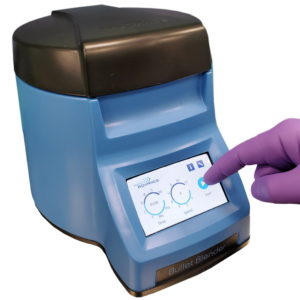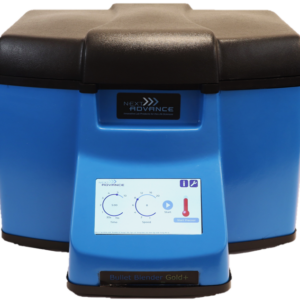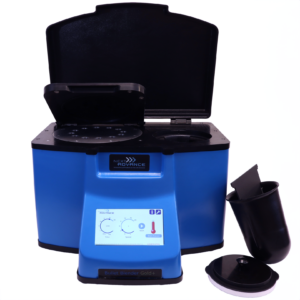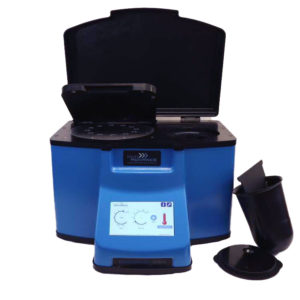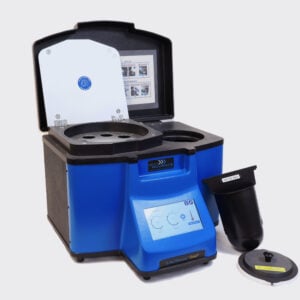Ideal for Lung Tissue Homogenization
Do you spend lots of time and effort homogenizing Lung tissue samples? The Bullet Blender® tissue homogenizer delivers high quality and superior yields. No other homogenizer comes close to delivering the Bullet Blender’s winning combination of top-quality performance and budget-friendly affordability. See below for a Lung tissue homogenization protocol.
Save Time, Effort and Get Superior Results with
The Bullet Blender Homogenizer
Consistent and High Yield Results
Run up to 24 samples at the same time under microprocessor-controlled conditions, ensuring experimental reproducibility and high yield. Process samples from 10mg or less up to 3.5g.No Cross Contamination
No part of the Bullet Blender ever touches the tissue – the sample tubes are kept closed during homogenization. There are no probes to clean between samples.Samples Stay Cool
The Bullet Blenders’ innovative and elegant design provides convective cooling of the samples, so they do not heat up more than several degrees. In fact, our Gold+ models hold the sample temperature to about 4ºC.Easy and Convenient to Use
Just place beads and buffer along with your tissue sample in standard tubes, load tubes directly in the Bullet Blender, select time and speed, and press start.Risk Free Purchase
Thousands of peer-reviewed journal articles attest to the consistency and quality of the Bullet Blender homogenizer. We offer a 2 year warranty, extendable to 4 years, because our Bullet Blenders are reliable and last for many years.Lung Tissue Homogenization Protocol
Sample size |
See the Protocol |
| microcentrifuge tube model (up to 300 mg) | Small lung samples |
| 5mL tube model (100mg - 1g) | Medium lung samples |
| 50mL tube model (100mg - 3.5g) | Large lung samples |
What Else Can You Homogenize? Tough or Soft, No Problem!
The Bullet Blender can process a wide range of samples including organ tissue, cell culture, plant tissue, and small organisms. You can homogenize samples as tough as mouse femur or for gentle applications such as tissue dissociation or organelle isolation.
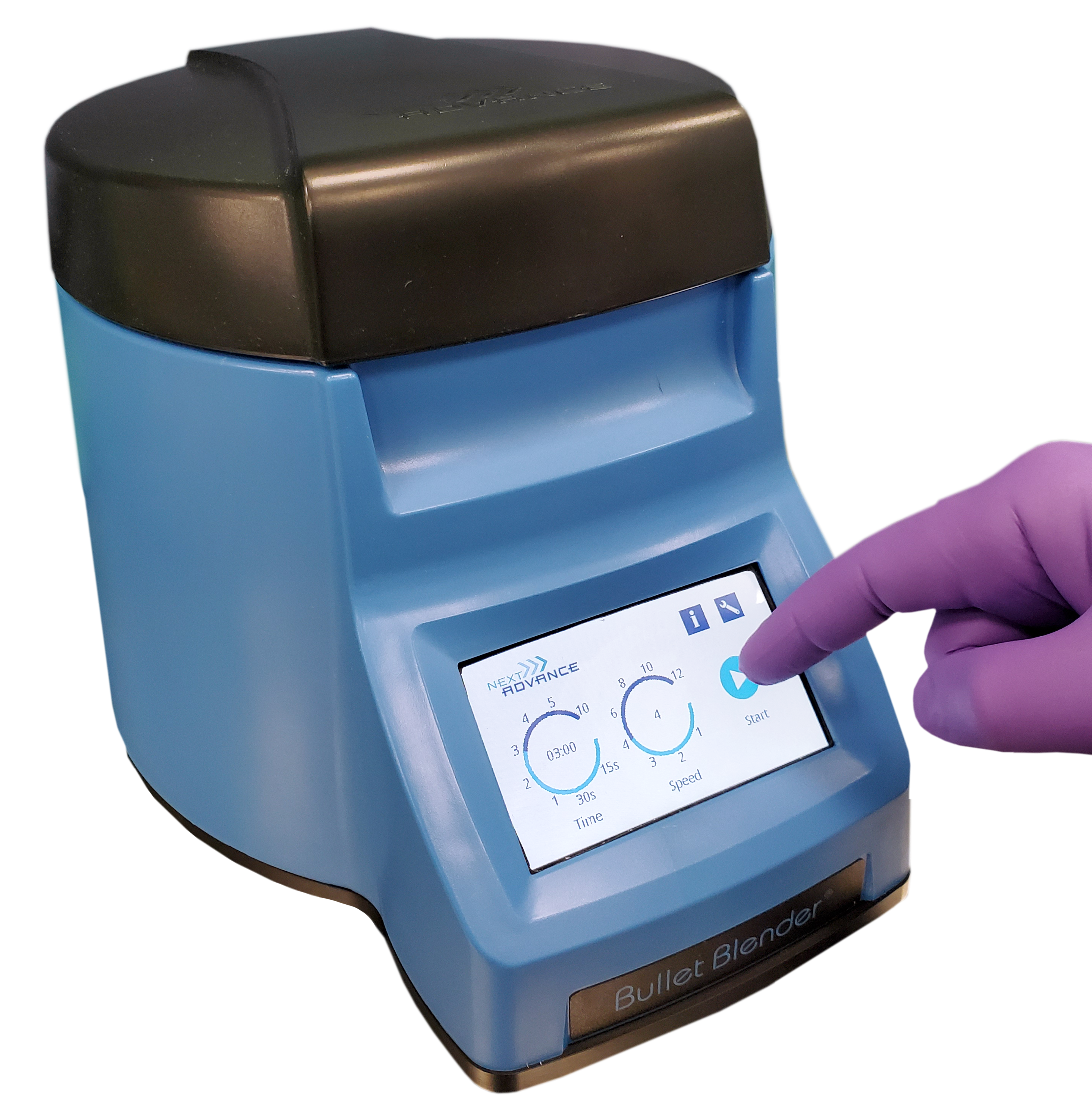


Lung tissue pieces (on beads in upper photo) are completely homogenized into the buffer (slightly darker in lower photo).
Want more guidance? Need a quote? Contact us:
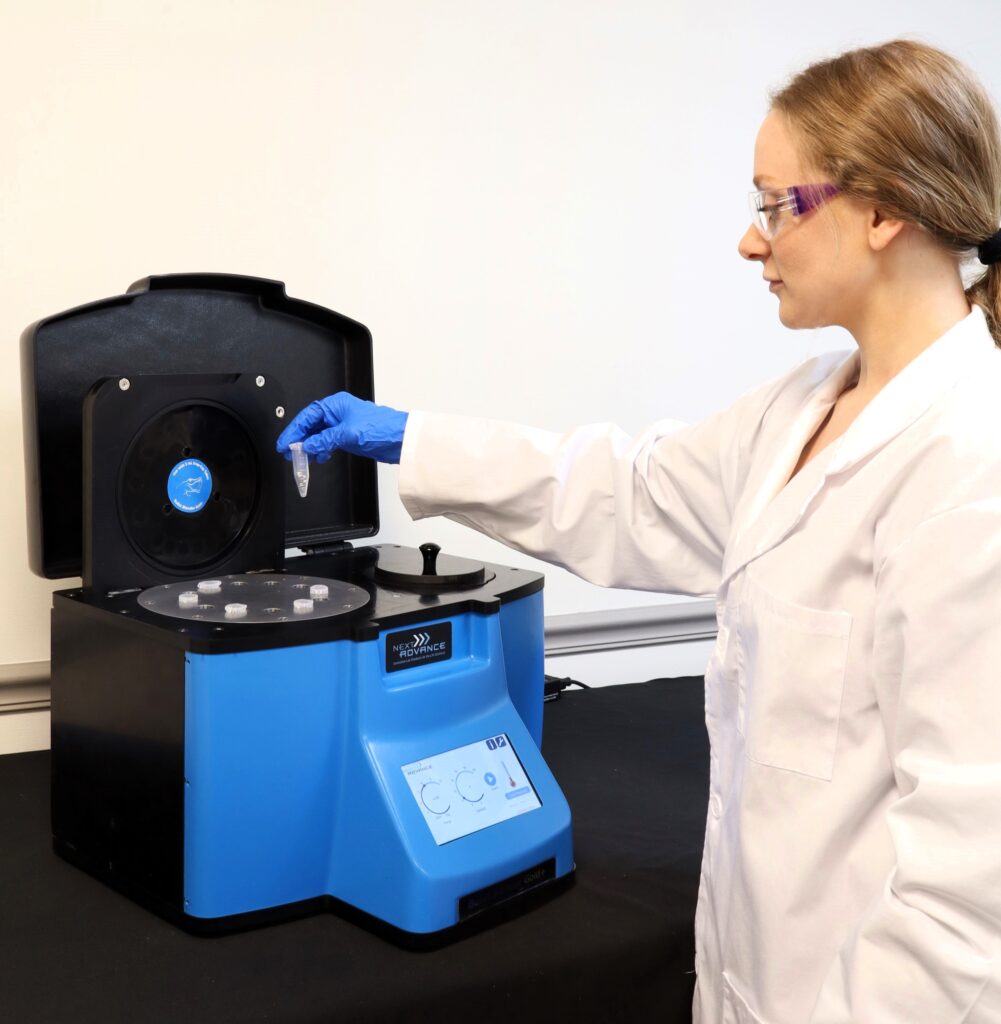
Bullet Blender Models
Select Publications using the Bullet Blender to Homogenize Lung Tissue
2474232
lung
1
apa
50
date
desc
3186
https://www.nextadvance.com/wp-content/plugins/zotpress/
%7B%22status%22%3A%22success%22%2C%22updateneeded%22%3Afalse%2C%22instance%22%3Afalse%2C%22meta%22%3A%7B%22request_last%22%3A50%2C%22request_next%22%3A50%2C%22used_cache%22%3Atrue%7D%2C%22data%22%3A%5B%7B%22key%22%3A%22DT6T59PN%22%2C%22library%22%3A%7B%22id%22%3A2474232%7D%2C%22meta%22%3A%7B%22creatorSummary%22%3A%22Li%20et%20al.%22%2C%22parsedDate%22%3A%222016-04-27%22%2C%22numChildren%22%3A2%7D%2C%22bib%22%3A%22%26lt%3Bdiv%20class%3D%26quot%3Bcsl-bib-body%26quot%3B%20style%3D%26quot%3Bline-height%3A%202%3B%20padding-left%3A%201em%3B%20text-indent%3A-1em%3B%26quot%3B%26gt%3B%5Cn%20%20%26lt%3Bdiv%20class%3D%26quot%3Bcsl-entry%26quot%3B%26gt%3BLi%2C%20M.%2C%20Li%2C%20C.%2C%20Song%2C%20S.%2C%20Kang%2C%20H.%2C%20Yang%2C%20D.%2C%20%26amp%3B%20Li%2C%20G.%20%282016%29.%20Development%20and%20antigenic%20characterization%20of%20three%20recombinant%20proteins%20with%20potential%20for%20Gl%26%23xE4%3Bsser%26%23x2019%3Bs%20disease%20prevention.%20%26lt%3Bi%26gt%3BVaccine%26lt%3B%5C%2Fi%26gt%3B%2C%20%26lt%3Bi%26gt%3B34%26lt%3B%5C%2Fi%26gt%3B%2819%29%2C%202251%26%23x2013%3B2258.%20%26lt%3Ba%20class%3D%26%23039%3Bzp-DOIURL%26%23039%3B%20href%3D%26%23039%3Bhttps%3A%5C%2F%5C%2Fdoi.org%5C%2F10.1016%5C%2Fj.vaccine.2016.03.014%26%23039%3B%26gt%3Bhttps%3A%5C%2F%5C%2Fdoi.org%5C%2F10.1016%5C%2Fj.vaccine.2016.03.014%26lt%3B%5C%2Fa%26gt%3B%26lt%3B%5C%2Fdiv%26gt%3B%5Cn%26lt%3B%5C%2Fdiv%26gt%3B%22%2C%22data%22%3A%7B%22itemType%22%3A%22journalArticle%22%2C%22title%22%3A%22Development%20and%20antigenic%20characterization%20of%20three%20recombinant%20proteins%20with%20potential%20for%20Gl%5Cu00e4sser%27s%20disease%20prevention%22%2C%22creators%22%3A%5B%7B%22creatorType%22%3A%22author%22%2C%22firstName%22%3A%22Miao%22%2C%22lastName%22%3A%22Li%22%7D%2C%7B%22creatorType%22%3A%22author%22%2C%22firstName%22%3A%22Chunling%22%2C%22lastName%22%3A%22Li%22%7D%2C%7B%22creatorType%22%3A%22author%22%2C%22firstName%22%3A%22Shuai%22%2C%22lastName%22%3A%22Song%22%7D%2C%7B%22creatorType%22%3A%22author%22%2C%22firstName%22%3A%22Huahua%22%2C%22lastName%22%3A%22Kang%22%7D%2C%7B%22creatorType%22%3A%22author%22%2C%22firstName%22%3A%22Dongxia%22%2C%22lastName%22%3A%22Yang%22%7D%2C%7B%22creatorType%22%3A%22author%22%2C%22firstName%22%3A%22Guoqing%22%2C%22lastName%22%3A%22Li%22%7D%5D%2C%22abstractNote%22%3A%22Haemophilus%20parasuis%20is%20the%20causative%20agent%20of%20Gl%5Cu00e4sser%26%23039%3Bs%20disease%2C%20which%20causes%20high%20morbidity%20and%20mortality%20in%20piglets%2C%20leading%20to%20severe%20economic%20losses.%20The%20lack%20of%20a%20commercial%20vaccine%20against%20a%20broad%20spectrum%20of%20strains%20has%20limited%20the%20disease%20control.%20H.%20parasuis%20outer%20membrane%20proteins%20%28OMPs%29%20are%20potentially%20essential%20components%20for%20vaccine%20formulation.%20In%20this%20study%2C%20seven%20putative%20OMPs%20were%20selected%20from%20the%20annotated%20H.%20parasuis%20serovar%205%20genome%3B%20they%20were%20predicted%20by%20bioinformatics%20and%20annotated%20as%20potential%20virulence-related%20factors.%20These%20proteins%20were%20cloned%2C%20expressed%2C%20and%20purified%20as%20His-tagged%20proteins.%20Antigenicity%20of%20the%20candidate%20proteins%20was%20assessed%20using%20Western%20blotting%20with%20convalescent%20sera%20against%20H.%20parasuis%20serovar%205.%20The%20immunogenicity%20of%20the%20seven%20OMPs%20was%20assessed%20in%20a%20guinea%20pig%20model.%20Except%20VacJ%2C%20all%20the%20other%20six%20recombinant%20proteins%20elicited%20a%20detectable%20antibody%20response.%20Antisera%20against%20four%20of%20the%20selected%20proteins%20effectively%20killed%20the%20bacteria%20in%20vitro.%20Three%20proteins%20%28Omp26%2C%20VacJ%2C%20and%20HAPS_0742%29%20were%20found%20to%20confer%20signi%5Cufb01cant%20protection%20against%20challenge%20with%20a%20lethal%20dose%20of%20H.%20parasuis%20in%20a%20guinea%20pig%20model.%20The%20results%20suggest%20that%20these%20three%20proteins%20have%20a%20strong%20potential%20to%20be%20vaccine%20candidates%20against%20Gl%5Cu00e4sser%26%23039%3Bs%20disease.%22%2C%22date%22%3A%22April%2027%2C%202016%22%2C%22language%22%3A%22%22%2C%22DOI%22%3A%2210.1016%5C%2Fj.vaccine.2016.03.014%22%2C%22ISSN%22%3A%220264-410X%22%2C%22url%22%3A%22http%3A%5C%2F%5C%2Fwww.sciencedirect.com%5C%2Fscience%5C%2Farticle%5C%2Fpii%5C%2FS0264410X16003145%22%2C%22collections%22%3A%5B%22M2MNG549%22%5D%2C%22dateModified%22%3A%222016-06-24T16%3A30%3A49Z%22%7D%7D%2C%7B%22key%22%3A%22WHU2R9PH%22%2C%22library%22%3A%7B%22id%22%3A2474232%7D%2C%22meta%22%3A%7B%22creatorSummary%22%3A%22Adamo%20et%20al.%22%2C%22parsedDate%22%3A%222016%22%2C%22numChildren%22%3A0%7D%2C%22bib%22%3A%22%26lt%3Bdiv%20class%3D%26quot%3Bcsl-bib-body%26quot%3B%20style%3D%26quot%3Bline-height%3A%202%3B%20padding-left%3A%201em%3B%20text-indent%3A-1em%3B%26quot%3B%26gt%3B%5Cn%20%20%26lt%3Bdiv%20class%3D%26quot%3Bcsl-entry%26quot%3B%26gt%3BAdamo%2C%20R.%20F.%2C%20Fishbein%2C%20I.%2C%20Zhang%2C%20K.%2C%20Wen%2C%20J.%2C%20Levy%2C%20R.%20J.%2C%20Alferiev%2C%20I.%20S.%2C%20%26amp%3B%20Chorny%2C%20M.%20%282016%29.%20Magnetically%20enhanced%20cell%20delivery%20for%20accelerating%20recovery%20of%20the%20endothelium%20in%20injured%20arteries.%20%26lt%3Bi%26gt%3BJournal%20of%20Controlled%20Release%26lt%3B%5C%2Fi%26gt%3B%2C%20%26lt%3Bi%26gt%3B222%26lt%3B%5C%2Fi%26gt%3B%2C%20169%26%23x2013%3B175.%20%26lt%3Ba%20class%3D%26%23039%3Bzp-DOIURL%26%23039%3B%20href%3D%26%23039%3Bhttps%3A%5C%2F%5C%2Fdoi.org%5C%2F10.1016%5C%2Fj.jconrel.2015.12.025%26%23039%3B%26gt%3Bhttps%3A%5C%2F%5C%2Fdoi.org%5C%2F10.1016%5C%2Fj.jconrel.2015.12.025%26lt%3B%5C%2Fa%26gt%3B%26lt%3B%5C%2Fdiv%26gt%3B%5Cn%26lt%3B%5C%2Fdiv%26gt%3B%22%2C%22data%22%3A%7B%22itemType%22%3A%22journalArticle%22%2C%22title%22%3A%22Magnetically%20enhanced%20cell%20delivery%20for%20accelerating%20recovery%20of%20the%20endothelium%20in%20injured%20arteries%22%2C%22creators%22%3A%5B%7B%22creatorType%22%3A%22author%22%2C%22firstName%22%3A%22Richard%20F.%22%2C%22lastName%22%3A%22Adamo%22%7D%2C%7B%22creatorType%22%3A%22author%22%2C%22firstName%22%3A%22Ilia%22%2C%22lastName%22%3A%22Fishbein%22%7D%2C%7B%22creatorType%22%3A%22author%22%2C%22firstName%22%3A%22Kehan%22%2C%22lastName%22%3A%22Zhang%22%7D%2C%7B%22creatorType%22%3A%22author%22%2C%22firstName%22%3A%22Justin%22%2C%22lastName%22%3A%22Wen%22%7D%2C%7B%22creatorType%22%3A%22author%22%2C%22firstName%22%3A%22Robert%20J.%22%2C%22lastName%22%3A%22Levy%22%7D%2C%7B%22creatorType%22%3A%22author%22%2C%22firstName%22%3A%22Ivan%20S.%22%2C%22lastName%22%3A%22Alferiev%22%7D%2C%7B%22creatorType%22%3A%22author%22%2C%22firstName%22%3A%22Michael%22%2C%22lastName%22%3A%22Chorny%22%7D%5D%2C%22abstractNote%22%3A%22%22%2C%22date%22%3A%2201%5C%2F2016%22%2C%22language%22%3A%22en%22%2C%22DOI%22%3A%2210.1016%5C%2Fj.jconrel.2015.12.025%22%2C%22ISSN%22%3A%2201683659%22%2C%22url%22%3A%22http%3A%5C%2F%5C%2Flinkinghub.elsevier.com%5C%2Fretrieve%5C%2Fpii%5C%2FS0168365915302777%22%2C%22collections%22%3A%5B%22M2MNG549%22%5D%2C%22dateModified%22%3A%222015-12-31T19%3A10%3A51Z%22%7D%7D%2C%7B%22key%22%3A%22Z7ZVFVCD%22%2C%22library%22%3A%7B%22id%22%3A2474232%7D%2C%22meta%22%3A%7B%22creatorSummary%22%3A%22Bawadekar%20et%20al.%22%2C%22parsedDate%22%3A%222016%22%2C%22numChildren%22%3A2%7D%2C%22bib%22%3A%22%26lt%3Bdiv%20class%3D%26quot%3Bcsl-bib-body%26quot%3B%20style%3D%26quot%3Bline-height%3A%202%3B%20padding-left%3A%201em%3B%20text-indent%3A-1em%3B%26quot%3B%26gt%3B%5Cn%20%20%26lt%3Bdiv%20class%3D%26quot%3Bcsl-entry%26quot%3B%26gt%3BBawadekar%2C%20M.%2C%20Gendron-Fitzpatrick%2C%20A.%2C%20Rebernick%2C%20R.%2C%20Shim%2C%20D.%2C%20Warner%2C%20T.%20F.%2C%20Nicholas%2C%20A.%20P.%2C%20Lundblad%2C%20L.%20K.%20A.%2C%20Thompson%2C%20P.%20R.%2C%20%26amp%3B%20Shelef%2C%20M.%20A.%20%282016%29.%20Tumor%20necrosis%20factor%20alpha%2C%20citrullination%2C%20and%20peptidylarginine%20deiminase%204%20in%20lung%20and%20joint%20inflammation.%20%26lt%3Bi%26gt%3BArthritis%20Research%20%26amp%3B%20Therapy%26lt%3B%5C%2Fi%26gt%3B%2C%20%26lt%3Bi%26gt%3B18%26lt%3B%5C%2Fi%26gt%3B%2C%20173.%20%26lt%3Ba%20class%3D%26%23039%3Bzp-DOIURL%26%23039%3B%20href%3D%26%23039%3Bhttps%3A%5C%2F%5C%2Fdoi.org%5C%2F10.1186%5C%2Fs13075-016-1068-0%26%23039%3B%26gt%3Bhttps%3A%5C%2F%5C%2Fdoi.org%5C%2F10.1186%5C%2Fs13075-016-1068-0%26lt%3B%5C%2Fa%26gt%3B%26lt%3B%5C%2Fdiv%26gt%3B%5Cn%26lt%3B%5C%2Fdiv%26gt%3B%22%2C%22data%22%3A%7B%22itemType%22%3A%22journalArticle%22%2C%22title%22%3A%22Tumor%20necrosis%20factor%20alpha%2C%20citrullination%2C%20and%20peptidylarginine%20deiminase%204%20in%20lung%20and%20joint%20inflammation%22%2C%22creators%22%3A%5B%7B%22creatorType%22%3A%22author%22%2C%22firstName%22%3A%22Mandar%22%2C%22lastName%22%3A%22Bawadekar%22%7D%2C%7B%22creatorType%22%3A%22author%22%2C%22firstName%22%3A%22Annette%22%2C%22lastName%22%3A%22Gendron-Fitzpatrick%22%7D%2C%7B%22creatorType%22%3A%22author%22%2C%22firstName%22%3A%22Ryan%22%2C%22lastName%22%3A%22Rebernick%22%7D%2C%7B%22creatorType%22%3A%22author%22%2C%22firstName%22%3A%22Daeun%22%2C%22lastName%22%3A%22Shim%22%7D%2C%7B%22creatorType%22%3A%22author%22%2C%22firstName%22%3A%22Thomas%20F.%22%2C%22lastName%22%3A%22Warner%22%7D%2C%7B%22creatorType%22%3A%22author%22%2C%22firstName%22%3A%22Anthony%20P.%22%2C%22lastName%22%3A%22Nicholas%22%7D%2C%7B%22creatorType%22%3A%22author%22%2C%22firstName%22%3A%22Lennart%20K.%20A.%22%2C%22lastName%22%3A%22Lundblad%22%7D%2C%7B%22creatorType%22%3A%22author%22%2C%22firstName%22%3A%22Paul%20R.%22%2C%22lastName%22%3A%22Thompson%22%7D%2C%7B%22creatorType%22%3A%22author%22%2C%22firstName%22%3A%22Miriam%20A.%22%2C%22lastName%22%3A%22Shelef%22%7D%5D%2C%22abstractNote%22%3A%22The%20relationship%20between%20lung%20and%20joint%20inflammation%20in%20rheumatoid%20arthritis%20is%20poorly%20understood.%20Lung%20inflammation%20with%20resultant%20protein%20citrullination%20may%20trigger%20anti-citrullinated%20protein%20antibodies%2C%20inflammation%2C%20and%20arthritis.%20Alternatively%2C%20lung%20and%20joint%20inflammation%20may%20be%20two%20manifestations%20of%20a%20single%20underlying%20pathology.%20The%20lung%20has%20increased%20citrullination%20and%20TNF-%5Cu03b1%20levels%20are%20high%20in%20rheumatoid%20arthritis%3B%20however%2C%20it%20is%20unknown%20if%20TNF-%5Cu03b1%20can%20induce%20lung%20protein%20citrullination.%20The%20citrullinating%20enzyme%20peptidylarginine%20deiminase%204%20%28PAD4%29%20exacerbates%20TNF-%5Cu03b1-induced%20arthritis%2C%20but%20a%20role%20for%20PAD4%20in%20lung%20citrullination%20and%20TNF-%5Cu03b1-induced%20lung%20inflammation%20has%20not%20been%20explored.%20Our%20aim%20was%20to%20use%20TNF-%5Cu03b1-overexpressing%20mice%20to%20clarify%20the%20intersection%20of%20TNF-%5Cu03b1%2C%20citrullination%2C%20PAD4%2C%20arthritis%2C%20and%20lung%20inflammation.%22%2C%22date%22%3A%222016%22%2C%22language%22%3A%22%22%2C%22DOI%22%3A%2210.1186%5C%2Fs13075-016-1068-0%22%2C%22ISSN%22%3A%221478-6362%22%2C%22url%22%3A%22http%3A%5C%2F%5C%2Fdx.doi.org%5C%2F10.1186%5C%2Fs13075-016-1068-0%22%2C%22collections%22%3A%5B%22AXR6XH2M%22%5D%2C%22dateModified%22%3A%222016-12-22T17%3A10%3A51Z%22%7D%7D%2C%7B%22key%22%3A%22SK8KCHX9%22%2C%22library%22%3A%7B%22id%22%3A2474232%7D%2C%22meta%22%3A%7B%22creatorSummary%22%3A%22Hajkova%20et%20al.%22%2C%22parsedDate%22%3A%222015-12-11%22%2C%22numChildren%22%3A0%7D%2C%22bib%22%3A%22%26lt%3Bdiv%20class%3D%26quot%3Bcsl-bib-body%26quot%3B%20style%3D%26quot%3Bline-height%3A%202%3B%20padding-left%3A%201em%3B%20text-indent%3A-1em%3B%26quot%3B%26gt%3B%5Cn%20%20%26lt%3Bdiv%20class%3D%26quot%3Bcsl-entry%26quot%3B%26gt%3BHajkova%2C%20K.%2C%20Jurasek%2C%20B.%2C%20Sykora%2C%20D.%2C%20Palenicek%2C%20T.%2C%20Miksatkova%2C%20P.%2C%20%26amp%3B%20Kuchar%2C%20M.%20%282015%29.%20Salting-out-assisted%20liquid%26%23x2013%3Bliquid%20extraction%20as%20a%20suitable%20approach%20for%20determination%20of%20methoxetamine%20in%20large%20sets%20of%20tissue%20samples.%20%26lt%3Bi%26gt%3BAnalytical%20and%20Bioanalytical%20Chemistry%26lt%3B%5C%2Fi%26gt%3B.%20%26lt%3Ba%20class%3D%26%23039%3Bzp-DOIURL%26%23039%3B%20href%3D%26%23039%3Bhttps%3A%5C%2F%5C%2Fdoi.org%5C%2F10.1007%5C%2Fs00216-015-9221-1%26%23039%3B%26gt%3Bhttps%3A%5C%2F%5C%2Fdoi.org%5C%2F10.1007%5C%2Fs00216-015-9221-1%26lt%3B%5C%2Fa%26gt%3B%26lt%3B%5C%2Fdiv%26gt%3B%5Cn%26lt%3B%5C%2Fdiv%26gt%3B%22%2C%22data%22%3A%7B%22itemType%22%3A%22journalArticle%22%2C%22title%22%3A%22Salting-out-assisted%20liquid%5Cu2013liquid%20extraction%20as%20a%20suitable%20approach%20for%20determination%20of%20methoxetamine%20in%20large%20sets%20of%20tissue%20samples%22%2C%22creators%22%3A%5B%7B%22creatorType%22%3A%22author%22%2C%22firstName%22%3A%22Katerina%22%2C%22lastName%22%3A%22Hajkova%22%7D%2C%7B%22creatorType%22%3A%22author%22%2C%22firstName%22%3A%22Bronislav%22%2C%22lastName%22%3A%22Jurasek%22%7D%2C%7B%22creatorType%22%3A%22author%22%2C%22firstName%22%3A%22David%22%2C%22lastName%22%3A%22Sykora%22%7D%2C%7B%22creatorType%22%3A%22author%22%2C%22firstName%22%3A%22Tomas%22%2C%22lastName%22%3A%22Palenicek%22%7D%2C%7B%22creatorType%22%3A%22author%22%2C%22firstName%22%3A%22Petra%22%2C%22lastName%22%3A%22Miksatkova%22%7D%2C%7B%22creatorType%22%3A%22author%22%2C%22firstName%22%3A%22Martin%22%2C%22lastName%22%3A%22Kuchar%22%7D%5D%2C%22abstractNote%22%3A%22%22%2C%22date%22%3A%222015-12-11%22%2C%22language%22%3A%22en%22%2C%22DOI%22%3A%2210.1007%5C%2Fs00216-015-9221-1%22%2C%22ISSN%22%3A%221618-2642%2C%201618-2650%22%2C%22url%22%3A%22http%3A%5C%2F%5C%2Flink.springer.com%5C%2F10.1007%5C%2Fs00216-015-9221-1%22%2C%22collections%22%3A%5B%22M2MNG549%22%5D%2C%22dateModified%22%3A%222015-12-30T16%3A26%3A54Z%22%7D%7D%2C%7B%22key%22%3A%22VUD8PW3Z%22%2C%22library%22%3A%7B%22id%22%3A2474232%7D%2C%22meta%22%3A%7B%22creatorSummary%22%3A%22Ruhaak%20et%20al.%22%2C%22parsedDate%22%3A%222015-11-06%22%2C%22numChildren%22%3A0%7D%2C%22bib%22%3A%22%26lt%3Bdiv%20class%3D%26quot%3Bcsl-bib-body%26quot%3B%20style%3D%26quot%3Bline-height%3A%202%3B%20padding-left%3A%201em%3B%20text-indent%3A-1em%3B%26quot%3B%26gt%3B%5Cn%20%20%26lt%3Bdiv%20class%3D%26quot%3Bcsl-entry%26quot%3B%26gt%3BRuhaak%2C%20L.%20R.%2C%20Taylor%2C%20S.%20L.%2C%20Stroble%2C%20C.%2C%20Nguyen%2C%20U.%20T.%2C%20Parker%2C%20E.%20A.%2C%20Song%2C%20T.%2C%20Lebrilla%2C%20C.%20B.%2C%20Rom%2C%20W.%20N.%2C%20Pass%2C%20H.%2C%20Kim%2C%20K.%2C%20Kelly%2C%20K.%2C%20%26amp%3B%20Miyamoto%2C%20S.%20%282015%29.%20Differential%20N-Glycosylation%20Patterns%20in%20Lung%20Adenocarcinoma%20Tissue.%20%26lt%3Bi%26gt%3BJournal%20of%20Proteome%20Research%26lt%3B%5C%2Fi%26gt%3B%2C%20%26lt%3Bi%26gt%3B14%26lt%3B%5C%2Fi%26gt%3B%2811%29%2C%204538%26%23x2013%3B4549.%20%26lt%3Ba%20class%3D%26%23039%3Bzp-DOIURL%26%23039%3B%20href%3D%26%23039%3Bhttps%3A%5C%2F%5C%2Fdoi.org%5C%2F10.1021%5C%2Facs.jproteome.5b00255%26%23039%3B%26gt%3Bhttps%3A%5C%2F%5C%2Fdoi.org%5C%2F10.1021%5C%2Facs.jproteome.5b00255%26lt%3B%5C%2Fa%26gt%3B%26lt%3B%5C%2Fdiv%26gt%3B%5Cn%26lt%3B%5C%2Fdiv%26gt%3B%22%2C%22data%22%3A%7B%22itemType%22%3A%22journalArticle%22%2C%22title%22%3A%22Differential%20N-Glycosylation%20Patterns%20in%20Lung%20Adenocarcinoma%20Tissue%22%2C%22creators%22%3A%5B%7B%22creatorType%22%3A%22author%22%2C%22firstName%22%3A%22L.%20Renee%22%2C%22lastName%22%3A%22Ruhaak%22%7D%2C%7B%22creatorType%22%3A%22author%22%2C%22firstName%22%3A%22Sandra%20L.%22%2C%22lastName%22%3A%22Taylor%22%7D%2C%7B%22creatorType%22%3A%22author%22%2C%22firstName%22%3A%22Carol%22%2C%22lastName%22%3A%22Stroble%22%7D%2C%7B%22creatorType%22%3A%22author%22%2C%22firstName%22%3A%22Uyen%20Thao%22%2C%22lastName%22%3A%22Nguyen%22%7D%2C%7B%22creatorType%22%3A%22author%22%2C%22firstName%22%3A%22Evan%20A.%22%2C%22lastName%22%3A%22Parker%22%7D%2C%7B%22creatorType%22%3A%22author%22%2C%22firstName%22%3A%22Ting%22%2C%22lastName%22%3A%22Song%22%7D%2C%7B%22creatorType%22%3A%22author%22%2C%22firstName%22%3A%22Carlito%20B.%22%2C%22lastName%22%3A%22Lebrilla%22%7D%2C%7B%22creatorType%22%3A%22author%22%2C%22firstName%22%3A%22William%20N.%22%2C%22lastName%22%3A%22Rom%22%7D%2C%7B%22creatorType%22%3A%22author%22%2C%22firstName%22%3A%22Harvey%22%2C%22lastName%22%3A%22Pass%22%7D%2C%7B%22creatorType%22%3A%22author%22%2C%22firstName%22%3A%22Kyoungmi%22%2C%22lastName%22%3A%22Kim%22%7D%2C%7B%22creatorType%22%3A%22author%22%2C%22firstName%22%3A%22Karen%22%2C%22lastName%22%3A%22Kelly%22%7D%2C%7B%22creatorType%22%3A%22author%22%2C%22firstName%22%3A%22Suzanne%22%2C%22lastName%22%3A%22Miyamoto%22%7D%5D%2C%22abstractNote%22%3A%22%22%2C%22date%22%3A%222015-11-06%22%2C%22language%22%3A%22en%22%2C%22DOI%22%3A%2210.1021%5C%2Facs.jproteome.5b00255%22%2C%22ISSN%22%3A%221535-3893%2C%201535-3907%22%2C%22url%22%3A%22http%3A%5C%2F%5C%2Fpubs.acs.org%5C%2Fdoi%5C%2F10.1021%5C%2Facs.jproteome.5b00255%22%2C%22collections%22%3A%5B%22M2MNG549%22%5D%2C%22dateModified%22%3A%222015-12-30T18%3A36%3A49Z%22%7D%7D%2C%7B%22key%22%3A%22EUVQTK9R%22%2C%22library%22%3A%7B%22id%22%3A2474232%7D%2C%22meta%22%3A%7B%22creatorSummary%22%3A%22Falendysz%20et%20al.%22%2C%22parsedDate%22%3A%222015-10-30%22%2C%22numChildren%22%3A0%7D%2C%22bib%22%3A%22%26lt%3Bdiv%20class%3D%26quot%3Bcsl-bib-body%26quot%3B%20style%3D%26quot%3Bline-height%3A%202%3B%20padding-left%3A%201em%3B%20text-indent%3A-1em%3B%26quot%3B%26gt%3B%5Cn%20%20%26lt%3Bdiv%20class%3D%26quot%3Bcsl-entry%26quot%3B%26gt%3BFalendysz%2C%20E.%20A.%2C%20Lopera%2C%20J.%20G.%2C%20Lorenzsonn%2C%20F.%2C%20Salzer%2C%20J.%20S.%2C%20Hutson%2C%20C.%20L.%2C%20Doty%2C%20J.%2C%20Gallardo-Romero%2C%20N.%2C%20Carroll%2C%20D.%20S.%2C%20Osorio%2C%20J.%20E.%2C%20%26amp%3B%20Rocke%2C%20T.%20E.%20%282015%29.%20Further%20Assessment%20of%20Monkeypox%20Virus%20Infection%20in%20Gambian%20Pouched%20Rats%20%28Cricetomys%20gambianus%29%20Using%20In%20Vivo%20Bioluminescent%20Imaging.%20%26lt%3Bi%26gt%3BPLOS%20Neglected%20Tropical%20Diseases%26lt%3B%5C%2Fi%26gt%3B%2C%20%26lt%3Bi%26gt%3B9%26lt%3B%5C%2Fi%26gt%3B%2810%29%2C%20e0004130.%20%26lt%3Ba%20class%3D%26%23039%3Bzp-DOIURL%26%23039%3B%20href%3D%26%23039%3Bhttps%3A%5C%2F%5C%2Fdoi.org%5C%2F10.1371%5C%2Fjournal.pntd.0004130%26%23039%3B%26gt%3Bhttps%3A%5C%2F%5C%2Fdoi.org%5C%2F10.1371%5C%2Fjournal.pntd.0004130%26lt%3B%5C%2Fa%26gt%3B%26lt%3B%5C%2Fdiv%26gt%3B%5Cn%26lt%3B%5C%2Fdiv%26gt%3B%22%2C%22data%22%3A%7B%22itemType%22%3A%22journalArticle%22%2C%22title%22%3A%22Further%20Assessment%20of%20Monkeypox%20Virus%20Infection%20in%20Gambian%20Pouched%20Rats%20%28Cricetomys%20gambianus%29%20Using%20In%20Vivo%20Bioluminescent%20Imaging%22%2C%22creators%22%3A%5B%7B%22creatorType%22%3A%22author%22%2C%22firstName%22%3A%22Elizabeth%20A.%22%2C%22lastName%22%3A%22Falendysz%22%7D%2C%7B%22creatorType%22%3A%22author%22%2C%22firstName%22%3A%22Juan%20G.%22%2C%22lastName%22%3A%22Lopera%22%7D%2C%7B%22creatorType%22%3A%22author%22%2C%22firstName%22%3A%22Faye%22%2C%22lastName%22%3A%22Lorenzsonn%22%7D%2C%7B%22creatorType%22%3A%22author%22%2C%22firstName%22%3A%22Johanna%20S.%22%2C%22lastName%22%3A%22Salzer%22%7D%2C%7B%22creatorType%22%3A%22author%22%2C%22firstName%22%3A%22Christina%20L.%22%2C%22lastName%22%3A%22Hutson%22%7D%2C%7B%22creatorType%22%3A%22author%22%2C%22firstName%22%3A%22Jeffrey%22%2C%22lastName%22%3A%22Doty%22%7D%2C%7B%22creatorType%22%3A%22author%22%2C%22firstName%22%3A%22Nadia%22%2C%22lastName%22%3A%22Gallardo-Romero%22%7D%2C%7B%22creatorType%22%3A%22author%22%2C%22firstName%22%3A%22Darin%20S.%22%2C%22lastName%22%3A%22Carroll%22%7D%2C%7B%22creatorType%22%3A%22author%22%2C%22firstName%22%3A%22Jorge%20E.%22%2C%22lastName%22%3A%22Osorio%22%7D%2C%7B%22creatorType%22%3A%22author%22%2C%22firstName%22%3A%22Tonie%20E.%22%2C%22lastName%22%3A%22Rocke%22%7D%2C%7B%22creatorType%22%3A%22editor%22%2C%22firstName%22%3A%22A.%20Desiree%22%2C%22lastName%22%3A%22LaBeaud%22%7D%5D%2C%22abstractNote%22%3A%22%22%2C%22date%22%3A%222015-10-30%22%2C%22language%22%3A%22en%22%2C%22DOI%22%3A%2210.1371%5C%2Fjournal.pntd.0004130%22%2C%22ISSN%22%3A%221935-2735%22%2C%22url%22%3A%22http%3A%5C%2F%5C%2Fdx.plos.org%5C%2F10.1371%5C%2Fjournal.pntd.0004130%22%2C%22collections%22%3A%5B%22M2MNG549%22%5D%2C%22dateModified%22%3A%222015-12-31T20%3A36%3A31Z%22%7D%7D%2C%7B%22key%22%3A%22JVCBR7GD%22%2C%22library%22%3A%7B%22id%22%3A2474232%7D%2C%22meta%22%3A%7B%22creatorSummary%22%3A%22McKenna%20et%20al.%22%2C%22parsedDate%22%3A%222015-10-15%22%2C%22numChildren%22%3A0%7D%2C%22bib%22%3A%22%26lt%3Bdiv%20class%3D%26quot%3Bcsl-bib-body%26quot%3B%20style%3D%26quot%3Bline-height%3A%202%3B%20padding-left%3A%201em%3B%20text-indent%3A-1em%3B%26quot%3B%26gt%3B%5Cn%20%20%26lt%3Bdiv%20class%3D%26quot%3Bcsl-entry%26quot%3B%26gt%3BMcKenna%2C%20S.%2C%20Gossling%2C%20M.%2C%20Bugarini%2C%20A.%2C%20Hill%2C%20E.%2C%20Anderson%2C%20A.%20L.%2C%20Rancourt%2C%20R.%20C.%2C%20Balasubramaniyan%2C%20N.%2C%20El%20Kasmi%2C%20K.%20C.%2C%20%26amp%3B%20Wright%2C%20C.%20J.%20%282015%29.%20Endotoxemia%20Induces%20I%20B%20%5C%2FNF-%20B-Dependent%20Endothelin-1%20Expression%20in%20Hepatic%20Macrophages.%20%26lt%3Bi%26gt%3BThe%20Journal%20of%20Immunology%26lt%3B%5C%2Fi%26gt%3B%2C%20%26lt%3Bi%26gt%3B195%26lt%3B%5C%2Fi%26gt%3B%288%29%2C%203866%26%23x2013%3B3879.%20%26lt%3Ba%20class%3D%26%23039%3Bzp-DOIURL%26%23039%3B%20href%3D%26%23039%3Bhttps%3A%5C%2F%5C%2Fdoi.org%5C%2F10.4049%5C%2Fjimmunol.1501017%26%23039%3B%26gt%3Bhttps%3A%5C%2F%5C%2Fdoi.org%5C%2F10.4049%5C%2Fjimmunol.1501017%26lt%3B%5C%2Fa%26gt%3B%26lt%3B%5C%2Fdiv%26gt%3B%5Cn%26lt%3B%5C%2Fdiv%26gt%3B%22%2C%22data%22%3A%7B%22itemType%22%3A%22journalArticle%22%2C%22title%22%3A%22Endotoxemia%20Induces%20I%20B%20%5C%2FNF-%20B-Dependent%20Endothelin-1%20Expression%20in%20Hepatic%20Macrophages%22%2C%22creators%22%3A%5B%7B%22creatorType%22%3A%22author%22%2C%22firstName%22%3A%22S.%22%2C%22lastName%22%3A%22McKenna%22%7D%2C%7B%22creatorType%22%3A%22author%22%2C%22firstName%22%3A%22M.%22%2C%22lastName%22%3A%22Gossling%22%7D%2C%7B%22creatorType%22%3A%22author%22%2C%22firstName%22%3A%22A.%22%2C%22lastName%22%3A%22Bugarini%22%7D%2C%7B%22creatorType%22%3A%22author%22%2C%22firstName%22%3A%22E.%22%2C%22lastName%22%3A%22Hill%22%7D%2C%7B%22creatorType%22%3A%22author%22%2C%22firstName%22%3A%22A.%20L.%22%2C%22lastName%22%3A%22Anderson%22%7D%2C%7B%22creatorType%22%3A%22author%22%2C%22firstName%22%3A%22R.%20C.%22%2C%22lastName%22%3A%22Rancourt%22%7D%2C%7B%22creatorType%22%3A%22author%22%2C%22firstName%22%3A%22N.%22%2C%22lastName%22%3A%22Balasubramaniyan%22%7D%2C%7B%22creatorType%22%3A%22author%22%2C%22firstName%22%3A%22K.%20C.%22%2C%22lastName%22%3A%22El%20Kasmi%22%7D%2C%7B%22creatorType%22%3A%22author%22%2C%22firstName%22%3A%22C.%20J.%22%2C%22lastName%22%3A%22Wright%22%7D%5D%2C%22abstractNote%22%3A%22%22%2C%22date%22%3A%222015-10-15%22%2C%22language%22%3A%22en%22%2C%22DOI%22%3A%2210.4049%5C%2Fjimmunol.1501017%22%2C%22ISSN%22%3A%220022-1767%2C%201550-6606%22%2C%22url%22%3A%22http%3A%5C%2F%5C%2Fwww.jimmunol.org%5C%2Fcgi%5C%2Fdoi%5C%2F10.4049%5C%2Fjimmunol.1501017%22%2C%22collections%22%3A%5B%22M2MNG549%22%5D%2C%22dateModified%22%3A%222015-12-30T14%3A57%3A57Z%22%7D%7D%2C%7B%22key%22%3A%22F8XWNI8G%22%2C%22library%22%3A%7B%22id%22%3A2474232%7D%2C%22meta%22%3A%7B%22creatorSummary%22%3A%22Marien%20et%20al.%22%2C%22parsedDate%22%3A%222015-10-01%22%2C%22numChildren%22%3A0%7D%2C%22bib%22%3A%22%26lt%3Bdiv%20class%3D%26quot%3Bcsl-bib-body%26quot%3B%20style%3D%26quot%3Bline-height%3A%202%3B%20padding-left%3A%201em%3B%20text-indent%3A-1em%3B%26quot%3B%26gt%3B%5Cn%20%20%26lt%3Bdiv%20class%3D%26quot%3Bcsl-entry%26quot%3B%26gt%3BMarien%2C%20E.%2C%20Meister%2C%20M.%2C%20Muley%2C%20T.%2C%20Fieuws%2C%20S.%2C%20Bordel%2C%20S.%2C%20Derua%2C%20R.%2C%20Spraggins%2C%20J.%2C%20Van%20de%20Plas%2C%20R.%2C%20Dehairs%2C%20J.%2C%20Wouters%2C%20J.%2C%20Bagadi%2C%20M.%2C%20Dienemann%2C%20H.%2C%20Thomas%2C%20M.%2C%20Schnabel%2C%20P.%20A.%2C%20Caprioli%2C%20R.%20M.%2C%20Waelkens%2C%20E.%2C%20%26amp%3B%20Swinnen%2C%20J.%20V.%20%282015%29.%20Non-small%20cell%20lung%20cancer%20is%20characterized%20by%20dramatic%20changes%20in%20phospholipid%20profiles%3A%20Altered%20Phospholipid%20Profiles%20in%20NSCLC.%20%26lt%3Bi%26gt%3BInternational%20Journal%20of%20Cancer%26lt%3B%5C%2Fi%26gt%3B%2C%20%26lt%3Bi%26gt%3B137%26lt%3B%5C%2Fi%26gt%3B%287%29%2C%201539%26%23x2013%3B1548.%20%26lt%3Ba%20class%3D%26%23039%3Bzp-DOIURL%26%23039%3B%20href%3D%26%23039%3Bhttps%3A%5C%2F%5C%2Fdoi.org%5C%2F10.1002%5C%2Fijc.29517%26%23039%3B%26gt%3Bhttps%3A%5C%2F%5C%2Fdoi.org%5C%2F10.1002%5C%2Fijc.29517%26lt%3B%5C%2Fa%26gt%3B%26lt%3B%5C%2Fdiv%26gt%3B%5Cn%26lt%3B%5C%2Fdiv%26gt%3B%22%2C%22data%22%3A%7B%22itemType%22%3A%22journalArticle%22%2C%22title%22%3A%22Non-small%20cell%20lung%20cancer%20is%20characterized%20by%20dramatic%20changes%20in%20phospholipid%20profiles%3A%20Altered%20Phospholipid%20Profiles%20in%20NSCLC%22%2C%22creators%22%3A%5B%7B%22creatorType%22%3A%22author%22%2C%22firstName%22%3A%22Eyra%22%2C%22lastName%22%3A%22Marien%22%7D%2C%7B%22creatorType%22%3A%22author%22%2C%22firstName%22%3A%22Michael%22%2C%22lastName%22%3A%22Meister%22%7D%2C%7B%22creatorType%22%3A%22author%22%2C%22firstName%22%3A%22Thomas%22%2C%22lastName%22%3A%22Muley%22%7D%2C%7B%22creatorType%22%3A%22author%22%2C%22firstName%22%3A%22Steffen%22%2C%22lastName%22%3A%22Fieuws%22%7D%2C%7B%22creatorType%22%3A%22author%22%2C%22firstName%22%3A%22Sergio%22%2C%22lastName%22%3A%22Bordel%22%7D%2C%7B%22creatorType%22%3A%22author%22%2C%22firstName%22%3A%22Rita%22%2C%22lastName%22%3A%22Derua%22%7D%2C%7B%22creatorType%22%3A%22author%22%2C%22firstName%22%3A%22Jeffrey%22%2C%22lastName%22%3A%22Spraggins%22%7D%2C%7B%22creatorType%22%3A%22author%22%2C%22firstName%22%3A%22Raf%22%2C%22lastName%22%3A%22Van%20de%20Plas%22%7D%2C%7B%22creatorType%22%3A%22author%22%2C%22firstName%22%3A%22Jonas%22%2C%22lastName%22%3A%22Dehairs%22%7D%2C%7B%22creatorType%22%3A%22author%22%2C%22firstName%22%3A%22Jens%22%2C%22lastName%22%3A%22Wouters%22%7D%2C%7B%22creatorType%22%3A%22author%22%2C%22firstName%22%3A%22Muralidhararao%22%2C%22lastName%22%3A%22Bagadi%22%7D%2C%7B%22creatorType%22%3A%22author%22%2C%22firstName%22%3A%22Hendrik%22%2C%22lastName%22%3A%22Dienemann%22%7D%2C%7B%22creatorType%22%3A%22author%22%2C%22firstName%22%3A%22Michael%22%2C%22lastName%22%3A%22Thomas%22%7D%2C%7B%22creatorType%22%3A%22author%22%2C%22firstName%22%3A%22Philipp%20A.%22%2C%22lastName%22%3A%22Schnabel%22%7D%2C%7B%22creatorType%22%3A%22author%22%2C%22firstName%22%3A%22Richard%20M.%22%2C%22lastName%22%3A%22Caprioli%22%7D%2C%7B%22creatorType%22%3A%22author%22%2C%22firstName%22%3A%22Etienne%22%2C%22lastName%22%3A%22Waelkens%22%7D%2C%7B%22creatorType%22%3A%22author%22%2C%22firstName%22%3A%22Johannes%20V.%22%2C%22lastName%22%3A%22Swinnen%22%7D%5D%2C%22abstractNote%22%3A%22%22%2C%22date%22%3A%222015-10-01%22%2C%22language%22%3A%22en%22%2C%22DOI%22%3A%2210.1002%5C%2Fijc.29517%22%2C%22ISSN%22%3A%2200207136%22%2C%22url%22%3A%22http%3A%5C%2F%5C%2Fdoi.wiley.com%5C%2F10.1002%5C%2Fijc.29517%22%2C%22collections%22%3A%5B%22M2MNG549%22%5D%2C%22dateModified%22%3A%222015-08-05T17%3A39%3A48Z%22%7D%7D%2C%7B%22key%22%3A%22SA2BXD24%22%2C%22library%22%3A%7B%22id%22%3A2474232%7D%2C%22meta%22%3A%7B%22creatorSummary%22%3A%22Otsubo%20et%20al.%22%2C%22parsedDate%22%3A%222015-09-25%22%2C%22numChildren%22%3A0%7D%2C%22bib%22%3A%22%26lt%3Bdiv%20class%3D%26quot%3Bcsl-bib-body%26quot%3B%20style%3D%26quot%3Bline-height%3A%202%3B%20padding-left%3A%201em%3B%20text-indent%3A-1em%3B%26quot%3B%26gt%3B%5Cn%20%20%26lt%3Bdiv%20class%3D%26quot%3Bcsl-entry%26quot%3B%26gt%3BOtsubo%2C%20C.%2C%20Bharathi%2C%20S.%2C%20Uppala%2C%20R.%2C%20Ilkayeva%2C%20O.%20R.%2C%20Wang%2C%20D.%2C%20McHugh%2C%20K.%2C%20Zou%2C%20Y.%2C%20Wang%2C%20J.%2C%20Alcorn%2C%20J.%20F.%2C%20Zuo%2C%20Y.%20Y.%2C%20Hirschey%2C%20M.%20D.%2C%20%26amp%3B%20Goetzman%2C%20E.%20S.%20%282015%29.%20Long-chain%20Acylcarnitines%20Reduce%20Lung%20Function%20by%20Inhibiting%20Pulmonary%20Surfactant.%20%26lt%3Bi%26gt%3BJournal%20of%20Biological%20Chemistry%26lt%3B%5C%2Fi%26gt%3B%2C%20%26lt%3Bi%26gt%3B290%26lt%3B%5C%2Fi%26gt%3B%2839%29%2C%2023897%26%23x2013%3B23904.%20%26lt%3Ba%20class%3D%26%23039%3Bzp-DOIURL%26%23039%3B%20href%3D%26%23039%3Bhttps%3A%5C%2F%5C%2Fdoi.org%5C%2F10.1074%5C%2Fjbc.M115.655837%26%23039%3B%26gt%3Bhttps%3A%5C%2F%5C%2Fdoi.org%5C%2F10.1074%5C%2Fjbc.M115.655837%26lt%3B%5C%2Fa%26gt%3B%26lt%3B%5C%2Fdiv%26gt%3B%5Cn%26lt%3B%5C%2Fdiv%26gt%3B%22%2C%22data%22%3A%7B%22itemType%22%3A%22journalArticle%22%2C%22title%22%3A%22Long-chain%20Acylcarnitines%20Reduce%20Lung%20Function%20by%20Inhibiting%20Pulmonary%20Surfactant%22%2C%22creators%22%3A%5B%7B%22creatorType%22%3A%22author%22%2C%22firstName%22%3A%22Chikara%22%2C%22lastName%22%3A%22Otsubo%22%7D%2C%7B%22creatorType%22%3A%22author%22%2C%22firstName%22%3A%22Sivakama%22%2C%22lastName%22%3A%22Bharathi%22%7D%2C%7B%22creatorType%22%3A%22author%22%2C%22firstName%22%3A%22Radha%22%2C%22lastName%22%3A%22Uppala%22%7D%2C%7B%22creatorType%22%3A%22author%22%2C%22firstName%22%3A%22Olga%20R.%22%2C%22lastName%22%3A%22Ilkayeva%22%7D%2C%7B%22creatorType%22%3A%22author%22%2C%22firstName%22%3A%22Dongning%22%2C%22lastName%22%3A%22Wang%22%7D%2C%7B%22creatorType%22%3A%22author%22%2C%22firstName%22%3A%22Kevin%22%2C%22lastName%22%3A%22McHugh%22%7D%2C%7B%22creatorType%22%3A%22author%22%2C%22firstName%22%3A%22Ye%22%2C%22lastName%22%3A%22Zou%22%7D%2C%7B%22creatorType%22%3A%22author%22%2C%22firstName%22%3A%22Jieru%22%2C%22lastName%22%3A%22Wang%22%7D%2C%7B%22creatorType%22%3A%22author%22%2C%22firstName%22%3A%22John%20F.%22%2C%22lastName%22%3A%22Alcorn%22%7D%2C%7B%22creatorType%22%3A%22author%22%2C%22firstName%22%3A%22Yi%20Y.%22%2C%22lastName%22%3A%22Zuo%22%7D%2C%7B%22creatorType%22%3A%22author%22%2C%22firstName%22%3A%22Matthew%20D.%22%2C%22lastName%22%3A%22Hirschey%22%7D%2C%7B%22creatorType%22%3A%22author%22%2C%22firstName%22%3A%22Eric%20S.%22%2C%22lastName%22%3A%22Goetzman%22%7D%5D%2C%22abstractNote%22%3A%22%22%2C%22date%22%3A%222015-09-25%22%2C%22language%22%3A%22en%22%2C%22DOI%22%3A%2210.1074%5C%2Fjbc.M115.655837%22%2C%22ISSN%22%3A%220021-9258%2C%201083-351X%22%2C%22url%22%3A%22http%3A%5C%2F%5C%2Fwww.jbc.org%5C%2Flookup%5C%2Fdoi%5C%2F10.1074%5C%2Fjbc.M115.655837%22%2C%22collections%22%3A%5B%22M2MNG549%22%5D%2C%22dateModified%22%3A%222015-12-30T20%3A39%3A42Z%22%7D%7D%2C%7B%22key%22%3A%22AE8Z6UCD%22%2C%22library%22%3A%7B%22id%22%3A2474232%7D%2C%22meta%22%3A%7B%22creatorSummary%22%3A%22Rosen%20et%20al.%22%2C%22parsedDate%22%3A%222015-09-07%22%2C%22numChildren%22%3A0%7D%2C%22bib%22%3A%22%26lt%3Bdiv%20class%3D%26quot%3Bcsl-bib-body%26quot%3B%20style%3D%26quot%3Bline-height%3A%202%3B%20padding-left%3A%201em%3B%20text-indent%3A-1em%3B%26quot%3B%26gt%3B%5Cn%20%20%26lt%3Bdiv%20class%3D%26quot%3Bcsl-entry%26quot%3B%26gt%3BRosen%2C%20D.%20A.%2C%20Hilliard%2C%20J.%20K.%2C%20Tiemann%2C%20K.%20M.%2C%20Todd%2C%20E.%20M.%2C%20Morley%2C%20S.%20C.%2C%20%26amp%3B%20Hunstad%2C%20D.%20A.%20%282015%29.%20%26lt%3Bi%26gt%3BKlebsiella%26lt%3B%5C%2Fi%26gt%3B%20%26lt%3Bi%26gt%3Bpneumoniae%26lt%3B%5C%2Fi%26gt%3B%20FimK%20Promotes%20Virulence%20in%20Murine%20Pneumonia.%20%26lt%3Bi%26gt%3BJournal%20of%20Infectious%20Diseases%26lt%3B%5C%2Fi%26gt%3B%2C%20jiv440.%20%26lt%3Ba%20class%3D%26%23039%3Bzp-DOIURL%26%23039%3B%20href%3D%26%23039%3Bhttps%3A%5C%2F%5C%2Fdoi.org%5C%2F10.1093%5C%2Finfdis%5C%2Fjiv440%26%23039%3B%26gt%3Bhttps%3A%5C%2F%5C%2Fdoi.org%5C%2F10.1093%5C%2Finfdis%5C%2Fjiv440%26lt%3B%5C%2Fa%26gt%3B%26lt%3B%5C%2Fdiv%26gt%3B%5Cn%26lt%3B%5C%2Fdiv%26gt%3B%22%2C%22data%22%3A%7B%22itemType%22%3A%22journalArticle%22%2C%22title%22%3A%22%3Ci%3EKlebsiella%3C%5C%2Fi%3E%20%3Ci%3Epneumoniae%3C%5C%2Fi%3E%20FimK%20Promotes%20Virulence%20in%20Murine%20Pneumonia%22%2C%22creators%22%3A%5B%7B%22creatorType%22%3A%22author%22%2C%22firstName%22%3A%22David%20A.%22%2C%22lastName%22%3A%22Rosen%22%7D%2C%7B%22creatorType%22%3A%22author%22%2C%22firstName%22%3A%22Julia%20K.%22%2C%22lastName%22%3A%22Hilliard%22%7D%2C%7B%22creatorType%22%3A%22author%22%2C%22firstName%22%3A%22Kristin%20M.%22%2C%22lastName%22%3A%22Tiemann%22%7D%2C%7B%22creatorType%22%3A%22author%22%2C%22firstName%22%3A%22Elizabeth%20M.%22%2C%22lastName%22%3A%22Todd%22%7D%2C%7B%22creatorType%22%3A%22author%22%2C%22firstName%22%3A%22S.%20Celeste%22%2C%22lastName%22%3A%22Morley%22%7D%2C%7B%22creatorType%22%3A%22author%22%2C%22firstName%22%3A%22David%20A.%22%2C%22lastName%22%3A%22Hunstad%22%7D%5D%2C%22abstractNote%22%3A%22%22%2C%22date%22%3A%222015-09-07%22%2C%22language%22%3A%22en%22%2C%22DOI%22%3A%2210.1093%5C%2Finfdis%5C%2Fjiv440%22%2C%22ISSN%22%3A%220022-1899%2C%201537-6613%22%2C%22url%22%3A%22http%3A%5C%2F%5C%2Fjid.oxfordjournals.org%5C%2Flookup%5C%2Fdoi%5C%2F10.1093%5C%2Finfdis%5C%2Fjiv440%22%2C%22collections%22%3A%5B%22M2MNG549%22%5D%2C%22dateModified%22%3A%222015-12-30T17%3A05%3A32Z%22%7D%7D%2C%7B%22key%22%3A%22NE7SWIU4%22%2C%22library%22%3A%7B%22id%22%3A2474232%7D%2C%22meta%22%3A%7B%22creatorSummary%22%3A%22Danan-Gotthold%20et%20al.%22%2C%22parsedDate%22%3A%222015-05-26%22%2C%22numChildren%22%3A0%7D%2C%22bib%22%3A%22%26lt%3Bdiv%20class%3D%26quot%3Bcsl-bib-body%26quot%3B%20style%3D%26quot%3Bline-height%3A%202%3B%20padding-left%3A%201em%3B%20text-indent%3A-1em%3B%26quot%3B%26gt%3B%5Cn%20%20%26lt%3Bdiv%20class%3D%26quot%3Bcsl-entry%26quot%3B%26gt%3BDanan-Gotthold%2C%20M.%2C%20Golan-Gerstl%2C%20R.%2C%20Eisenberg%2C%20E.%2C%20Meir%2C%20K.%2C%20Karni%2C%20R.%2C%20%26amp%3B%20Levanon%2C%20E.%20Y.%20%282015%29.%20Identification%20of%20recurrent%20regulated%20alternative%20splicing%20events%20across%20human%20solid%20tumors.%20%26lt%3Bi%26gt%3BNucleic%20Acids%20Research%26lt%3B%5C%2Fi%26gt%3B%2C%20%26lt%3Bi%26gt%3B43%26lt%3B%5C%2Fi%26gt%3B%2810%29%2C%205130%26%23x2013%3B5144.%20%26lt%3Ba%20class%3D%26%23039%3Bzp-DOIURL%26%23039%3B%20href%3D%26%23039%3Bhttps%3A%5C%2F%5C%2Fdoi.org%5C%2F10.1093%5C%2Fnar%5C%2Fgkv210%26%23039%3B%26gt%3Bhttps%3A%5C%2F%5C%2Fdoi.org%5C%2F10.1093%5C%2Fnar%5C%2Fgkv210%26lt%3B%5C%2Fa%26gt%3B%26lt%3B%5C%2Fdiv%26gt%3B%5Cn%26lt%3B%5C%2Fdiv%26gt%3B%22%2C%22data%22%3A%7B%22itemType%22%3A%22journalArticle%22%2C%22title%22%3A%22Identification%20of%20recurrent%20regulated%20alternative%20splicing%20events%20across%20human%20solid%20tumors%22%2C%22creators%22%3A%5B%7B%22creatorType%22%3A%22author%22%2C%22firstName%22%3A%22M.%22%2C%22lastName%22%3A%22Danan-Gotthold%22%7D%2C%7B%22creatorType%22%3A%22author%22%2C%22firstName%22%3A%22R.%22%2C%22lastName%22%3A%22Golan-Gerstl%22%7D%2C%7B%22creatorType%22%3A%22author%22%2C%22firstName%22%3A%22E.%22%2C%22lastName%22%3A%22Eisenberg%22%7D%2C%7B%22creatorType%22%3A%22author%22%2C%22firstName%22%3A%22K.%22%2C%22lastName%22%3A%22Meir%22%7D%2C%7B%22creatorType%22%3A%22author%22%2C%22firstName%22%3A%22R.%22%2C%22lastName%22%3A%22Karni%22%7D%2C%7B%22creatorType%22%3A%22author%22%2C%22firstName%22%3A%22E.%20Y.%22%2C%22lastName%22%3A%22Levanon%22%7D%5D%2C%22abstractNote%22%3A%22%22%2C%22date%22%3A%222015-05-26%22%2C%22language%22%3A%22en%22%2C%22DOI%22%3A%2210.1093%5C%2Fnar%5C%2Fgkv210%22%2C%22ISSN%22%3A%220305-1048%2C%201362-4962%22%2C%22url%22%3A%22http%3A%5C%2F%5C%2Fnar.oxfordjournals.org%5C%2Flookup%5C%2Fdoi%5C%2F10.1093%5C%2Fnar%5C%2Fgkv210%22%2C%22collections%22%3A%5B%22M2MNG549%22%5D%2C%22dateModified%22%3A%222015-08-19T17%3A20%3A16Z%22%7D%7D%2C%7B%22key%22%3A%22BW7IA8B5%22%2C%22library%22%3A%7B%22id%22%3A2474232%7D%2C%22meta%22%3A%7B%22creatorSummary%22%3A%22Kim%20et%20al.%22%2C%22parsedDate%22%3A%222015-04-01%22%2C%22numChildren%22%3A0%7D%2C%22bib%22%3A%22%26lt%3Bdiv%20class%3D%26quot%3Bcsl-bib-body%26quot%3B%20style%3D%26quot%3Bline-height%3A%202%3B%20padding-left%3A%201em%3B%20text-indent%3A-1em%3B%26quot%3B%26gt%3B%5Cn%20%20%26lt%3Bdiv%20class%3D%26quot%3Bcsl-entry%26quot%3B%26gt%3BKim%2C%20B.%20S.%2C%20Serebreni%2C%20L.%2C%20Fallica%2C%20J.%2C%20Hamdan%2C%20O.%2C%20Wang%2C%20L.%2C%20Johnston%2C%20L.%2C%20Kolb%2C%20T.%2C%20Damarla%2C%20M.%2C%20Damico%2C%20R.%2C%20%26amp%3B%20Hassoun%2C%20P.%20M.%20%282015%29.%20Cyclin-Dependent%20Kinase%20Five%20Mediates%20Activation%20of%20Lung%20Xanthine%20Oxidoreductase%20in%20Response%20to%20Hypoxia.%20%26lt%3Bi%26gt%3BPLOS%20ONE%26lt%3B%5C%2Fi%26gt%3B%2C%20%26lt%3Bi%26gt%3B10%26lt%3B%5C%2Fi%26gt%3B%284%29%2C%20e0124189.%20%26lt%3Ba%20class%3D%26%23039%3Bzp-DOIURL%26%23039%3B%20href%3D%26%23039%3Bhttps%3A%5C%2F%5C%2Fdoi.org%5C%2F10.1371%5C%2Fjournal.pone.0124189%26%23039%3B%26gt%3Bhttps%3A%5C%2F%5C%2Fdoi.org%5C%2F10.1371%5C%2Fjournal.pone.0124189%26lt%3B%5C%2Fa%26gt%3B%26lt%3B%5C%2Fdiv%26gt%3B%5Cn%26lt%3B%5C%2Fdiv%26gt%3B%22%2C%22data%22%3A%7B%22itemType%22%3A%22journalArticle%22%2C%22title%22%3A%22Cyclin-Dependent%20Kinase%20Five%20Mediates%20Activation%20of%20Lung%20Xanthine%20Oxidoreductase%20in%20Response%20to%20Hypoxia%22%2C%22creators%22%3A%5B%7B%22creatorType%22%3A%22author%22%2C%22firstName%22%3A%22Bo%20S.%22%2C%22lastName%22%3A%22Kim%22%7D%2C%7B%22creatorType%22%3A%22author%22%2C%22firstName%22%3A%22Leonid%22%2C%22lastName%22%3A%22Serebreni%22%7D%2C%7B%22creatorType%22%3A%22author%22%2C%22firstName%22%3A%22Jonathan%22%2C%22lastName%22%3A%22Fallica%22%7D%2C%7B%22creatorType%22%3A%22author%22%2C%22firstName%22%3A%22Omar%22%2C%22lastName%22%3A%22Hamdan%22%7D%2C%7B%22creatorType%22%3A%22author%22%2C%22firstName%22%3A%22Lan%22%2C%22lastName%22%3A%22Wang%22%7D%2C%7B%22creatorType%22%3A%22author%22%2C%22firstName%22%3A%22Laura%22%2C%22lastName%22%3A%22Johnston%22%7D%2C%7B%22creatorType%22%3A%22author%22%2C%22firstName%22%3A%22Todd%22%2C%22lastName%22%3A%22Kolb%22%7D%2C%7B%22creatorType%22%3A%22author%22%2C%22firstName%22%3A%22Mahendra%22%2C%22lastName%22%3A%22Damarla%22%7D%2C%7B%22creatorType%22%3A%22author%22%2C%22firstName%22%3A%22Rachel%22%2C%22lastName%22%3A%22Damico%22%7D%2C%7B%22creatorType%22%3A%22author%22%2C%22firstName%22%3A%22Paul%20M.%22%2C%22lastName%22%3A%22Hassoun%22%7D%2C%7B%22creatorType%22%3A%22editor%22%2C%22firstName%22%3A%22Hemant%20K.%22%2C%22lastName%22%3A%22Paudel%22%7D%5D%2C%22abstractNote%22%3A%22%22%2C%22date%22%3A%222015-4-1%22%2C%22language%22%3A%22en%22%2C%22DOI%22%3A%2210.1371%5C%2Fjournal.pone.0124189%22%2C%22ISSN%22%3A%221932-6203%22%2C%22url%22%3A%22http%3A%5C%2F%5C%2Fdx.plos.org%5C%2F10.1371%5C%2Fjournal.pone.0124189%22%2C%22collections%22%3A%5B%22M2MNG549%22%5D%2C%22dateModified%22%3A%222015-10-30T19%3A31%3A47Z%22%7D%7D%2C%7B%22key%22%3A%2286R5RVKZ%22%2C%22library%22%3A%7B%22id%22%3A2474232%7D%2C%22meta%22%3A%7B%22creatorSummary%22%3A%22Caverly%20et%20al.%22%2C%22parsedDate%22%3A%222015-02-12%22%2C%22numChildren%22%3A0%7D%2C%22bib%22%3A%22%26lt%3Bdiv%20class%3D%26quot%3Bcsl-bib-body%26quot%3B%20style%3D%26quot%3Bline-height%3A%202%3B%20padding-left%3A%201em%3B%20text-indent%3A-1em%3B%26quot%3B%26gt%3B%5Cn%20%20%26lt%3Bdiv%20class%3D%26quot%3Bcsl-entry%26quot%3B%26gt%3BCaverly%2C%20L.%20J.%2C%20Caceres%2C%20S.%20M.%2C%20Fratelli%2C%20C.%2C%20Happoldt%2C%20C.%2C%20Kidwell%2C%20K.%20M.%2C%20Malcolm%2C%20K.%20C.%2C%20Nick%2C%20J.%20A.%2C%20%26amp%3B%20Nichols%2C%20D.%20P.%20%282015%29.%20Mycobacterium%20abscessus%20Morphotype%20Comparison%20in%20a%20Murine%20Model.%20%26lt%3Bi%26gt%3BPLOS%20ONE%26lt%3B%5C%2Fi%26gt%3B%2C%20%26lt%3Bi%26gt%3B10%26lt%3B%5C%2Fi%26gt%3B%282%29%2C%20e0117657.%20%26lt%3Ba%20class%3D%26%23039%3Bzp-DOIURL%26%23039%3B%20href%3D%26%23039%3Bhttps%3A%5C%2F%5C%2Fdoi.org%5C%2F10.1371%5C%2Fjournal.pone.0117657%26%23039%3B%26gt%3Bhttps%3A%5C%2F%5C%2Fdoi.org%5C%2F10.1371%5C%2Fjournal.pone.0117657%26lt%3B%5C%2Fa%26gt%3B%26lt%3B%5C%2Fdiv%26gt%3B%5Cn%26lt%3B%5C%2Fdiv%26gt%3B%22%2C%22data%22%3A%7B%22itemType%22%3A%22journalArticle%22%2C%22title%22%3A%22Mycobacterium%20abscessus%20Morphotype%20Comparison%20in%20a%20Murine%20Model%22%2C%22creators%22%3A%5B%7B%22creatorType%22%3A%22author%22%2C%22firstName%22%3A%22Lindsay%20J.%22%2C%22lastName%22%3A%22Caverly%22%7D%2C%7B%22creatorType%22%3A%22author%22%2C%22firstName%22%3A%22Silvia%20M.%22%2C%22lastName%22%3A%22Caceres%22%7D%2C%7B%22creatorType%22%3A%22author%22%2C%22firstName%22%3A%22Cori%22%2C%22lastName%22%3A%22Fratelli%22%7D%2C%7B%22creatorType%22%3A%22author%22%2C%22firstName%22%3A%22Carrie%22%2C%22lastName%22%3A%22Happoldt%22%7D%2C%7B%22creatorType%22%3A%22author%22%2C%22firstName%22%3A%22Kelley%20M.%22%2C%22lastName%22%3A%22Kidwell%22%7D%2C%7B%22creatorType%22%3A%22author%22%2C%22firstName%22%3A%22Kenneth%20C.%22%2C%22lastName%22%3A%22Malcolm%22%7D%2C%7B%22creatorType%22%3A%22author%22%2C%22firstName%22%3A%22Jerry%20A.%22%2C%22lastName%22%3A%22Nick%22%7D%2C%7B%22creatorType%22%3A%22author%22%2C%22firstName%22%3A%22David%20P.%22%2C%22lastName%22%3A%22Nichols%22%7D%2C%7B%22creatorType%22%3A%22editor%22%2C%22firstName%22%3A%22Nades%22%2C%22lastName%22%3A%22Palaniyar%22%7D%5D%2C%22abstractNote%22%3A%22%22%2C%22date%22%3A%222015-2-12%22%2C%22language%22%3A%22en%22%2C%22DOI%22%3A%2210.1371%5C%2Fjournal.pone.0117657%22%2C%22ISSN%22%3A%221932-6203%22%2C%22url%22%3A%22http%3A%5C%2F%5C%2Fdx.plos.org%5C%2F10.1371%5C%2Fjournal.pone.0117657%22%2C%22collections%22%3A%5B%22M2MNG549%22%5D%2C%22dateModified%22%3A%222015-06-19T19%3A41%3A01Z%22%7D%7D%2C%7B%22key%22%3A%22W5SDVGA7%22%2C%22library%22%3A%7B%22id%22%3A2474232%7D%2C%22meta%22%3A%7B%22creatorSummary%22%3A%22Diaz%20et%20al.%22%2C%22parsedDate%22%3A%222015%22%2C%22numChildren%22%3A0%7D%2C%22bib%22%3A%22%26lt%3Bdiv%20class%3D%26quot%3Bcsl-bib-body%26quot%3B%20style%3D%26quot%3Bline-height%3A%202%3B%20padding-left%3A%201em%3B%20text-indent%3A-1em%3B%26quot%3B%26gt%3B%5Cn%20%20%26lt%3Bdiv%20class%3D%26quot%3Bcsl-entry%26quot%3B%26gt%3BDiaz%2C%20J.%2C%20Warren%2C%20L.%2C%20Helfner%2C%20L.%2C%20Xue%2C%20X.%2C%20Chatterjee%2C%20P.%20K.%2C%20Gupta%2C%20M.%2C%20Solanki%2C%20M.%20H.%2C%20Esposito%2C%20M.%2C%20Bonagura%2C%20V.%2C%20%26amp%3B%20Metz%2C%20C.%20N.%20%282015%29.%20Obesity%20shifts%20house%20dust%20mite-induced%20airway%20cellular%20infiltration%20from%20eosinophils%20to%20macrophages%3A%20effects%20of%20glucocorticoid%20treatment.%20%26lt%3Bi%26gt%3BImmunologic%20Research%26lt%3B%5C%2Fi%26gt%3B%2C%20%26lt%3Bi%26gt%3B63%26lt%3B%5C%2Fi%26gt%3B%281%26%23x2013%3B3%29%2C%20197%26%23x2013%3B208.%20%26lt%3Ba%20class%3D%26%23039%3Bzp-DOIURL%26%23039%3B%20href%3D%26%23039%3Bhttps%3A%5C%2F%5C%2Fdoi.org%5C%2F10.1007%5C%2Fs12026-015-8717-2%26%23039%3B%26gt%3Bhttps%3A%5C%2F%5C%2Fdoi.org%5C%2F10.1007%5C%2Fs12026-015-8717-2%26lt%3B%5C%2Fa%26gt%3B%26lt%3B%5C%2Fdiv%26gt%3B%5Cn%26lt%3B%5C%2Fdiv%26gt%3B%22%2C%22data%22%3A%7B%22itemType%22%3A%22journalArticle%22%2C%22title%22%3A%22Obesity%20shifts%20house%20dust%20mite-induced%20airway%20cellular%20infiltration%20from%20eosinophils%20to%20macrophages%3A%20effects%20of%20glucocorticoid%20treatment%22%2C%22creators%22%3A%5B%7B%22creatorType%22%3A%22author%22%2C%22firstName%22%3A%22J.%22%2C%22lastName%22%3A%22Diaz%22%7D%2C%7B%22creatorType%22%3A%22author%22%2C%22firstName%22%3A%22L.%22%2C%22lastName%22%3A%22Warren%22%7D%2C%7B%22creatorType%22%3A%22author%22%2C%22firstName%22%3A%22L.%22%2C%22lastName%22%3A%22Helfner%22%7D%2C%7B%22creatorType%22%3A%22author%22%2C%22firstName%22%3A%22X.%22%2C%22lastName%22%3A%22Xue%22%7D%2C%7B%22creatorType%22%3A%22author%22%2C%22firstName%22%3A%22P.%20K.%22%2C%22lastName%22%3A%22Chatterjee%22%7D%2C%7B%22creatorType%22%3A%22author%22%2C%22firstName%22%3A%22M.%22%2C%22lastName%22%3A%22Gupta%22%7D%2C%7B%22creatorType%22%3A%22author%22%2C%22firstName%22%3A%22M.%20H.%22%2C%22lastName%22%3A%22Solanki%22%7D%2C%7B%22creatorType%22%3A%22author%22%2C%22firstName%22%3A%22M.%22%2C%22lastName%22%3A%22Esposito%22%7D%2C%7B%22creatorType%22%3A%22author%22%2C%22firstName%22%3A%22V.%22%2C%22lastName%22%3A%22Bonagura%22%7D%2C%7B%22creatorType%22%3A%22author%22%2C%22firstName%22%3A%22C.%20N.%22%2C%22lastName%22%3A%22Metz%22%7D%5D%2C%22abstractNote%22%3A%22%22%2C%22date%22%3A%2212%5C%2F2015%22%2C%22language%22%3A%22en%22%2C%22DOI%22%3A%2210.1007%5C%2Fs12026-015-8717-2%22%2C%22ISSN%22%3A%220257-277X%2C%201559-0755%22%2C%22url%22%3A%22http%3A%5C%2F%5C%2Flink.springer.com%5C%2F10.1007%5C%2Fs12026-015-8717-2%22%2C%22collections%22%3A%5B%22M2MNG549%22%5D%2C%22dateModified%22%3A%222015-12-30T17%3A27%3A21Z%22%7D%7D%2C%7B%22key%22%3A%224VURJJ6Q%22%2C%22library%22%3A%7B%22id%22%3A2474232%7D%2C%22meta%22%3A%7B%22creatorSummary%22%3A%22Khademi%20et%20al.%22%2C%22parsedDate%22%3A%222015%22%2C%22numChildren%22%3A0%7D%2C%22bib%22%3A%22%26lt%3Bdiv%20class%3D%26quot%3Bcsl-bib-body%26quot%3B%20style%3D%26quot%3Bline-height%3A%202%3B%20padding-left%3A%201em%3B%20text-indent%3A-1em%3B%26quot%3B%26gt%3B%5Cn%20%20%26lt%3Bdiv%20class%3D%26quot%3Bcsl-entry%26quot%3B%26gt%3BKhademi%2C%20S.%2C%20Frye%2C%20M.%20A.%2C%20Jeckel%2C%20K.%20M.%2C%20Schroeder%2C%20T.%2C%20Monnet%2C%20E.%2C%20Irwin%2C%20D.%20C.%2C%20Cole%2C%20P.%20A.%2C%20Bell%2C%20C.%2C%20Miller%2C%20B.%20F.%2C%20%26amp%3B%20Hamilton%2C%20K.%20L.%20%282015%29.%20Hypoxia%20mediated%20pulmonary%20edema%3A%20potential%20influence%20of%20oxidative%20stress%2C%20sympathetic%20activation%20and%20cerebral%20blood%20flow.%20%26lt%3Bi%26gt%3BBMC%20Physiology%26lt%3B%5C%2Fi%26gt%3B%2C%20%26lt%3Bi%26gt%3B15%26lt%3B%5C%2Fi%26gt%3B%281%29.%20%26lt%3Ba%20class%3D%26%23039%3Bzp-DOIURL%26%23039%3B%20href%3D%26%23039%3Bhttps%3A%5C%2F%5C%2Fdoi.org%5C%2F10.1186%5C%2Fs12899-015-0018-4%26%23039%3B%26gt%3Bhttps%3A%5C%2F%5C%2Fdoi.org%5C%2F10.1186%5C%2Fs12899-015-0018-4%26lt%3B%5C%2Fa%26gt%3B%26lt%3B%5C%2Fdiv%26gt%3B%5Cn%26lt%3B%5C%2Fdiv%26gt%3B%22%2C%22data%22%3A%7B%22itemType%22%3A%22journalArticle%22%2C%22title%22%3A%22Hypoxia%20mediated%20pulmonary%20edema%3A%20potential%20influence%20of%20oxidative%20stress%2C%20sympathetic%20activation%20and%20cerebral%20blood%20flow%22%2C%22creators%22%3A%5B%7B%22creatorType%22%3A%22author%22%2C%22firstName%22%3A%22Shadi%22%2C%22lastName%22%3A%22Khademi%22%7D%2C%7B%22creatorType%22%3A%22author%22%2C%22firstName%22%3A%22Melinda%20A.%22%2C%22lastName%22%3A%22Frye%22%7D%2C%7B%22creatorType%22%3A%22author%22%2C%22firstName%22%3A%22Kimberly%20M.%22%2C%22lastName%22%3A%22Jeckel%22%7D%2C%7B%22creatorType%22%3A%22author%22%2C%22firstName%22%3A%22Thies%22%2C%22lastName%22%3A%22Schroeder%22%7D%2C%7B%22creatorType%22%3A%22author%22%2C%22firstName%22%3A%22Eric%22%2C%22lastName%22%3A%22Monnet%22%7D%2C%7B%22creatorType%22%3A%22author%22%2C%22firstName%22%3A%22Dave%20C.%22%2C%22lastName%22%3A%22Irwin%22%7D%2C%7B%22creatorType%22%3A%22author%22%2C%22firstName%22%3A%22Patricia%20A.%22%2C%22lastName%22%3A%22Cole%22%7D%2C%7B%22creatorType%22%3A%22author%22%2C%22firstName%22%3A%22Christopher%22%2C%22lastName%22%3A%22Bell%22%7D%2C%7B%22creatorType%22%3A%22author%22%2C%22firstName%22%3A%22Benjamin%20F.%22%2C%22lastName%22%3A%22Miller%22%7D%2C%7B%22creatorType%22%3A%22author%22%2C%22firstName%22%3A%22Karyn%20L.%22%2C%22lastName%22%3A%22Hamilton%22%7D%5D%2C%22abstractNote%22%3A%22%22%2C%22date%22%3A%2212%5C%2F2015%22%2C%22language%22%3A%22en%22%2C%22DOI%22%3A%2210.1186%5C%2Fs12899-015-0018-4%22%2C%22ISSN%22%3A%221472-6793%22%2C%22url%22%3A%22http%3A%5C%2F%5C%2Fwww.biomedcentral.com%5C%2F1472-6793%5C%2F15%5C%2F4%22%2C%22collections%22%3A%5B%22M2MNG549%22%5D%2C%22dateModified%22%3A%222015-10-30T13%3A21%3A43Z%22%7D%7D%2C%7B%22key%22%3A%222839J3J8%22%2C%22library%22%3A%7B%22id%22%3A2474232%7D%2C%22meta%22%3A%7B%22creatorSummary%22%3A%22Hilliard%20et%20al.%22%2C%22parsedDate%22%3A%222015%22%2C%22numChildren%22%3A0%7D%2C%22bib%22%3A%22%26lt%3Bdiv%20class%3D%26quot%3Bcsl-bib-body%26quot%3B%20style%3D%26quot%3Bline-height%3A%202%3B%20padding-left%3A%201em%3B%20text-indent%3A-1em%3B%26quot%3B%26gt%3B%5Cn%20%20%26lt%3Bdiv%20class%3D%26quot%3Bcsl-entry%26quot%3B%26gt%3BHilliard%2C%20K.%20L.%2C%20Allen%2C%20E.%2C%20Traber%2C%20K.%20E.%2C%20Kim%2C%20Y.%2C%20Wasserman%2C%20G.%20A.%2C%20Jones%2C%20M.%20R.%2C%20Mizgerd%2C%20J.%20P.%2C%20%26amp%3B%20Quinton%2C%20L.%20J.%20%282015%29.%20Activation%20of%20Hepatic%20STAT3%20Maintains%20Pulmonary%20Defense%20during%20Endotoxemia.%20%26lt%3Bi%26gt%3BInfection%20and%20Immunity%26lt%3B%5C%2Fi%26gt%3B%2C%20%26lt%3Bi%26gt%3B83%26lt%3B%5C%2Fi%26gt%3B%2810%29%2C%204015%26%23x2013%3B4027.%20%26lt%3Ba%20class%3D%26%23039%3Bzp-DOIURL%26%23039%3B%20href%3D%26%23039%3Bhttps%3A%5C%2F%5C%2Fdoi.org%5C%2F10.1128%5C%2FIAI.00464-15%26%23039%3B%26gt%3Bhttps%3A%5C%2F%5C%2Fdoi.org%5C%2F10.1128%5C%2FIAI.00464-15%26lt%3B%5C%2Fa%26gt%3B%26lt%3B%5C%2Fdiv%26gt%3B%5Cn%26lt%3B%5C%2Fdiv%26gt%3B%22%2C%22data%22%3A%7B%22itemType%22%3A%22journalArticle%22%2C%22title%22%3A%22Activation%20of%20Hepatic%20STAT3%20Maintains%20Pulmonary%20Defense%20during%20Endotoxemia%22%2C%22creators%22%3A%5B%7B%22creatorType%22%3A%22author%22%2C%22firstName%22%3A%22Kristie%20L.%22%2C%22lastName%22%3A%22Hilliard%22%7D%2C%7B%22creatorType%22%3A%22author%22%2C%22firstName%22%3A%22Eri%22%2C%22lastName%22%3A%22Allen%22%7D%2C%7B%22creatorType%22%3A%22author%22%2C%22firstName%22%3A%22Katrina%20E.%22%2C%22lastName%22%3A%22Traber%22%7D%2C%7B%22creatorType%22%3A%22author%22%2C%22firstName%22%3A%22Yuri%22%2C%22lastName%22%3A%22Kim%22%7D%2C%7B%22creatorType%22%3A%22author%22%2C%22firstName%22%3A%22Gregory%20A.%22%2C%22lastName%22%3A%22Wasserman%22%7D%2C%7B%22creatorType%22%3A%22author%22%2C%22firstName%22%3A%22Matthew%20R.%22%2C%22lastName%22%3A%22Jones%22%7D%2C%7B%22creatorType%22%3A%22author%22%2C%22firstName%22%3A%22Joseph%20P.%22%2C%22lastName%22%3A%22Mizgerd%22%7D%2C%7B%22creatorType%22%3A%22author%22%2C%22firstName%22%3A%22Lee%20J.%22%2C%22lastName%22%3A%22Quinton%22%7D%2C%7B%22creatorType%22%3A%22editor%22%2C%22firstName%22%3A%22B.%20A.%22%2C%22lastName%22%3A%22McCormick%22%7D%5D%2C%22abstractNote%22%3A%22%22%2C%22date%22%3A%2210%5C%2F2015%22%2C%22language%22%3A%22en%22%2C%22DOI%22%3A%2210.1128%5C%2FIAI.00464-15%22%2C%22ISSN%22%3A%220019-9567%2C%201098-5522%22%2C%22url%22%3A%22http%3A%5C%2F%5C%2Fiai.asm.org%5C%2Flookup%5C%2Fdoi%5C%2F10.1128%5C%2FIAI.00464-15%22%2C%22collections%22%3A%5B%22M2MNG549%22%5D%2C%22dateModified%22%3A%222015-12-30T18%3A09%3A06Z%22%7D%7D%2C%7B%22key%22%3A%225GM3PCKC%22%2C%22library%22%3A%7B%22id%22%3A2474232%7D%2C%22meta%22%3A%7B%22creatorSummary%22%3A%22Tian%20et%20al.%22%2C%22parsedDate%22%3A%222015%22%2C%22numChildren%22%3A0%7D%2C%22bib%22%3A%22%26lt%3Bdiv%20class%3D%26quot%3Bcsl-bib-body%26quot%3B%20style%3D%26quot%3Bline-height%3A%202%3B%20padding-left%3A%201em%3B%20text-indent%3A-1em%3B%26quot%3B%26gt%3B%5Cn%20%20%26lt%3Bdiv%20class%3D%26quot%3Bcsl-entry%26quot%3B%26gt%3BTian%2C%20X.%2C%20Liu%2C%20M.%2C%20Su%2C%20X.%2C%20Jiang%2C%20Z.%2C%20Ma%2C%20Q.%2C%20Liao%2C%20X.%2C%20Li%2C%20X.%2C%20Zhou%2C%20Z.%2C%20Li%2C%20C.%2C%20%26amp%3B%20Zhou%2C%20R.%20%282015%29.%20Mapping%20the%20epitope%20of%20neutralizing%20monoclonal%20antibodies%20against%20human%20adenovirus%20type%203.%20%26lt%3Bi%26gt%3BVirus%20Research%26lt%3B%5C%2Fi%26gt%3B%2C%20%26lt%3Bi%26gt%3B208%26lt%3B%5C%2Fi%26gt%3B%2C%2066%26%23x2013%3B72.%20%26lt%3Ba%20class%3D%26%23039%3Bzp-DOIURL%26%23039%3B%20href%3D%26%23039%3Bhttps%3A%5C%2F%5C%2Fdoi.org%5C%2F10.1016%5C%2Fj.virusres.2015.06.002%26%23039%3B%26gt%3Bhttps%3A%5C%2F%5C%2Fdoi.org%5C%2F10.1016%5C%2Fj.virusres.2015.06.002%26lt%3B%5C%2Fa%26gt%3B%26lt%3B%5C%2Fdiv%26gt%3B%5Cn%26lt%3B%5C%2Fdiv%26gt%3B%22%2C%22data%22%3A%7B%22itemType%22%3A%22journalArticle%22%2C%22title%22%3A%22Mapping%20the%20epitope%20of%20neutralizing%20monoclonal%20antibodies%20against%20human%20adenovirus%20type%203%22%2C%22creators%22%3A%5B%7B%22creatorType%22%3A%22author%22%2C%22firstName%22%3A%22Xingui%22%2C%22lastName%22%3A%22Tian%22%7D%2C%7B%22creatorType%22%3A%22author%22%2C%22firstName%22%3A%22Minglong%22%2C%22lastName%22%3A%22Liu%22%7D%2C%7B%22creatorType%22%3A%22author%22%2C%22firstName%22%3A%22Xiaobo%22%2C%22lastName%22%3A%22Su%22%7D%2C%7B%22creatorType%22%3A%22author%22%2C%22firstName%22%3A%22Zaixue%22%2C%22lastName%22%3A%22Jiang%22%7D%2C%7B%22creatorType%22%3A%22author%22%2C%22firstName%22%3A%22Qiang%22%2C%22lastName%22%3A%22Ma%22%7D%2C%7B%22creatorType%22%3A%22author%22%2C%22firstName%22%3A%22Xiaohong%22%2C%22lastName%22%3A%22Liao%22%7D%2C%7B%22creatorType%22%3A%22author%22%2C%22firstName%22%3A%22Xiao%22%2C%22lastName%22%3A%22Li%22%7D%2C%7B%22creatorType%22%3A%22author%22%2C%22firstName%22%3A%22Zhichao%22%2C%22lastName%22%3A%22Zhou%22%7D%2C%7B%22creatorType%22%3A%22author%22%2C%22firstName%22%3A%22Chenyang%22%2C%22lastName%22%3A%22Li%22%7D%2C%7B%22creatorType%22%3A%22author%22%2C%22firstName%22%3A%22Rong%22%2C%22lastName%22%3A%22Zhou%22%7D%5D%2C%22abstractNote%22%3A%22%22%2C%22date%22%3A%2210%5C%2F2015%22%2C%22language%22%3A%22en%22%2C%22DOI%22%3A%2210.1016%5C%2Fj.virusres.2015.06.002%22%2C%22ISSN%22%3A%2201681702%22%2C%22url%22%3A%22http%3A%5C%2F%5C%2Flinkinghub.elsevier.com%5C%2Fretrieve%5C%2Fpii%5C%2FS0168170215002385%22%2C%22collections%22%3A%5B%22M2MNG549%22%5D%2C%22dateModified%22%3A%222015-10-30T19%3A57%3A30Z%22%7D%7D%2C%7B%22key%22%3A%22TGMMS3AV%22%2C%22library%22%3A%7B%22id%22%3A2474232%7D%2C%22meta%22%3A%7B%22creatorSummary%22%3A%22Lopera%20et%20al.%22%2C%22parsedDate%22%3A%222015%22%2C%22numChildren%22%3A0%7D%2C%22bib%22%3A%22%26lt%3Bdiv%20class%3D%26quot%3Bcsl-bib-body%26quot%3B%20style%3D%26quot%3Bline-height%3A%202%3B%20padding-left%3A%201em%3B%20text-indent%3A-1em%3B%26quot%3B%26gt%3B%5Cn%20%20%26lt%3Bdiv%20class%3D%26quot%3Bcsl-entry%26quot%3B%26gt%3BLopera%2C%20J.%20G.%2C%20Falendysz%2C%20E.%20A.%2C%20Rocke%2C%20T.%20E.%2C%20%26amp%3B%20Osorio%2C%20J.%20E.%20%282015%29.%20Attenuation%20of%20monkeypox%20virus%20by%20deletion%20of%20genomic%20regions.%20%26lt%3Bi%26gt%3BVirology%26lt%3B%5C%2Fi%26gt%3B%2C%20%26lt%3Bi%26gt%3B475%26lt%3B%5C%2Fi%26gt%3B%2C%20129%26%23x2013%3B138.%20%26lt%3Ba%20class%3D%26%23039%3Bzp-DOIURL%26%23039%3B%20href%3D%26%23039%3Bhttps%3A%5C%2F%5C%2Fdoi.org%5C%2F10.1016%5C%2Fj.virol.2014.11.009%26%23039%3B%26gt%3Bhttps%3A%5C%2F%5C%2Fdoi.org%5C%2F10.1016%5C%2Fj.virol.2014.11.009%26lt%3B%5C%2Fa%26gt%3B%26lt%3B%5C%2Fdiv%26gt%3B%5Cn%26lt%3B%5C%2Fdiv%26gt%3B%22%2C%22data%22%3A%7B%22itemType%22%3A%22journalArticle%22%2C%22title%22%3A%22Attenuation%20of%20monkeypox%20virus%20by%20deletion%20of%20genomic%20regions%22%2C%22creators%22%3A%5B%7B%22creatorType%22%3A%22author%22%2C%22firstName%22%3A%22Juan%20G.%22%2C%22lastName%22%3A%22Lopera%22%7D%2C%7B%22creatorType%22%3A%22author%22%2C%22firstName%22%3A%22Elizabeth%20A.%22%2C%22lastName%22%3A%22Falendysz%22%7D%2C%7B%22creatorType%22%3A%22author%22%2C%22firstName%22%3A%22Tonie%20E.%22%2C%22lastName%22%3A%22Rocke%22%7D%2C%7B%22creatorType%22%3A%22author%22%2C%22firstName%22%3A%22Jorge%20E.%22%2C%22lastName%22%3A%22Osorio%22%7D%5D%2C%22abstractNote%22%3A%22%22%2C%22date%22%3A%2201%5C%2F2015%22%2C%22language%22%3A%22en%22%2C%22DOI%22%3A%2210.1016%5C%2Fj.virol.2014.11.009%22%2C%22ISSN%22%3A%2200426822%22%2C%22url%22%3A%22http%3A%5C%2F%5C%2Flinkinghub.elsevier.com%5C%2Fretrieve%5C%2Fpii%5C%2FS0042682214005030%22%2C%22collections%22%3A%5B%22M2MNG549%22%5D%2C%22dateModified%22%3A%222015-12-31T21%3A52%3A28Z%22%7D%7D%2C%7B%22key%22%3A%22VUMRWEAW%22%2C%22library%22%3A%7B%22id%22%3A2474232%7D%2C%22meta%22%3A%7B%22creatorSummary%22%3A%22Eriksson%20et%20al.%22%2C%22parsedDate%22%3A%222015%22%2C%22numChildren%22%3A0%7D%2C%22bib%22%3A%22%26lt%3Bdiv%20class%3D%26quot%3Bcsl-bib-body%26quot%3B%20style%3D%26quot%3Bline-height%3A%202%3B%20padding-left%3A%201em%3B%20text-indent%3A-1em%3B%26quot%3B%26gt%3B%5Cn%20%20%26lt%3Bdiv%20class%3D%26quot%3Bcsl-entry%26quot%3B%26gt%3BEriksson%2C%20A.%2C%20Williams%2C%20M.%20J.%2C%20Voisin%2C%20S.%2C%20Hansson%2C%20I.%2C%20Krishnan%2C%20A.%2C%20Philippot%2C%20G.%2C%20Yamskova%2C%20O.%2C%20Herisson%2C%20F.%20M.%2C%20Dnyansagar%2C%20R.%2C%20Moschonis%2C%20G.%2C%20Manios%2C%20Y.%2C%20Chrousos%2C%20G.%20P.%2C%20Olszewski%2C%20P.%20K.%2C%20Frediksson%2C%20R.%2C%20%26amp%3B%20Schi%26%23xF6%3Bth%2C%20H.%20B.%20%282015%29.%20Implication%20of%20coronin%207%20in%20body%20weight%20regulation%20in%20humans%2C%20mice%20and%20flies.%20%26lt%3Bi%26gt%3BBMC%20Neuroscience%26lt%3B%5C%2Fi%26gt%3B%2C%20%26lt%3Bi%26gt%3B16%26lt%3B%5C%2Fi%26gt%3B%281%29%2C%2013.%20%26lt%3Ba%20class%3D%26%23039%3Bzp-DOIURL%26%23039%3B%20href%3D%26%23039%3Bhttps%3A%5C%2F%5C%2Fdoi.org%5C%2F10.1186%5C%2Fs12868-015-0151-9%26%23039%3B%26gt%3Bhttps%3A%5C%2F%5C%2Fdoi.org%5C%2F10.1186%5C%2Fs12868-015-0151-9%26lt%3B%5C%2Fa%26gt%3B%26lt%3B%5C%2Fdiv%26gt%3B%5Cn%26lt%3B%5C%2Fdiv%26gt%3B%22%2C%22data%22%3A%7B%22itemType%22%3A%22journalArticle%22%2C%22title%22%3A%22Implication%20of%20coronin%207%20in%20body%20weight%20regulation%20in%20humans%2C%20mice%20and%20flies%22%2C%22creators%22%3A%5B%7B%22creatorType%22%3A%22author%22%2C%22firstName%22%3A%22Anders%22%2C%22lastName%22%3A%22Eriksson%22%7D%2C%7B%22creatorType%22%3A%22author%22%2C%22firstName%22%3A%22Michael%20J%22%2C%22lastName%22%3A%22Williams%22%7D%2C%7B%22creatorType%22%3A%22author%22%2C%22firstName%22%3A%22Sarah%22%2C%22lastName%22%3A%22Voisin%22%7D%2C%7B%22creatorType%22%3A%22author%22%2C%22firstName%22%3A%22Ida%22%2C%22lastName%22%3A%22Hansson%22%7D%2C%7B%22creatorType%22%3A%22author%22%2C%22firstName%22%3A%22Arunkumar%22%2C%22lastName%22%3A%22Krishnan%22%7D%2C%7B%22creatorType%22%3A%22author%22%2C%22firstName%22%3A%22Gaetan%22%2C%22lastName%22%3A%22Philippot%22%7D%2C%7B%22creatorType%22%3A%22author%22%2C%22firstName%22%3A%22Olga%22%2C%22lastName%22%3A%22Yamskova%22%7D%2C%7B%22creatorType%22%3A%22author%22%2C%22firstName%22%3A%22Florence%20M%22%2C%22lastName%22%3A%22Herisson%22%7D%2C%7B%22creatorType%22%3A%22author%22%2C%22firstName%22%3A%22Rohit%22%2C%22lastName%22%3A%22Dnyansagar%22%7D%2C%7B%22creatorType%22%3A%22author%22%2C%22firstName%22%3A%22George%22%2C%22lastName%22%3A%22Moschonis%22%7D%2C%7B%22creatorType%22%3A%22author%22%2C%22firstName%22%3A%22Yannis%22%2C%22lastName%22%3A%22Manios%22%7D%2C%7B%22creatorType%22%3A%22author%22%2C%22firstName%22%3A%22George%20P%22%2C%22lastName%22%3A%22Chrousos%22%7D%2C%7B%22creatorType%22%3A%22author%22%2C%22firstName%22%3A%22Pawel%20K%22%2C%22lastName%22%3A%22Olszewski%22%7D%2C%7B%22creatorType%22%3A%22author%22%2C%22firstName%22%3A%22Robert%22%2C%22lastName%22%3A%22Frediksson%22%7D%2C%7B%22creatorType%22%3A%22author%22%2C%22firstName%22%3A%22Helgi%20B%22%2C%22lastName%22%3A%22Schi%5Cu00f6th%22%7D%5D%2C%22abstractNote%22%3A%22%22%2C%22date%22%3A%222015%22%2C%22language%22%3A%22en%22%2C%22DOI%22%3A%2210.1186%5C%2Fs12868-015-0151-9%22%2C%22ISSN%22%3A%221471-2202%22%2C%22url%22%3A%22http%3A%5C%2F%5C%2Fwww.biomedcentral.com%5C%2F1471-2202%5C%2F16%5C%2F13%22%2C%22collections%22%3A%5B%22M2MNG549%22%5D%2C%22dateModified%22%3A%222015-12-31T20%3A09%3A52Z%22%7D%7D%2C%7B%22key%22%3A%22IMT5AEUI%22%2C%22library%22%3A%7B%22id%22%3A2474232%7D%2C%22meta%22%3A%7B%22creatorSummary%22%3A%22Chen%20et%20al.%22%2C%22parsedDate%22%3A%222015%22%2C%22numChildren%22%3A0%7D%2C%22bib%22%3A%22%26lt%3Bdiv%20class%3D%26quot%3Bcsl-bib-body%26quot%3B%20style%3D%26quot%3Bline-height%3A%202%3B%20padding-left%3A%201em%3B%20text-indent%3A-1em%3B%26quot%3B%26gt%3B%5Cn%20%20%26lt%3Bdiv%20class%3D%26quot%3Bcsl-entry%26quot%3B%26gt%3BChen%2C%20G.-S.%2C%20Huang%2C%20K.-F.%2C%20Huang%2C%20C.-C.%2C%20%26amp%3B%20Wang%2C%20J.-Y.%20%282015%29.%20Thaliporphine%20Derivative%20Improves%20Acute%20Lung%20Injury%20after%20Traumatic%20Brain%20Injury.%20%26lt%3Bi%26gt%3BBioMed%20Research%20International%26lt%3B%5C%2Fi%26gt%3B%2C%20%26lt%3Bi%26gt%3B2015%26lt%3B%5C%2Fi%26gt%3B%2C%201%26%23x2013%3B10.%20%26lt%3Ba%20class%3D%26%23039%3Bzp-DOIURL%26%23039%3B%20href%3D%26%23039%3Bhttps%3A%5C%2F%5C%2Fdoi.org%5C%2F10.1155%5C%2F2015%5C%2F729831%26%23039%3B%26gt%3Bhttps%3A%5C%2F%5C%2Fdoi.org%5C%2F10.1155%5C%2F2015%5C%2F729831%26lt%3B%5C%2Fa%26gt%3B%26lt%3B%5C%2Fdiv%26gt%3B%5Cn%26lt%3B%5C%2Fdiv%26gt%3B%22%2C%22data%22%3A%7B%22itemType%22%3A%22journalArticle%22%2C%22title%22%3A%22Thaliporphine%20Derivative%20Improves%20Acute%20Lung%20Injury%20after%20Traumatic%20Brain%20Injury%22%2C%22creators%22%3A%5B%7B%22creatorType%22%3A%22author%22%2C%22firstName%22%3A%22Gunng-Shinng%22%2C%22lastName%22%3A%22Chen%22%7D%2C%7B%22creatorType%22%3A%22author%22%2C%22firstName%22%3A%22Kuo-Feng%22%2C%22lastName%22%3A%22Huang%22%7D%2C%7B%22creatorType%22%3A%22author%22%2C%22firstName%22%3A%22Chien-Chu%22%2C%22lastName%22%3A%22Huang%22%7D%2C%7B%22creatorType%22%3A%22author%22%2C%22firstName%22%3A%22Jia-Yi%22%2C%22lastName%22%3A%22Wang%22%7D%5D%2C%22abstractNote%22%3A%22%22%2C%22date%22%3A%222015%22%2C%22language%22%3A%22en%22%2C%22DOI%22%3A%2210.1155%5C%2F2015%5C%2F729831%22%2C%22ISSN%22%3A%222314-6133%2C%202314-6141%22%2C%22url%22%3A%22http%3A%5C%2F%5C%2Fwww.hindawi.com%5C%2Fjournals%5C%2Fbmri%5C%2F2015%5C%2F729831%5C%2F%22%2C%22collections%22%3A%5B%22M2MNG549%22%5D%2C%22dateModified%22%3A%222015-12-31T18%3A05%3A25Z%22%7D%7D%2C%7B%22key%22%3A%227EWWE2E8%22%2C%22library%22%3A%7B%22id%22%3A2474232%7D%2C%22meta%22%3A%7B%22creatorSummary%22%3A%22Zhang%20et%20al.%22%2C%22parsedDate%22%3A%222015%22%2C%22numChildren%22%3A0%7D%2C%22bib%22%3A%22%26lt%3Bdiv%20class%3D%26quot%3Bcsl-bib-body%26quot%3B%20style%3D%26quot%3Bline-height%3A%202%3B%20padding-left%3A%201em%3B%20text-indent%3A-1em%3B%26quot%3B%26gt%3B%5Cn%20%20%26lt%3Bdiv%20class%3D%26quot%3Bcsl-entry%26quot%3B%26gt%3BZhang%2C%20Z.%2C%20He%2C%20L.%2C%20Hu%2C%20S.%2C%20Wang%2C%20Y.%2C%20Lai%2C%20Q.%2C%20Yang%2C%20P.%2C%20Yu%2C%20Q.%2C%20Zhang%2C%20S.%2C%20Xiong%2C%20F.%2C%20Simsekyilmaz%2C%20S.%2C%20Ning%2C%20Q.%2C%20Li%2C%20J.%2C%20Zhang%2C%20D.%2C%20Zhang%2C%20H.%2C%20Xiang%2C%20X.%2C%20Zhou%2C%20Z.%2C%20Sun%2C%20H.%2C%20%26amp%3B%20Wang%2C%20C.-Y.%20%282015%29.%20AAL%20exacerbates%20pro-inflammatory%20response%20in%20macrophages%20by%20regulating%20Mincle%5C%2FSyk%5C%2FCard9%20signaling%20along%20with%20the%20Nlrp3%20inflammasome%20assembly.%20%26lt%3Bi%26gt%3BAmerican%20Journal%20of%20Translational%20Research%26lt%3B%5C%2Fi%26gt%3B%2C%20%26lt%3Bi%26gt%3B7%26lt%3B%5C%2Fi%26gt%3B%2810%29%2C%201812%26%23x2013%3B1825.%26lt%3B%5C%2Fdiv%26gt%3B%5Cn%26lt%3B%5C%2Fdiv%26gt%3B%22%2C%22data%22%3A%7B%22itemType%22%3A%22journalArticle%22%2C%22title%22%3A%22AAL%20exacerbates%20pro-inflammatory%20response%20in%20macrophages%20by%20regulating%20Mincle%5C%2FSyk%5C%2FCard9%20signaling%20along%20with%20the%20Nlrp3%20inflammasome%20assembly%22%2C%22creators%22%3A%5B%7B%22creatorType%22%3A%22author%22%2C%22firstName%22%3A%22Zhijun%22%2C%22lastName%22%3A%22Zhang%22%7D%2C%7B%22creatorType%22%3A%22author%22%2C%22firstName%22%3A%22Long%22%2C%22lastName%22%3A%22He%22%7D%2C%7B%22creatorType%22%3A%22author%22%2C%22firstName%22%3A%22Shuang%22%2C%22lastName%22%3A%22Hu%22%7D%2C%7B%22creatorType%22%3A%22author%22%2C%22firstName%22%3A%22Yi%22%2C%22lastName%22%3A%22Wang%22%7D%2C%7B%22creatorType%22%3A%22author%22%2C%22firstName%22%3A%22Qiaohong%22%2C%22lastName%22%3A%22Lai%22%7D%2C%7B%22creatorType%22%3A%22author%22%2C%22firstName%22%3A%22Ping%22%2C%22lastName%22%3A%22Yang%22%7D%2C%7B%22creatorType%22%3A%22author%22%2C%22firstName%22%3A%22Qilin%22%2C%22lastName%22%3A%22Yu%22%7D%2C%7B%22creatorType%22%3A%22author%22%2C%22firstName%22%3A%22Shu%22%2C%22lastName%22%3A%22Zhang%22%7D%2C%7B%22creatorType%22%3A%22author%22%2C%22firstName%22%3A%22Fei%22%2C%22lastName%22%3A%22Xiong%22%7D%2C%7B%22creatorType%22%3A%22author%22%2C%22firstName%22%3A%22Sakine%22%2C%22lastName%22%3A%22Simsekyilmaz%22%7D%2C%7B%22creatorType%22%3A%22author%22%2C%22firstName%22%3A%22Qin%22%2C%22lastName%22%3A%22Ning%22%7D%2C%7B%22creatorType%22%3A%22author%22%2C%22firstName%22%3A%22Jinxiu%22%2C%22lastName%22%3A%22Li%22%7D%2C%7B%22creatorType%22%3A%22author%22%2C%22firstName%22%3A%22Dongshan%22%2C%22lastName%22%3A%22Zhang%22%7D%2C%7B%22creatorType%22%3A%22author%22%2C%22firstName%22%3A%22Hongliang%22%2C%22lastName%22%3A%22Zhang%22%7D%2C%7B%22creatorType%22%3A%22author%22%2C%22firstName%22%3A%22Xudong%22%2C%22lastName%22%3A%22Xiang%22%7D%2C%7B%22creatorType%22%3A%22author%22%2C%22firstName%22%3A%22Zhiguang%22%2C%22lastName%22%3A%22Zhou%22%7D%2C%7B%22creatorType%22%3A%22author%22%2C%22firstName%22%3A%22Hui%22%2C%22lastName%22%3A%22Sun%22%7D%2C%7B%22creatorType%22%3A%22author%22%2C%22firstName%22%3A%22Cong-Yi%22%2C%22lastName%22%3A%22Wang%22%7D%5D%2C%22abstractNote%22%3A%22%22%2C%22date%22%3A%222015%22%2C%22language%22%3A%22%22%2C%22DOI%22%3A%22%22%2C%22ISSN%22%3A%22%22%2C%22url%22%3A%22%22%2C%22collections%22%3A%5B%22M2MNG549%22%5D%2C%22dateModified%22%3A%222015-12-30T20%3A03%3A39Z%22%7D%7D%2C%7B%22key%22%3A%22JFW4Q8B3%22%2C%22library%22%3A%7B%22id%22%3A2474232%7D%2C%22meta%22%3A%7B%22creatorSummary%22%3A%22Hyatt%20et%20al.%22%2C%22parsedDate%22%3A%222014-10-09%22%2C%22numChildren%22%3A0%7D%2C%22bib%22%3A%22%26lt%3Bdiv%20class%3D%26quot%3Bcsl-bib-body%26quot%3B%20style%3D%26quot%3Bline-height%3A%202%3B%20padding-left%3A%201em%3B%20text-indent%3A-1em%3B%26quot%3B%26gt%3B%5Cn%20%20%26lt%3Bdiv%20class%3D%26quot%3Bcsl-entry%26quot%3B%26gt%3BHyatt%2C%20L.%20D.%2C%20Wasserman%2C%20G.%20A.%2C%20Rah%2C%20Y.%20J.%2C%20Matsuura%2C%20K.%20Y.%2C%20Coleman%2C%20F.%20T.%2C%20Hilliard%2C%20K.%20L.%2C%20Pepper-Cunningham%2C%20Z.%20A.%2C%20Ieong%2C%20M.%2C%20Stumpo%2C%20D.%20J.%2C%20Blackshear%2C%20P.%20J.%2C%20Quinton%2C%20L.%20J.%2C%20Mizgerd%2C%20J.%20P.%2C%20%26amp%3B%20Jones%2C%20M.%20R.%20%282014%29.%20Myeloid%20ZFP36L1%20Does%20Not%20Regulate%20Inflammation%20or%20Host%20Defense%20in%20Mouse%20Models%20of%20Acute%20Bacterial%20Infection.%20%26lt%3Bi%26gt%3BPLoS%20ONE%26lt%3B%5C%2Fi%26gt%3B%2C%20%26lt%3Bi%26gt%3B9%26lt%3B%5C%2Fi%26gt%3B%2810%29%2C%20e109072.%20%26lt%3Ba%20class%3D%26%23039%3Bzp-DOIURL%26%23039%3B%20href%3D%26%23039%3Bhttps%3A%5C%2F%5C%2Fdoi.org%5C%2F10.1371%5C%2Fjournal.pone.0109072%26%23039%3B%26gt%3Bhttps%3A%5C%2F%5C%2Fdoi.org%5C%2F10.1371%5C%2Fjournal.pone.0109072%26lt%3B%5C%2Fa%26gt%3B%26lt%3B%5C%2Fdiv%26gt%3B%5Cn%26lt%3B%5C%2Fdiv%26gt%3B%22%2C%22data%22%3A%7B%22itemType%22%3A%22journalArticle%22%2C%22title%22%3A%22Myeloid%20ZFP36L1%20Does%20Not%20Regulate%20Inflammation%20or%20Host%20Defense%20in%20Mouse%20Models%20of%20Acute%20Bacterial%20Infection%22%2C%22creators%22%3A%5B%7B%22creatorType%22%3A%22author%22%2C%22firstName%22%3A%22Lynnae%20D.%22%2C%22lastName%22%3A%22Hyatt%22%7D%2C%7B%22creatorType%22%3A%22author%22%2C%22firstName%22%3A%22Gregory%20A.%22%2C%22lastName%22%3A%22Wasserman%22%7D%2C%7B%22creatorType%22%3A%22author%22%2C%22firstName%22%3A%22Yoon%20J.%22%2C%22lastName%22%3A%22Rah%22%7D%2C%7B%22creatorType%22%3A%22author%22%2C%22firstName%22%3A%22Kori%20Y.%22%2C%22lastName%22%3A%22Matsuura%22%7D%2C%7B%22creatorType%22%3A%22author%22%2C%22firstName%22%3A%22Fadie%20T.%22%2C%22lastName%22%3A%22Coleman%22%7D%2C%7B%22creatorType%22%3A%22author%22%2C%22firstName%22%3A%22Kristie%20L.%22%2C%22lastName%22%3A%22Hilliard%22%7D%2C%7B%22creatorType%22%3A%22author%22%2C%22firstName%22%3A%22Zachary%20Ash%22%2C%22lastName%22%3A%22Pepper-Cunningham%22%7D%2C%7B%22creatorType%22%3A%22author%22%2C%22firstName%22%3A%22Michael%22%2C%22lastName%22%3A%22Ieong%22%7D%2C%7B%22creatorType%22%3A%22author%22%2C%22firstName%22%3A%22Deborah%20J.%22%2C%22lastName%22%3A%22Stumpo%22%7D%2C%7B%22creatorType%22%3A%22author%22%2C%22firstName%22%3A%22Perry%20J.%22%2C%22lastName%22%3A%22Blackshear%22%7D%2C%7B%22creatorType%22%3A%22author%22%2C%22firstName%22%3A%22Lee%20J.%22%2C%22lastName%22%3A%22Quinton%22%7D%2C%7B%22creatorType%22%3A%22author%22%2C%22firstName%22%3A%22Joseph%20P.%22%2C%22lastName%22%3A%22Mizgerd%22%7D%2C%7B%22creatorType%22%3A%22author%22%2C%22firstName%22%3A%22Matthew%20R.%22%2C%22lastName%22%3A%22Jones%22%7D%2C%7B%22creatorType%22%3A%22editor%22%2C%22firstName%22%3A%22Bernhard%22%2C%22lastName%22%3A%22Ryffel%22%7D%5D%2C%22abstractNote%22%3A%22%22%2C%22date%22%3A%222014-10-9%22%2C%22language%22%3A%22en%22%2C%22DOI%22%3A%2210.1371%5C%2Fjournal.pone.0109072%22%2C%22ISSN%22%3A%221932-6203%22%2C%22url%22%3A%22http%3A%5C%2F%5C%2Fdx.plos.org%5C%2F10.1371%5C%2Fjournal.pone.0109072%22%2C%22collections%22%3A%5B%22M2MNG549%22%5D%2C%22dateModified%22%3A%222015-07-31T17%3A48%3A01Z%22%7D%7D%2C%7B%22key%22%3A%222ZJ7NGAC%22%2C%22library%22%3A%7B%22id%22%3A2474232%7D%2C%22meta%22%3A%7B%22creatorSummary%22%3A%22Rose%20et%20al.%22%2C%22parsedDate%22%3A%222014-09-29%22%2C%22numChildren%22%3A0%7D%2C%22bib%22%3A%22%26lt%3Bdiv%20class%3D%26quot%3Bcsl-bib-body%26quot%3B%20style%3D%26quot%3Bline-height%3A%202%3B%20padding-left%3A%201em%3B%20text-indent%3A-1em%3B%26quot%3B%26gt%3B%5Cn%20%20%26lt%3Bdiv%20class%3D%26quot%3Bcsl-entry%26quot%3B%26gt%3BRose%2C%20S.%20J.%2C%20Neville%2C%20M.%20E.%2C%20Gupta%2C%20R.%2C%20%26amp%3B%20Bermudez%2C%20L.%20E.%20%282014%29.%20Delivery%20of%20Aerosolized%20Liposomal%20Amikacin%20as%20a%20Novel%20Approach%20for%20the%20Treatment%20of%20Nontuberculous%20Mycobacteria%20in%20an%20Experimental%20Model%20of%20Pulmonary%20Infection.%20%26lt%3Bi%26gt%3BPLoS%20ONE%26lt%3B%5C%2Fi%26gt%3B%2C%20%26lt%3Bi%26gt%3B9%26lt%3B%5C%2Fi%26gt%3B%289%29%2C%20e108703.%20%26lt%3Ba%20class%3D%26%23039%3Bzp-DOIURL%26%23039%3B%20href%3D%26%23039%3Bhttps%3A%5C%2F%5C%2Fdoi.org%5C%2F10.1371%5C%2Fjournal.pone.0108703%26%23039%3B%26gt%3Bhttps%3A%5C%2F%5C%2Fdoi.org%5C%2F10.1371%5C%2Fjournal.pone.0108703%26lt%3B%5C%2Fa%26gt%3B%26lt%3B%5C%2Fdiv%26gt%3B%5Cn%26lt%3B%5C%2Fdiv%26gt%3B%22%2C%22data%22%3A%7B%22itemType%22%3A%22journalArticle%22%2C%22title%22%3A%22Delivery%20of%20Aerosolized%20Liposomal%20Amikacin%20as%20a%20Novel%20Approach%20for%20the%20Treatment%20of%20Nontuberculous%20Mycobacteria%20in%20an%20Experimental%20Model%20of%20Pulmonary%20Infection%22%2C%22creators%22%3A%5B%7B%22creatorType%22%3A%22author%22%2C%22firstName%22%3A%22Sasha%20J.%22%2C%22lastName%22%3A%22Rose%22%7D%2C%7B%22creatorType%22%3A%22author%22%2C%22firstName%22%3A%22Mary%20E.%22%2C%22lastName%22%3A%22Neville%22%7D%2C%7B%22creatorType%22%3A%22author%22%2C%22firstName%22%3A%22Renu%22%2C%22lastName%22%3A%22Gupta%22%7D%2C%7B%22creatorType%22%3A%22author%22%2C%22firstName%22%3A%22Luiz%20E.%22%2C%22lastName%22%3A%22Bermudez%22%7D%2C%7B%22creatorType%22%3A%22editor%22%2C%22firstName%22%3A%22Gilbert%22%2C%22lastName%22%3A%22Greub%22%7D%5D%2C%22abstractNote%22%3A%22%22%2C%22date%22%3A%222014-9-29%22%2C%22language%22%3A%22en%22%2C%22DOI%22%3A%2210.1371%5C%2Fjournal.pone.0108703%22%2C%22ISSN%22%3A%221932-6203%22%2C%22url%22%3A%22http%3A%5C%2F%5C%2Fdx.plos.org%5C%2F10.1371%5C%2Fjournal.pone.0108703%22%2C%22collections%22%3A%5B%22M2MNG549%22%5D%2C%22dateModified%22%3A%222015-10-30T19%3A37%3A23Z%22%7D%7D%2C%7B%22key%22%3A%22487454KT%22%2C%22library%22%3A%7B%22id%22%3A2474232%7D%2C%22meta%22%3A%7B%22creatorSummary%22%3A%22Miller%20et%20al.%22%2C%22parsedDate%22%3A%222014-04-15%22%2C%22numChildren%22%3A0%7D%2C%22bib%22%3A%22%26lt%3Bdiv%20class%3D%26quot%3Bcsl-bib-body%26quot%3B%20style%3D%26quot%3Bline-height%3A%202%3B%20padding-left%3A%201em%3B%20text-indent%3A-1em%3B%26quot%3B%26gt%3B%5Cn%20%20%26lt%3Bdiv%20class%3D%26quot%3Bcsl-entry%26quot%3B%26gt%3BMiller%2C%20M.%2C%20Rosenthal%2C%20P.%2C%20Beppu%2C%20A.%2C%20Mueller%2C%20J.%20L.%2C%20Hoffman%2C%20H.%20M.%2C%20Tam%2C%20A.%20B.%2C%20Doherty%2C%20T.%20A.%2C%20McGeough%2C%20M.%20D.%2C%20Pena%2C%20C.%20A.%2C%20Suzukawa%2C%20M.%2C%20Niwa%2C%20M.%2C%20%26amp%3B%20Broide%2C%20D.%20H.%20%282014%29.%20ORMDL3%20Transgenic%20Mice%20Have%20Increased%20Airway%20Remodeling%20and%20Airway%20Responsiveness%20Characteristic%20of%20Asthma.%20%26lt%3Bi%26gt%3BThe%20Journal%20of%20Immunology%26lt%3B%5C%2Fi%26gt%3B%2C%20%26lt%3Bi%26gt%3B192%26lt%3B%5C%2Fi%26gt%3B%288%29%2C%203475%26%23x2013%3B3487.%20%26lt%3Ba%20class%3D%26%23039%3Bzp-DOIURL%26%23039%3B%20href%3D%26%23039%3Bhttps%3A%5C%2F%5C%2Fdoi.org%5C%2F10.4049%5C%2Fjimmunol.1303047%26%23039%3B%26gt%3Bhttps%3A%5C%2F%5C%2Fdoi.org%5C%2F10.4049%5C%2Fjimmunol.1303047%26lt%3B%5C%2Fa%26gt%3B%26lt%3B%5C%2Fdiv%26gt%3B%5Cn%26lt%3B%5C%2Fdiv%26gt%3B%22%2C%22data%22%3A%7B%22itemType%22%3A%22journalArticle%22%2C%22title%22%3A%22ORMDL3%20Transgenic%20Mice%20Have%20Increased%20Airway%20Remodeling%20and%20Airway%20Responsiveness%20Characteristic%20of%20Asthma%22%2C%22creators%22%3A%5B%7B%22creatorType%22%3A%22author%22%2C%22firstName%22%3A%22M.%22%2C%22lastName%22%3A%22Miller%22%7D%2C%7B%22creatorType%22%3A%22author%22%2C%22firstName%22%3A%22P.%22%2C%22lastName%22%3A%22Rosenthal%22%7D%2C%7B%22creatorType%22%3A%22author%22%2C%22firstName%22%3A%22A.%22%2C%22lastName%22%3A%22Beppu%22%7D%2C%7B%22creatorType%22%3A%22author%22%2C%22firstName%22%3A%22J.%20L.%22%2C%22lastName%22%3A%22Mueller%22%7D%2C%7B%22creatorType%22%3A%22author%22%2C%22firstName%22%3A%22H.%20M.%22%2C%22lastName%22%3A%22Hoffman%22%7D%2C%7B%22creatorType%22%3A%22author%22%2C%22firstName%22%3A%22A.%20B.%22%2C%22lastName%22%3A%22Tam%22%7D%2C%7B%22creatorType%22%3A%22author%22%2C%22firstName%22%3A%22T.%20A.%22%2C%22lastName%22%3A%22Doherty%22%7D%2C%7B%22creatorType%22%3A%22author%22%2C%22firstName%22%3A%22M.%20D.%22%2C%22lastName%22%3A%22McGeough%22%7D%2C%7B%22creatorType%22%3A%22author%22%2C%22firstName%22%3A%22C.%20A.%22%2C%22lastName%22%3A%22Pena%22%7D%2C%7B%22creatorType%22%3A%22author%22%2C%22firstName%22%3A%22M.%22%2C%22lastName%22%3A%22Suzukawa%22%7D%2C%7B%22creatorType%22%3A%22author%22%2C%22firstName%22%3A%22M.%22%2C%22lastName%22%3A%22Niwa%22%7D%2C%7B%22creatorType%22%3A%22author%22%2C%22firstName%22%3A%22D.%20H.%22%2C%22lastName%22%3A%22Broide%22%7D%5D%2C%22abstractNote%22%3A%22%22%2C%22date%22%3A%222014-04-15%22%2C%22language%22%3A%22en%22%2C%22DOI%22%3A%2210.4049%5C%2Fjimmunol.1303047%22%2C%22ISSN%22%3A%220022-1767%2C%201550-6606%22%2C%22url%22%3A%22http%3A%5C%2F%5C%2Fwww.jimmunol.org%5C%2Fcgi%5C%2Fdoi%5C%2F10.4049%5C%2Fjimmunol.1303047%22%2C%22collections%22%3A%5B%22M2MNG549%22%5D%2C%22dateModified%22%3A%222016-01-12T21%3A31%3A49Z%22%7D%7D%2C%7B%22key%22%3A%228WQ8SWMG%22%2C%22library%22%3A%7B%22id%22%3A2474232%7D%2C%22meta%22%3A%7B%22creatorSummary%22%3A%22Goetzman%20et%20al.%22%2C%22parsedDate%22%3A%222014-04-11%22%2C%22numChildren%22%3A0%7D%2C%22bib%22%3A%22%26lt%3Bdiv%20class%3D%26quot%3Bcsl-bib-body%26quot%3B%20style%3D%26quot%3Bline-height%3A%202%3B%20padding-left%3A%201em%3B%20text-indent%3A-1em%3B%26quot%3B%26gt%3B%5Cn%20%20%26lt%3Bdiv%20class%3D%26quot%3Bcsl-entry%26quot%3B%26gt%3BGoetzman%2C%20E.%20S.%2C%20Alcorn%2C%20J.%20F.%2C%20Bharathi%2C%20S.%20S.%2C%20Uppala%2C%20R.%2C%20McHugh%2C%20K.%20J.%2C%20Kosmider%2C%20B.%2C%20Chen%2C%20R.%2C%20Zuo%2C%20Y.%20Y.%2C%20Beck%2C%20M.%20E.%2C%20McKinney%2C%20R.%20W.%2C%20Skilling%2C%20H.%2C%20Suhrie%2C%20K.%20R.%2C%20Karunanidhi%2C%20A.%2C%20Yeasted%2C%20R.%2C%20Otsubo%2C%20C.%2C%20Ellis%2C%20B.%2C%20Tyurina%2C%20Y.%20Y.%2C%20Kagan%2C%20V.%20E.%2C%20Mallampalli%2C%20R.%20K.%2C%20%26amp%3B%20Vockley%2C%20J.%20%282014%29.%20Long-chain%20Acyl-CoA%20Dehydrogenase%20Deficiency%20as%20a%20Cause%20of%20Pulmonary%20Surfactant%20Dysfunction.%20%26lt%3Bi%26gt%3BJournal%20of%20Biological%20Chemistry%26lt%3B%5C%2Fi%26gt%3B%2C%20%26lt%3Bi%26gt%3B289%26lt%3B%5C%2Fi%26gt%3B%2815%29%2C%2010668%26%23x2013%3B10679.%20%26lt%3Ba%20class%3D%26%23039%3Bzp-DOIURL%26%23039%3B%20href%3D%26%23039%3Bhttps%3A%5C%2F%5C%2Fdoi.org%5C%2F10.1074%5C%2Fjbc.M113.540260%26%23039%3B%26gt%3Bhttps%3A%5C%2F%5C%2Fdoi.org%5C%2F10.1074%5C%2Fjbc.M113.540260%26lt%3B%5C%2Fa%26gt%3B%26lt%3B%5C%2Fdiv%26gt%3B%5Cn%26lt%3B%5C%2Fdiv%26gt%3B%22%2C%22data%22%3A%7B%22itemType%22%3A%22journalArticle%22%2C%22title%22%3A%22Long-chain%20Acyl-CoA%20Dehydrogenase%20Deficiency%20as%20a%20Cause%20of%20Pulmonary%20Surfactant%20Dysfunction%22%2C%22creators%22%3A%5B%7B%22creatorType%22%3A%22author%22%2C%22firstName%22%3A%22E.%20S.%22%2C%22lastName%22%3A%22Goetzman%22%7D%2C%7B%22creatorType%22%3A%22author%22%2C%22firstName%22%3A%22J.%20F.%22%2C%22lastName%22%3A%22Alcorn%22%7D%2C%7B%22creatorType%22%3A%22author%22%2C%22firstName%22%3A%22S.%20S.%22%2C%22lastName%22%3A%22Bharathi%22%7D%2C%7B%22creatorType%22%3A%22author%22%2C%22firstName%22%3A%22R.%22%2C%22lastName%22%3A%22Uppala%22%7D%2C%7B%22creatorType%22%3A%22author%22%2C%22firstName%22%3A%22K.%20J.%22%2C%22lastName%22%3A%22McHugh%22%7D%2C%7B%22creatorType%22%3A%22author%22%2C%22firstName%22%3A%22B.%22%2C%22lastName%22%3A%22Kosmider%22%7D%2C%7B%22creatorType%22%3A%22author%22%2C%22firstName%22%3A%22R.%22%2C%22lastName%22%3A%22Chen%22%7D%2C%7B%22creatorType%22%3A%22author%22%2C%22firstName%22%3A%22Y.%20Y.%22%2C%22lastName%22%3A%22Zuo%22%7D%2C%7B%22creatorType%22%3A%22author%22%2C%22firstName%22%3A%22M.%20E.%22%2C%22lastName%22%3A%22Beck%22%7D%2C%7B%22creatorType%22%3A%22author%22%2C%22firstName%22%3A%22R.%20W.%22%2C%22lastName%22%3A%22McKinney%22%7D%2C%7B%22creatorType%22%3A%22author%22%2C%22firstName%22%3A%22H.%22%2C%22lastName%22%3A%22Skilling%22%7D%2C%7B%22creatorType%22%3A%22author%22%2C%22firstName%22%3A%22K.%20R.%22%2C%22lastName%22%3A%22Suhrie%22%7D%2C%7B%22creatorType%22%3A%22author%22%2C%22firstName%22%3A%22A.%22%2C%22lastName%22%3A%22Karunanidhi%22%7D%2C%7B%22creatorType%22%3A%22author%22%2C%22firstName%22%3A%22R.%22%2C%22lastName%22%3A%22Yeasted%22%7D%2C%7B%22creatorType%22%3A%22author%22%2C%22firstName%22%3A%22C.%22%2C%22lastName%22%3A%22Otsubo%22%7D%2C%7B%22creatorType%22%3A%22author%22%2C%22firstName%22%3A%22B.%22%2C%22lastName%22%3A%22Ellis%22%7D%2C%7B%22creatorType%22%3A%22author%22%2C%22firstName%22%3A%22Y.%20Y.%22%2C%22lastName%22%3A%22Tyurina%22%7D%2C%7B%22creatorType%22%3A%22author%22%2C%22firstName%22%3A%22V.%20E.%22%2C%22lastName%22%3A%22Kagan%22%7D%2C%7B%22creatorType%22%3A%22author%22%2C%22firstName%22%3A%22R.%20K.%22%2C%22lastName%22%3A%22Mallampalli%22%7D%2C%7B%22creatorType%22%3A%22author%22%2C%22firstName%22%3A%22J.%22%2C%22lastName%22%3A%22Vockley%22%7D%5D%2C%22abstractNote%22%3A%22%22%2C%22date%22%3A%222014-04-11%22%2C%22language%22%3A%22en%22%2C%22DOI%22%3A%2210.1074%5C%2Fjbc.M113.540260%22%2C%22ISSN%22%3A%220021-9258%2C%201083-351X%22%2C%22url%22%3A%22http%3A%5C%2F%5C%2Fwww.jbc.org%5C%2Fcgi%5C%2Fdoi%5C%2F10.1074%5C%2Fjbc.M113.540260%22%2C%22collections%22%3A%5B%22M2MNG549%22%5D%2C%22dateModified%22%3A%222015-07-31T16%3A30%3A26Z%22%7D%7D%2C%7B%22key%22%3A%22ISGE3RSJ%22%2C%22library%22%3A%7B%22id%22%3A2474232%7D%2C%22meta%22%3A%7B%22creatorSummary%22%3A%22Bailey%20et%20al.%22%2C%22parsedDate%22%3A%222014-03-15%22%2C%22numChildren%22%3A0%7D%2C%22bib%22%3A%22%26lt%3Bdiv%20class%3D%26quot%3Bcsl-bib-body%26quot%3B%20style%3D%26quot%3Bline-height%3A%202%3B%20padding-left%3A%201em%3B%20text-indent%3A-1em%3B%26quot%3B%26gt%3B%5Cn%20%20%26lt%3Bdiv%20class%3D%26quot%3Bcsl-entry%26quot%3B%26gt%3BBailey%2C%20K.%20L.%2C%20Bonasera%2C%20S.%20J.%2C%20Wilderdyke%2C%20M.%2C%20Hanisch%2C%20B.%20W.%2C%20Pavlik%2C%20J.%20A.%2C%20DeVasure%2C%20J.%2C%20Robinson%2C%20J.%20E.%2C%20Sisson%2C%20J.%20H.%2C%20%26amp%3B%20Wyatt%2C%20T.%20A.%20%282014%29.%20Aging%20causes%20a%20slowing%20in%20ciliary%20beat%20frequency%2C%20mediated%20by%20PKC.%20%26lt%3Bi%26gt%3BAJP%3A%20Lung%20Cellular%20and%20Molecular%20Physiology%26lt%3B%5C%2Fi%26gt%3B%2C%20%26lt%3Bi%26gt%3B306%26lt%3B%5C%2Fi%26gt%3B%286%29%2C%20L584%26%23x2013%3BL589.%20%26lt%3Ba%20class%3D%26%23039%3Bzp-DOIURL%26%23039%3B%20href%3D%26%23039%3Bhttps%3A%5C%2F%5C%2Fdoi.org%5C%2F10.1152%5C%2Fajplung.00175.2013%26%23039%3B%26gt%3Bhttps%3A%5C%2F%5C%2Fdoi.org%5C%2F10.1152%5C%2Fajplung.00175.2013%26lt%3B%5C%2Fa%26gt%3B%26lt%3B%5C%2Fdiv%26gt%3B%5Cn%26lt%3B%5C%2Fdiv%26gt%3B%22%2C%22data%22%3A%7B%22itemType%22%3A%22journalArticle%22%2C%22title%22%3A%22Aging%20causes%20a%20slowing%20in%20ciliary%20beat%20frequency%2C%20mediated%20by%20PKC%22%2C%22creators%22%3A%5B%7B%22creatorType%22%3A%22author%22%2C%22firstName%22%3A%22K.%20L.%22%2C%22lastName%22%3A%22Bailey%22%7D%2C%7B%22creatorType%22%3A%22author%22%2C%22firstName%22%3A%22S.%20J.%22%2C%22lastName%22%3A%22Bonasera%22%7D%2C%7B%22creatorType%22%3A%22author%22%2C%22firstName%22%3A%22M.%22%2C%22lastName%22%3A%22Wilderdyke%22%7D%2C%7B%22creatorType%22%3A%22author%22%2C%22firstName%22%3A%22B.%20W.%22%2C%22lastName%22%3A%22Hanisch%22%7D%2C%7B%22creatorType%22%3A%22author%22%2C%22firstName%22%3A%22J.%20A.%22%2C%22lastName%22%3A%22Pavlik%22%7D%2C%7B%22creatorType%22%3A%22author%22%2C%22firstName%22%3A%22J.%22%2C%22lastName%22%3A%22DeVasure%22%7D%2C%7B%22creatorType%22%3A%22author%22%2C%22firstName%22%3A%22J.%20E.%22%2C%22lastName%22%3A%22Robinson%22%7D%2C%7B%22creatorType%22%3A%22author%22%2C%22firstName%22%3A%22J.%20H.%22%2C%22lastName%22%3A%22Sisson%22%7D%2C%7B%22creatorType%22%3A%22author%22%2C%22firstName%22%3A%22T.%20A.%22%2C%22lastName%22%3A%22Wyatt%22%7D%5D%2C%22abstractNote%22%3A%22%22%2C%22date%22%3A%222014-03-15%22%2C%22language%22%3A%22en%22%2C%22DOI%22%3A%2210.1152%5C%2Fajplung.00175.2013%22%2C%22ISSN%22%3A%221040-0605%2C%201522-1504%22%2C%22url%22%3A%22http%3A%5C%2F%5C%2Fajplung.physiology.org%5C%2Fcgi%5C%2Fdoi%5C%2F10.1152%5C%2Fajplung.00175.2013%22%2C%22collections%22%3A%5B%22M2MNG549%22%5D%2C%22dateModified%22%3A%222015-08-18T17%3A56%3A05Z%22%7D%7D%2C%7B%22key%22%3A%222TCRCCD9%22%2C%22library%22%3A%7B%22id%22%3A2474232%7D%2C%22meta%22%3A%7B%22creatorSummary%22%3A%22Neely%20et%20al.%22%2C%22parsedDate%22%3A%222014-01-15%22%2C%22numChildren%22%3A0%7D%2C%22bib%22%3A%22%26lt%3Bdiv%20class%3D%26quot%3Bcsl-bib-body%26quot%3B%20style%3D%26quot%3Bline-height%3A%202%3B%20padding-left%3A%201em%3B%20text-indent%3A-1em%3B%26quot%3B%26gt%3B%5Cn%20%20%26lt%3Bdiv%20class%3D%26quot%3Bcsl-entry%26quot%3B%26gt%3BNeely%2C%20C.%20J.%2C%20Kartchner%2C%20L.%20B.%2C%20Mendoza%2C%20A.%20E.%2C%20Linz%2C%20B.%20M.%2C%20Frelinger%2C%20J.%20A.%2C%20Wolfgang%2C%20M.%20C.%2C%20Maile%2C%20R.%2C%20%26amp%3B%20Cairns%2C%20B.%20A.%20%282014%29.%20Flagellin%20Treatment%20Prevents%20Increased%20Susceptibility%20to%20Systemic%20Bacterial%20Infection%20after%20Injury%20by%20Inhibiting%20Anti-Inflammatory%20IL-10%2B%20IL-12-%20Neutrophil%20Polarization.%20%26lt%3Bi%26gt%3BPLoS%20ONE%26lt%3B%5C%2Fi%26gt%3B%2C%20%26lt%3Bi%26gt%3B9%26lt%3B%5C%2Fi%26gt%3B%281%29%2C%20e85623.%20%26lt%3Ba%20class%3D%26%23039%3Bzp-DOIURL%26%23039%3B%20href%3D%26%23039%3Bhttps%3A%5C%2F%5C%2Fdoi.org%5C%2F10.1371%5C%2Fjournal.pone.0085623%26%23039%3B%26gt%3Bhttps%3A%5C%2F%5C%2Fdoi.org%5C%2F10.1371%5C%2Fjournal.pone.0085623%26lt%3B%5C%2Fa%26gt%3B%26lt%3B%5C%2Fdiv%26gt%3B%5Cn%26lt%3B%5C%2Fdiv%26gt%3B%22%2C%22data%22%3A%7B%22itemType%22%3A%22journalArticle%22%2C%22title%22%3A%22Flagellin%20Treatment%20Prevents%20Increased%20Susceptibility%20to%20Systemic%20Bacterial%20Infection%20after%20Injury%20by%20Inhibiting%20Anti-Inflammatory%20IL-10%2B%20IL-12-%20Neutrophil%20Polarization%22%2C%22creators%22%3A%5B%7B%22creatorType%22%3A%22author%22%2C%22firstName%22%3A%22Crystal%20J.%22%2C%22lastName%22%3A%22Neely%22%7D%2C%7B%22creatorType%22%3A%22author%22%2C%22firstName%22%3A%22Laurel%20B.%22%2C%22lastName%22%3A%22Kartchner%22%7D%2C%7B%22creatorType%22%3A%22author%22%2C%22firstName%22%3A%22April%20E.%22%2C%22lastName%22%3A%22Mendoza%22%7D%2C%7B%22creatorType%22%3A%22author%22%2C%22firstName%22%3A%22Brandon%20M.%22%2C%22lastName%22%3A%22Linz%22%7D%2C%7B%22creatorType%22%3A%22author%22%2C%22firstName%22%3A%22Jeffrey%20A.%22%2C%22lastName%22%3A%22Frelinger%22%7D%2C%7B%22creatorType%22%3A%22author%22%2C%22firstName%22%3A%22Matthew%20C.%22%2C%22lastName%22%3A%22Wolfgang%22%7D%2C%7B%22creatorType%22%3A%22author%22%2C%22firstName%22%3A%22Robert%22%2C%22lastName%22%3A%22Maile%22%7D%2C%7B%22creatorType%22%3A%22author%22%2C%22firstName%22%3A%22Bruce%20A.%22%2C%22lastName%22%3A%22Cairns%22%7D%2C%7B%22creatorType%22%3A%22editor%22%2C%22firstName%22%3A%22Hongwei%22%2C%22lastName%22%3A%22Gao%22%7D%5D%2C%22abstractNote%22%3A%22%22%2C%22date%22%3A%222014-1-15%22%2C%22language%22%3A%22en%22%2C%22DOI%22%3A%2210.1371%5C%2Fjournal.pone.0085623%22%2C%22ISSN%22%3A%221932-6203%22%2C%22url%22%3A%22http%3A%5C%2F%5C%2Fdx.plos.org%5C%2F10.1371%5C%2Fjournal.pone.0085623%22%2C%22collections%22%3A%5B%22M2MNG549%22%5D%2C%22dateModified%22%3A%222015-07-20T15%3A22%3A24Z%22%7D%7D%2C%7B%22key%22%3A%22X9F9E8BR%22%2C%22library%22%3A%7B%22id%22%3A2474232%7D%2C%22meta%22%3A%7B%22creatorSummary%22%3A%22Borschensky%20and%20Reinacher%22%2C%22parsedDate%22%3A%222014%22%2C%22numChildren%22%3A0%7D%2C%22bib%22%3A%22%26lt%3Bdiv%20class%3D%26quot%3Bcsl-bib-body%26quot%3B%20style%3D%26quot%3Bline-height%3A%202%3B%20padding-left%3A%201em%3B%20text-indent%3A-1em%3B%26quot%3B%26gt%3B%5Cn%20%20%26lt%3Bdiv%20class%3D%26quot%3Bcsl-entry%26quot%3B%26gt%3BBorschensky%2C%20C.%20M.%2C%20%26amp%3B%20Reinacher%2C%20M.%20%282014%29.%20Mutations%20in%20the%203c%20and%207b%20genes%20of%20feline%20coronavirus%20in%20spontaneously%20affected%20FIP%20cats.%20%26lt%3Bi%26gt%3BResearch%20in%20Veterinary%20Science%26lt%3B%5C%2Fi%26gt%3B%2C%20%26lt%3Bi%26gt%3B97%26lt%3B%5C%2Fi%26gt%3B%282%29%2C%20333%26%23x2013%3B340.%20%26lt%3Ba%20class%3D%26%23039%3Bzp-DOIURL%26%23039%3B%20href%3D%26%23039%3Bhttps%3A%5C%2F%5C%2Fdoi.org%5C%2F10.1016%5C%2Fj.rvsc.2014.07.016%26%23039%3B%26gt%3Bhttps%3A%5C%2F%5C%2Fdoi.org%5C%2F10.1016%5C%2Fj.rvsc.2014.07.016%26lt%3B%5C%2Fa%26gt%3B%26lt%3B%5C%2Fdiv%26gt%3B%5Cn%26lt%3B%5C%2Fdiv%26gt%3B%22%2C%22data%22%3A%7B%22itemType%22%3A%22journalArticle%22%2C%22title%22%3A%22Mutations%20in%20the%203c%20and%207b%20genes%20of%20feline%20coronavirus%20in%20spontaneously%20affected%20FIP%20cats%22%2C%22creators%22%3A%5B%7B%22creatorType%22%3A%22author%22%2C%22firstName%22%3A%22C.M.%22%2C%22lastName%22%3A%22Borschensky%22%7D%2C%7B%22creatorType%22%3A%22author%22%2C%22firstName%22%3A%22M.%22%2C%22lastName%22%3A%22Reinacher%22%7D%5D%2C%22abstractNote%22%3A%22%22%2C%22date%22%3A%2210%5C%2F2014%22%2C%22language%22%3A%22en%22%2C%22DOI%22%3A%2210.1016%5C%2Fj.rvsc.2014.07.016%22%2C%22ISSN%22%3A%2200345288%22%2C%22url%22%3A%22http%3A%5C%2F%5C%2Flinkinghub.elsevier.com%5C%2Fretrieve%5C%2Fpii%5C%2FS0034528814002185%22%2C%22collections%22%3A%5B%22M2MNG549%22%5D%2C%22dateModified%22%3A%222015-10-30T19%3A39%3A51Z%22%7D%7D%2C%7B%22key%22%3A%22RJN2BRMF%22%2C%22library%22%3A%7B%22id%22%3A2474232%7D%2C%22meta%22%3A%7B%22creatorSummary%22%3A%22Goosen%20et%20al.%22%2C%22parsedDate%22%3A%222014%22%2C%22numChildren%22%3A0%7D%2C%22bib%22%3A%22%26lt%3Bdiv%20class%3D%26quot%3Bcsl-bib-body%26quot%3B%20style%3D%26quot%3Bline-height%3A%202%3B%20padding-left%3A%201em%3B%20text-indent%3A-1em%3B%26quot%3B%26gt%3B%5Cn%20%20%26lt%3Bdiv%20class%3D%26quot%3Bcsl-entry%26quot%3B%26gt%3BGoosen%2C%20W.%20J.%2C%20Miller%2C%20M.%20A.%2C%20Chegou%2C%20N.%20N.%2C%20Cooper%2C%20D.%2C%20Warren%2C%20R.%20M.%2C%20van%20Helden%2C%20P.%20D.%2C%20%26amp%3B%20Parsons%2C%20S.%20D.%20C.%20%282014%29.%20Agreement%20between%20assays%20of%20cell-mediated%20immunity%20utilizing%20Mycobacterium%20bovis-specific%20antigens%20for%20the%20diagnosis%20of%20tuberculosis%20in%20African%20buffaloes%20%28Syncerus%20caffer%29.%20%26lt%3Bi%26gt%3BVeterinary%20Immunology%20and%20Immunopathology%26lt%3B%5C%2Fi%26gt%3B%2C%20%26lt%3Bi%26gt%3B160%26lt%3B%5C%2Fi%26gt%3B%281%26%23x2013%3B2%29%2C%20133%26%23x2013%3B138.%20%26lt%3Ba%20class%3D%26%23039%3Bzp-DOIURL%26%23039%3B%20href%3D%26%23039%3Bhttps%3A%5C%2F%5C%2Fdoi.org%5C%2F10.1016%5C%2Fj.vetimm.2014.03.015%26%23039%3B%26gt%3Bhttps%3A%5C%2F%5C%2Fdoi.org%5C%2F10.1016%5C%2Fj.vetimm.2014.03.015%26lt%3B%5C%2Fa%26gt%3B%26lt%3B%5C%2Fdiv%26gt%3B%5Cn%26lt%3B%5C%2Fdiv%26gt%3B%22%2C%22data%22%3A%7B%22itemType%22%3A%22journalArticle%22%2C%22title%22%3A%22Agreement%20between%20assays%20of%20cell-mediated%20immunity%20utilizing%20Mycobacterium%20bovis-specific%20antigens%20for%20the%20diagnosis%20of%20tuberculosis%20in%20African%20buffaloes%20%28Syncerus%20caffer%29%22%2C%22creators%22%3A%5B%7B%22creatorType%22%3A%22author%22%2C%22firstName%22%3A%22Wynand%20J.%22%2C%22lastName%22%3A%22Goosen%22%7D%2C%7B%22creatorType%22%3A%22author%22%2C%22firstName%22%3A%22Michele%20A.%22%2C%22lastName%22%3A%22Miller%22%7D%2C%7B%22creatorType%22%3A%22author%22%2C%22firstName%22%3A%22Novel%20N.%22%2C%22lastName%22%3A%22Chegou%22%7D%2C%7B%22creatorType%22%3A%22author%22%2C%22firstName%22%3A%22David%22%2C%22lastName%22%3A%22Cooper%22%7D%2C%7B%22creatorType%22%3A%22author%22%2C%22firstName%22%3A%22Robin%20M.%22%2C%22lastName%22%3A%22Warren%22%7D%2C%7B%22creatorType%22%3A%22author%22%2C%22firstName%22%3A%22Paul%20D.%22%2C%22lastName%22%3A%22van%20Helden%22%7D%2C%7B%22creatorType%22%3A%22author%22%2C%22firstName%22%3A%22Sven%20D.C.%22%2C%22lastName%22%3A%22Parsons%22%7D%5D%2C%22abstractNote%22%3A%22%22%2C%22date%22%3A%2207%5C%2F2014%22%2C%22language%22%3A%22en%22%2C%22DOI%22%3A%2210.1016%5C%2Fj.vetimm.2014.03.015%22%2C%22ISSN%22%3A%2201652427%22%2C%22url%22%3A%22http%3A%5C%2F%5C%2Flinkinghub.elsevier.com%5C%2Fretrieve%5C%2Fpii%5C%2FS0165242714000816%22%2C%22collections%22%3A%5B%22M2MNG549%22%5D%2C%22dateModified%22%3A%222016-01-12T21%3A00%3A52Z%22%7D%7D%2C%7B%22key%22%3A%22CG63U65K%22%2C%22library%22%3A%7B%22id%22%3A2474232%7D%2C%22meta%22%3A%7B%22creatorSummary%22%3A%22Melero%20et%20al.%22%2C%22parsedDate%22%3A%222014%22%2C%22numChildren%22%3A0%7D%2C%22bib%22%3A%22%26lt%3Bdiv%20class%3D%26quot%3Bcsl-bib-body%26quot%3B%20style%3D%26quot%3Bline-height%3A%202%3B%20padding-left%3A%201em%3B%20text-indent%3A-1em%3B%26quot%3B%26gt%3B%5Cn%20%20%26lt%3Bdiv%20class%3D%26quot%3Bcsl-entry%26quot%3B%26gt%3BMelero%2C%20M.%2C%20Garc%26%23xED%3Ba-P%26%23xE1%3Brraga%2C%20D.%2C%20Corpa%2C%20J.%2C%20Ortega%2C%20J.%2C%20Rubio-Guerri%2C%20C.%2C%20Crespo%2C%20J.%2C%20Rivera-Arroyo%2C%20B.%2C%20%26amp%3B%20S%26%23xE1%3Bnchez-Vizca%26%23xED%3Bno%2C%20J.%20%282014%29.%20First%20molecular%20detection%20and%20characterization%20of%20herpesvirus%20and%20poxvirus%20in%20a%20Pacific%20walrus%20%28Odobenus%20rosmarus%20divergens%29.%20%26lt%3Bi%26gt%3BBMC%20Veterinary%20Research%26lt%3B%5C%2Fi%26gt%3B%2C%20%26lt%3Bi%26gt%3B10%26lt%3B%5C%2Fi%26gt%3B%281%29%2C%20968.%20%26lt%3Ba%20class%3D%26%23039%3Bzp-DOIURL%26%23039%3B%20href%3D%26%23039%3Bhttps%3A%5C%2F%5C%2Fdoi.org%5C%2F10.1186%5C%2Fs12917-014-0308-2%26%23039%3B%26gt%3Bhttps%3A%5C%2F%5C%2Fdoi.org%5C%2F10.1186%5C%2Fs12917-014-0308-2%26lt%3B%5C%2Fa%26gt%3B%26lt%3B%5C%2Fdiv%26gt%3B%5Cn%26lt%3B%5C%2Fdiv%26gt%3B%22%2C%22data%22%3A%7B%22itemType%22%3A%22journalArticle%22%2C%22title%22%3A%22First%20molecular%20detection%20and%20characterization%20of%20herpesvirus%20and%20poxvirus%20in%20a%20Pacific%20walrus%20%28Odobenus%20rosmarus%20divergens%29%22%2C%22creators%22%3A%5B%7B%22creatorType%22%3A%22author%22%2C%22firstName%22%3A%22Mar%22%2C%22lastName%22%3A%22Melero%22%7D%2C%7B%22creatorType%22%3A%22author%22%2C%22firstName%22%3A%22Daniel%22%2C%22lastName%22%3A%22Garc%5Cu00eda-P%5Cu00e1rraga%22%7D%2C%7B%22creatorType%22%3A%22author%22%2C%22firstName%22%3A%22Juan%22%2C%22lastName%22%3A%22Corpa%22%7D%2C%7B%22creatorType%22%3A%22author%22%2C%22firstName%22%3A%22Joaqu%5Cu00edn%22%2C%22lastName%22%3A%22Ortega%22%7D%2C%7B%22creatorType%22%3A%22author%22%2C%22firstName%22%3A%22Consuelo%22%2C%22lastName%22%3A%22Rubio-Guerri%22%7D%2C%7B%22creatorType%22%3A%22author%22%2C%22firstName%22%3A%22Jos%5Cu00e9%22%2C%22lastName%22%3A%22Crespo%22%7D%2C%7B%22creatorType%22%3A%22author%22%2C%22firstName%22%3A%22Bel%5Cu00e9n%22%2C%22lastName%22%3A%22Rivera-Arroyo%22%7D%2C%7B%22creatorType%22%3A%22author%22%2C%22firstName%22%3A%22Jos%5Cu00e9%22%2C%22lastName%22%3A%22S%5Cu00e1nchez-Vizca%5Cu00edno%22%7D%5D%2C%22abstractNote%22%3A%22%22%2C%22date%22%3A%222014%22%2C%22language%22%3A%22en%22%2C%22DOI%22%3A%2210.1186%5C%2Fs12917-014-0308-2%22%2C%22ISSN%22%3A%221746-6148%22%2C%22url%22%3A%22http%3A%5C%2F%5C%2Fwww.biomedcentral.com%5C%2F1746-6148%5C%2F10%5C%2F968%22%2C%22collections%22%3A%5B%22M2MNG549%22%5D%2C%22dateModified%22%3A%222016-01-12T17%3A25%3A07Z%22%7D%7D%2C%7B%22key%22%3A%227AT8VN6W%22%2C%22library%22%3A%7B%22id%22%3A2474232%7D%2C%22meta%22%3A%7B%22creatorSummary%22%3A%22Ivanov%20and%20Roy%22%2C%22parsedDate%22%3A%222013-10-13%22%2C%22numChildren%22%3A0%7D%2C%22bib%22%3A%22%26lt%3Bdiv%20class%3D%26quot%3Bcsl-bib-body%26quot%3B%20style%3D%26quot%3Bline-height%3A%202%3B%20padding-left%3A%201em%3B%20text-indent%3A-1em%3B%26quot%3B%26gt%3B%5Cn%20%20%26lt%3Bdiv%20class%3D%26quot%3Bcsl-entry%26quot%3B%26gt%3BIvanov%2C%20S.%20S.%2C%20%26amp%3B%20Roy%2C%20C.%20R.%20%282013%29.%20Pathogen%20signatures%20activate%20a%20ubiquitination%20pathway%20that%20modulates%20the%20function%20of%20the%20metabolic%20checkpoint%20kinase%20mTOR.%20%26lt%3Bi%26gt%3BNature%20Immunology%26lt%3B%5C%2Fi%26gt%3B%2C%20%26lt%3Bi%26gt%3B14%26lt%3B%5C%2Fi%26gt%3B%2812%29%2C%201219%26%23x2013%3B1228.%20%26lt%3Ba%20class%3D%26%23039%3Bzp-DOIURL%26%23039%3B%20href%3D%26%23039%3Bhttps%3A%5C%2F%5C%2Fdoi.org%5C%2F10.1038%5C%2Fni.2740%26%23039%3B%26gt%3Bhttps%3A%5C%2F%5C%2Fdoi.org%5C%2F10.1038%5C%2Fni.2740%26lt%3B%5C%2Fa%26gt%3B%26lt%3B%5C%2Fdiv%26gt%3B%5Cn%26lt%3B%5C%2Fdiv%26gt%3B%22%2C%22data%22%3A%7B%22itemType%22%3A%22journalArticle%22%2C%22title%22%3A%22Pathogen%20signatures%20activate%20a%20ubiquitination%20pathway%20that%20modulates%20the%20function%20of%20the%20metabolic%20checkpoint%20kinase%20mTOR%22%2C%22creators%22%3A%5B%7B%22creatorType%22%3A%22author%22%2C%22firstName%22%3A%22Stanimir%20S%22%2C%22lastName%22%3A%22Ivanov%22%7D%2C%7B%22creatorType%22%3A%22author%22%2C%22firstName%22%3A%22Craig%20R%22%2C%22lastName%22%3A%22Roy%22%7D%5D%2C%22abstractNote%22%3A%22%22%2C%22date%22%3A%222013-10-13%22%2C%22language%22%3A%22%22%2C%22DOI%22%3A%2210.1038%5C%2Fni.2740%22%2C%22ISSN%22%3A%221529-2908%2C%201529-2916%22%2C%22url%22%3A%22http%3A%5C%2F%5C%2Fwww.nature.com%5C%2Fdoifinder%5C%2F10.1038%5C%2Fni.2740%22%2C%22collections%22%3A%5B%22M2MNG549%22%5D%2C%22dateModified%22%3A%222015-09-22T17%3A33%3A27Z%22%7D%7D%2C%7B%22key%22%3A%22HEVWT5WF%22%2C%22library%22%3A%7B%22id%22%3A2474232%7D%2C%22meta%22%3A%7B%22creatorSummary%22%3A%22Yamamoto%20et%20al.%22%2C%22parsedDate%22%3A%222013-09-06%22%2C%22numChildren%22%3A0%7D%2C%22bib%22%3A%22%26lt%3Bdiv%20class%3D%26quot%3Bcsl-bib-body%26quot%3B%20style%3D%26quot%3Bline-height%3A%202%3B%20padding-left%3A%201em%3B%20text-indent%3A-1em%3B%26quot%3B%26gt%3B%5Cn%20%20%26lt%3Bdiv%20class%3D%26quot%3Bcsl-entry%26quot%3B%26gt%3BYamamoto%2C%20K.%2C%20Ahyi%2C%20A.-N.%20N.%2C%20Pepper-Cunningham%2C%20Z.%20A.%2C%20Ferrari%2C%20J.%20D.%2C%20Wilson%2C%20A.%20A.%2C%20Jones%2C%20M.%20R.%2C%20Quinton%2C%20L.%20J.%2C%20%26amp%3B%20Mizgerd%2C%20J.%20P.%20%282013%29.%20Roles%20of%20Lung%20Epithelium%20in%20Neutrophil%20Recruitment%20During%20Pneumococcal%20Pneumonia.%20%26lt%3Bi%26gt%3BAmerican%20Journal%20of%20Respiratory%20Cell%20and%20Molecular%20Biology%26lt%3B%5C%2Fi%26gt%3B%2C%20130906140418002.%20%26lt%3Ba%20class%3D%26%23039%3Bzp-DOIURL%26%23039%3B%20href%3D%26%23039%3Bhttps%3A%5C%2F%5C%2Fdoi.org%5C%2F10.1165%5C%2Frcmb.2013-0114OC%26%23039%3B%26gt%3Bhttps%3A%5C%2F%5C%2Fdoi.org%5C%2F10.1165%5C%2Frcmb.2013-0114OC%26lt%3B%5C%2Fa%26gt%3B%26lt%3B%5C%2Fdiv%26gt%3B%5Cn%26lt%3B%5C%2Fdiv%26gt%3B%22%2C%22data%22%3A%7B%22itemType%22%3A%22journalArticle%22%2C%22title%22%3A%22Roles%20of%20Lung%20Epithelium%20in%20Neutrophil%20Recruitment%20During%20Pneumococcal%20Pneumonia%22%2C%22creators%22%3A%5B%7B%22creatorType%22%3A%22author%22%2C%22firstName%22%3A%22Kazuko%22%2C%22lastName%22%3A%22Yamamoto%22%7D%2C%7B%22creatorType%22%3A%22author%22%2C%22firstName%22%3A%22Ayele-Nati%20N%22%2C%22lastName%22%3A%22Ahyi%22%7D%2C%7B%22creatorType%22%3A%22author%22%2C%22firstName%22%3A%22Zachary%20A%22%2C%22lastName%22%3A%22Pepper-Cunningham%22%7D%2C%7B%22creatorType%22%3A%22author%22%2C%22firstName%22%3A%22Joseph%20D%22%2C%22lastName%22%3A%22Ferrari%22%7D%2C%7B%22creatorType%22%3A%22author%22%2C%22firstName%22%3A%22Andrew%20A%22%2C%22lastName%22%3A%22Wilson%22%7D%2C%7B%22creatorType%22%3A%22author%22%2C%22firstName%22%3A%22Matthew%20R%22%2C%22lastName%22%3A%22Jones%22%7D%2C%7B%22creatorType%22%3A%22author%22%2C%22firstName%22%3A%22Lee%20J%22%2C%22lastName%22%3A%22Quinton%22%7D%2C%7B%22creatorType%22%3A%22author%22%2C%22firstName%22%3A%22Joseph%20P%22%2C%22lastName%22%3A%22Mizgerd%22%7D%5D%2C%22abstractNote%22%3A%22%22%2C%22date%22%3A%222013-09-06%22%2C%22language%22%3A%22en%22%2C%22DOI%22%3A%2210.1165%5C%2Frcmb.2013-0114OC%22%2C%22ISSN%22%3A%221044-1549%2C%201535-4989%22%2C%22url%22%3A%22http%3A%5C%2F%5C%2Fwww.atsjournals.org%5C%2Fdoi%5C%2Fabs%5C%2F10.1165%5C%2Frcmb.2013-0114OC%22%2C%22collections%22%3A%5B%22M2MNG549%22%5D%2C%22dateModified%22%3A%222015-07-13T16%3A09%3A06Z%22%7D%7D%2C%7B%22key%22%3A%22ISH32D5C%22%2C%22library%22%3A%7B%22id%22%3A2474232%7D%2C%22meta%22%3A%7B%22creatorSummary%22%3A%22Karauzum%20et%20al.%22%2C%22parsedDate%22%3A%222013-06-07%22%2C%22numChildren%22%3A0%7D%2C%22bib%22%3A%22%26lt%3Bdiv%20class%3D%26quot%3Bcsl-bib-body%26quot%3B%20style%3D%26quot%3Bline-height%3A%202%3B%20padding-left%3A%201em%3B%20text-indent%3A-1em%3B%26quot%3B%26gt%3B%5Cn%20%20%26lt%3Bdiv%20class%3D%26quot%3Bcsl-entry%26quot%3B%26gt%3BKarauzum%2C%20H.%2C%20Adhikari%2C%20R.%20P.%2C%20Sarwar%2C%20J.%2C%20Devi%2C%20V.%20S.%2C%20Abaandou%2C%20L.%2C%20Haudenschild%2C%20C.%2C%20Mahmoudieh%2C%20M.%2C%20Boroun%2C%20A.%20R.%2C%20Vu%2C%20H.%2C%20Nguyen%2C%20T.%2C%20Warfield%2C%20K.%20L.%2C%20Shulenin%2C%20S.%2C%20%26amp%3B%20Aman%2C%20M.%20J.%20%282013%29.%20Structurally%20Designed%20Attenuated%20Subunit%20Vaccines%20for%20S.%20aureus%20LukS-PV%20and%20LukF-PV%20Confer%20Protection%20in%20a%20Mouse%20Bacteremia%20Model.%20%26lt%3Bi%26gt%3BPLoS%20ONE%26lt%3B%5C%2Fi%26gt%3B%2C%20%26lt%3Bi%26gt%3B8%26lt%3B%5C%2Fi%26gt%3B%286%29%2C%20e65384.%20%26lt%3Ba%20class%3D%26%23039%3Bzp-DOIURL%26%23039%3B%20href%3D%26%23039%3Bhttps%3A%5C%2F%5C%2Fdoi.org%5C%2F10.1371%5C%2Fjournal.pone.0065384%26%23039%3B%26gt%3Bhttps%3A%5C%2F%5C%2Fdoi.org%5C%2F10.1371%5C%2Fjournal.pone.0065384%26lt%3B%5C%2Fa%26gt%3B%26lt%3B%5C%2Fdiv%26gt%3B%5Cn%26lt%3B%5C%2Fdiv%26gt%3B%22%2C%22data%22%3A%7B%22itemType%22%3A%22journalArticle%22%2C%22title%22%3A%22Structurally%20Designed%20Attenuated%20Subunit%20Vaccines%20for%20S.%20aureus%20LukS-PV%20and%20LukF-PV%20Confer%20Protection%20in%20a%20Mouse%20Bacteremia%20Model%22%2C%22creators%22%3A%5B%7B%22creatorType%22%3A%22author%22%2C%22firstName%22%3A%22Hatice%22%2C%22lastName%22%3A%22Karauzum%22%7D%2C%7B%22creatorType%22%3A%22author%22%2C%22firstName%22%3A%22Rajan%20P.%22%2C%22lastName%22%3A%22Adhikari%22%7D%2C%7B%22creatorType%22%3A%22author%22%2C%22firstName%22%3A%22Jawad%22%2C%22lastName%22%3A%22Sarwar%22%7D%2C%7B%22creatorType%22%3A%22author%22%2C%22firstName%22%3A%22V.%20Sathya%22%2C%22lastName%22%3A%22Devi%22%7D%2C%7B%22creatorType%22%3A%22author%22%2C%22firstName%22%3A%22Laura%22%2C%22lastName%22%3A%22Abaandou%22%7D%2C%7B%22creatorType%22%3A%22author%22%2C%22firstName%22%3A%22Christian%22%2C%22lastName%22%3A%22Haudenschild%22%7D%2C%7B%22creatorType%22%3A%22author%22%2C%22firstName%22%3A%22Mahta%22%2C%22lastName%22%3A%22Mahmoudieh%22%7D%2C%7B%22creatorType%22%3A%22author%22%2C%22firstName%22%3A%22Atefeh%20R.%22%2C%22lastName%22%3A%22Boroun%22%7D%2C%7B%22creatorType%22%3A%22author%22%2C%22firstName%22%3A%22Hong%22%2C%22lastName%22%3A%22Vu%22%7D%2C%7B%22creatorType%22%3A%22author%22%2C%22firstName%22%3A%22Tam%22%2C%22lastName%22%3A%22Nguyen%22%7D%2C%7B%22creatorType%22%3A%22author%22%2C%22firstName%22%3A%22Kelly%20L.%22%2C%22lastName%22%3A%22Warfield%22%7D%2C%7B%22creatorType%22%3A%22author%22%2C%22firstName%22%3A%22Sergey%22%2C%22lastName%22%3A%22Shulenin%22%7D%2C%7B%22creatorType%22%3A%22author%22%2C%22firstName%22%3A%22M.%20Javad%22%2C%22lastName%22%3A%22Aman%22%7D%2C%7B%22creatorType%22%3A%22editor%22%2C%22firstName%22%3A%22Dipshikha%22%2C%22lastName%22%3A%22Chakravortty%22%7D%5D%2C%22abstractNote%22%3A%22%22%2C%22date%22%3A%222013-6-7%22%2C%22language%22%3A%22en%22%2C%22DOI%22%3A%2210.1371%5C%2Fjournal.pone.0065384%22%2C%22ISSN%22%3A%221932-6203%22%2C%22url%22%3A%22http%3A%5C%2F%5C%2Fdx.plos.org%5C%2F10.1371%5C%2Fjournal.pone.0065384%22%2C%22collections%22%3A%5B%22M2MNG549%22%5D%2C%22dateModified%22%3A%222015-07-20T17%3A21%3A51Z%22%7D%7D%2C%7B%22key%22%3A%22UDX5RMR7%22%2C%22library%22%3A%7B%22id%22%3A2474232%7D%2C%22meta%22%3A%7B%22creatorSummary%22%3A%22Chorny%20et%20al.%22%2C%22parsedDate%22%3A%222013-06-01%22%2C%22numChildren%22%3A0%7D%2C%22bib%22%3A%22%26lt%3Bdiv%20class%3D%26quot%3Bcsl-bib-body%26quot%3B%20style%3D%26quot%3Bline-height%3A%202%3B%20padding-left%3A%201em%3B%20text-indent%3A-1em%3B%26quot%3B%26gt%3B%5Cn%20%20%26lt%3Bdiv%20class%3D%26quot%3Bcsl-entry%26quot%3B%26gt%3BChorny%2C%20M.%2C%20Fishbein%2C%20I.%2C%20Tengood%2C%20J.%20E.%2C%20Adamo%2C%20R.%20F.%2C%20Alferiev%2C%20I.%20S.%2C%20%26amp%3B%20Levy%2C%20R.%20J.%20%282013%29.%20Site-specific%20gene%20delivery%20to%20stented%20arteries%20using%20magnetically%20guided%20zinc%20oleate-based%20nanoparticles%20loaded%20with%20adenoviral%20vectors.%20%26lt%3Bi%26gt%3BThe%20FASEB%20Journal%26lt%3B%5C%2Fi%26gt%3B%2C%20%26lt%3Bi%26gt%3B27%26lt%3B%5C%2Fi%26gt%3B%286%29%2C%202198%26%23x2013%3B2206.%20%26lt%3Ba%20class%3D%26%23039%3Bzp-DOIURL%26%23039%3B%20href%3D%26%23039%3Bhttps%3A%5C%2F%5C%2Fdoi.org%5C%2F10.1096%5C%2Ffj.12-224659%26%23039%3B%26gt%3Bhttps%3A%5C%2F%5C%2Fdoi.org%5C%2F10.1096%5C%2Ffj.12-224659%26lt%3B%5C%2Fa%26gt%3B%26lt%3B%5C%2Fdiv%26gt%3B%5Cn%26lt%3B%5C%2Fdiv%26gt%3B%22%2C%22data%22%3A%7B%22itemType%22%3A%22journalArticle%22%2C%22title%22%3A%22Site-specific%20gene%20delivery%20to%20stented%20arteries%20using%20magnetically%20guided%20zinc%20oleate-based%20nanoparticles%20loaded%20with%20adenoviral%20vectors%22%2C%22creators%22%3A%5B%7B%22creatorType%22%3A%22author%22%2C%22firstName%22%3A%22M.%22%2C%22lastName%22%3A%22Chorny%22%7D%2C%7B%22creatorType%22%3A%22author%22%2C%22firstName%22%3A%22I.%22%2C%22lastName%22%3A%22Fishbein%22%7D%2C%7B%22creatorType%22%3A%22author%22%2C%22firstName%22%3A%22J.%20E.%22%2C%22lastName%22%3A%22Tengood%22%7D%2C%7B%22creatorType%22%3A%22author%22%2C%22firstName%22%3A%22R.%20F.%22%2C%22lastName%22%3A%22Adamo%22%7D%2C%7B%22creatorType%22%3A%22author%22%2C%22firstName%22%3A%22I.%20S.%22%2C%22lastName%22%3A%22Alferiev%22%7D%2C%7B%22creatorType%22%3A%22author%22%2C%22firstName%22%3A%22R.%20J.%22%2C%22lastName%22%3A%22Levy%22%7D%5D%2C%22abstractNote%22%3A%22%22%2C%22date%22%3A%222013-06-01%22%2C%22language%22%3A%22en%22%2C%22DOI%22%3A%2210.1096%5C%2Ffj.12-224659%22%2C%22ISSN%22%3A%220892-6638%2C%201530-6860%22%2C%22url%22%3A%22http%3A%5C%2F%5C%2Fwww.fasebj.org%5C%2Fcgi%5C%2Fdoi%5C%2F10.1096%5C%2Ffj.12-224659%22%2C%22collections%22%3A%5B%22M2MNG549%22%5D%2C%22dateModified%22%3A%222015-07-23T14%3A51%3A38Z%22%7D%7D%2C%7B%22key%22%3A%22UZQFBRF9%22%2C%22library%22%3A%7B%22id%22%3A2474232%7D%2C%22meta%22%3A%7B%22creatorSummary%22%3A%22Nakayama%20et%20al.%22%2C%22parsedDate%22%3A%222013-05-22%22%2C%22numChildren%22%3A0%7D%2C%22bib%22%3A%22%26lt%3Bdiv%20class%3D%26quot%3Bcsl-bib-body%26quot%3B%20style%3D%26quot%3Bline-height%3A%202%3B%20padding-left%3A%201em%3B%20text-indent%3A-1em%3B%26quot%3B%26gt%3B%5Cn%20%20%26lt%3Bdiv%20class%3D%26quot%3Bcsl-entry%26quot%3B%26gt%3BNakayama%2C%20K.%20H.%2C%20Lee%2C%20C.%20C.%20I.%2C%20Batchelder%2C%20C.%20A.%2C%20%26amp%3B%20Tarantal%2C%20A.%20F.%20%282013%29.%20Tissue%20Specificity%20of%20Decellularized%20Rhesus%20Monkey%20Kidney%20and%20Lung%20Scaffolds.%20%26lt%3Bi%26gt%3BPLoS%20ONE%26lt%3B%5C%2Fi%26gt%3B%2C%20%26lt%3Bi%26gt%3B8%26lt%3B%5C%2Fi%26gt%3B%285%29%2C%20e64134.%20%26lt%3Ba%20class%3D%26%23039%3Bzp-DOIURL%26%23039%3B%20href%3D%26%23039%3Bhttps%3A%5C%2F%5C%2Fdoi.org%5C%2F10.1371%5C%2Fjournal.pone.0064134%26%23039%3B%26gt%3Bhttps%3A%5C%2F%5C%2Fdoi.org%5C%2F10.1371%5C%2Fjournal.pone.0064134%26lt%3B%5C%2Fa%26gt%3B%26lt%3B%5C%2Fdiv%26gt%3B%5Cn%26lt%3B%5C%2Fdiv%26gt%3B%22%2C%22data%22%3A%7B%22itemType%22%3A%22journalArticle%22%2C%22title%22%3A%22Tissue%20Specificity%20of%20Decellularized%20Rhesus%20Monkey%20Kidney%20and%20Lung%20Scaffolds%22%2C%22creators%22%3A%5B%7B%22creatorType%22%3A%22author%22%2C%22firstName%22%3A%22Karina%20H.%22%2C%22lastName%22%3A%22Nakayama%22%7D%2C%7B%22creatorType%22%3A%22author%22%2C%22firstName%22%3A%22C.%20Chang%20I.%22%2C%22lastName%22%3A%22Lee%22%7D%2C%7B%22creatorType%22%3A%22author%22%2C%22firstName%22%3A%22Cynthia%20A.%22%2C%22lastName%22%3A%22Batchelder%22%7D%2C%7B%22creatorType%22%3A%22author%22%2C%22firstName%22%3A%22Alice%20F.%22%2C%22lastName%22%3A%22Tarantal%22%7D%2C%7B%22creatorType%22%3A%22editor%22%2C%22firstName%22%3A%22Junming%22%2C%22lastName%22%3A%22Yue%22%7D%5D%2C%22abstractNote%22%3A%22%22%2C%22date%22%3A%222013-5-22%22%2C%22language%22%3A%22en%22%2C%22DOI%22%3A%2210.1371%5C%2Fjournal.pone.0064134%22%2C%22ISSN%22%3A%221932-6203%22%2C%22url%22%3A%22http%3A%5C%2F%5C%2Fdx.plos.org%5C%2F10.1371%5C%2Fjournal.pone.0064134%22%2C%22collections%22%3A%5B%22M2MNG549%22%5D%2C%22dateModified%22%3A%222015-07-10T14%3A52%3A07Z%22%7D%7D%2C%7B%22key%22%3A%227KT8C7QM%22%2C%22library%22%3A%7B%22id%22%3A2474232%7D%2C%22meta%22%3A%7B%22creatorSummary%22%3A%22Moghadaszadeh%20et%20al.%22%2C%22parsedDate%22%3A%222013-04-01%22%2C%22numChildren%22%3A0%7D%2C%22bib%22%3A%22%26lt%3Bdiv%20class%3D%26quot%3Bcsl-bib-body%26quot%3B%20style%3D%26quot%3Bline-height%3A%202%3B%20padding-left%3A%201em%3B%20text-indent%3A-1em%3B%26quot%3B%26gt%3B%5Cn%20%20%26lt%3Bdiv%20class%3D%26quot%3Bcsl-entry%26quot%3B%26gt%3BMoghadaszadeh%2C%20B.%2C%20Rider%2C%20B.%20E.%2C%20Lawlor%2C%20M.%20W.%2C%20Childers%2C%20M.%20K.%2C%20Grange%2C%20R.%20W.%2C%20Gupta%2C%20K.%2C%20Boukedes%2C%20S.%20S.%2C%20Owen%2C%20C.%20A.%2C%20%26amp%3B%20Beggs%2C%20A.%20H.%20%282013%29.%20Selenoprotein%20N%20deficiency%20in%20mice%20is%20associated%20with%20abnormal%20lung%20development.%20%26lt%3Bi%26gt%3BThe%20FASEB%20Journal%26lt%3B%5C%2Fi%26gt%3B%2C%20%26lt%3Bi%26gt%3B27%26lt%3B%5C%2Fi%26gt%3B%284%29%2C%201585%26%23x2013%3B1599.%20%26lt%3Ba%20class%3D%26%23039%3Bzp-DOIURL%26%23039%3B%20href%3D%26%23039%3Bhttps%3A%5C%2F%5C%2Fdoi.org%5C%2F10.1096%5C%2Ffj.12-212688%26%23039%3B%26gt%3Bhttps%3A%5C%2F%5C%2Fdoi.org%5C%2F10.1096%5C%2Ffj.12-212688%26lt%3B%5C%2Fa%26gt%3B%26lt%3B%5C%2Fdiv%26gt%3B%5Cn%26lt%3B%5C%2Fdiv%26gt%3B%22%2C%22data%22%3A%7B%22itemType%22%3A%22journalArticle%22%2C%22title%22%3A%22Selenoprotein%20N%20deficiency%20in%20mice%20is%20associated%20with%20abnormal%20lung%20development%22%2C%22creators%22%3A%5B%7B%22creatorType%22%3A%22author%22%2C%22firstName%22%3A%22B.%22%2C%22lastName%22%3A%22Moghadaszadeh%22%7D%2C%7B%22creatorType%22%3A%22author%22%2C%22firstName%22%3A%22B.%20E.%22%2C%22lastName%22%3A%22Rider%22%7D%2C%7B%22creatorType%22%3A%22author%22%2C%22firstName%22%3A%22M.%20W.%22%2C%22lastName%22%3A%22Lawlor%22%7D%2C%7B%22creatorType%22%3A%22author%22%2C%22firstName%22%3A%22M.%20K.%22%2C%22lastName%22%3A%22Childers%22%7D%2C%7B%22creatorType%22%3A%22author%22%2C%22firstName%22%3A%22R.%20W.%22%2C%22lastName%22%3A%22Grange%22%7D%2C%7B%22creatorType%22%3A%22author%22%2C%22firstName%22%3A%22K.%22%2C%22lastName%22%3A%22Gupta%22%7D%2C%7B%22creatorType%22%3A%22author%22%2C%22firstName%22%3A%22S.%20S.%22%2C%22lastName%22%3A%22Boukedes%22%7D%2C%7B%22creatorType%22%3A%22author%22%2C%22firstName%22%3A%22C.%20A.%22%2C%22lastName%22%3A%22Owen%22%7D%2C%7B%22creatorType%22%3A%22author%22%2C%22firstName%22%3A%22A.%20H.%22%2C%22lastName%22%3A%22Beggs%22%7D%5D%2C%22abstractNote%22%3A%22%22%2C%22date%22%3A%222013-04-01%22%2C%22language%22%3A%22en%22%2C%22DOI%22%3A%2210.1096%5C%2Ffj.12-212688%22%2C%22ISSN%22%3A%220892-6638%2C%201530-6860%22%2C%22url%22%3A%22http%3A%5C%2F%5C%2Fwww.fasebj.org%5C%2Fcgi%5C%2Fdoi%5C%2F10.1096%5C%2Ffj.12-212688%22%2C%22collections%22%3A%5B%22M2MNG549%22%5D%2C%22dateModified%22%3A%222015-07-22T13%3A44%3A22Z%22%7D%7D%2C%7B%22key%22%3A%22E8QDMRGM%22%2C%22library%22%3A%7B%22id%22%3A2474232%7D%2C%22meta%22%3A%7B%22creatorSummary%22%3A%22Al-Hasan%20et%20al.%22%2C%22parsedDate%22%3A%222013-03-01%22%2C%22numChildren%22%3A0%7D%2C%22bib%22%3A%22%26lt%3Bdiv%20class%3D%26quot%3Bcsl-bib-body%26quot%3B%20style%3D%26quot%3Bline-height%3A%202%3B%20padding-left%3A%201em%3B%20text-indent%3A-1em%3B%26quot%3B%26gt%3B%5Cn%20%20%26lt%3Bdiv%20class%3D%26quot%3Bcsl-entry%26quot%3B%26gt%3BAl-Hasan%2C%20Y.%20M.%2C%20Evans%2C%20L.%20C.%2C%20Pinkas%2C%20G.%20A.%2C%20Dabkowski%2C%20E.%20R.%2C%20Stanley%2C%20W.%20C.%2C%20%26amp%3B%20Thompson%2C%20L.%20P.%20%282013%29.%20Chronic%20Hypoxia%20Impairs%20Cytochrome%20Oxidase%20Activity%20Via%20Oxidative%20Stress%20in%20Selected%20Fetal%20Guinea%20Pig%20Organs.%20%26lt%3Bi%26gt%3BReproductive%20Sciences%26lt%3B%5C%2Fi%26gt%3B%2C%20%26lt%3Bi%26gt%3B20%26lt%3B%5C%2Fi%26gt%3B%283%29%2C%20299%26%23x2013%3B307.%20%26lt%3Ba%20class%3D%26%23039%3Bzp-DOIURL%26%23039%3B%20href%3D%26%23039%3Bhttps%3A%5C%2F%5C%2Fdoi.org%5C%2F10.1177%5C%2F1933719112453509%26%23039%3B%26gt%3Bhttps%3A%5C%2F%5C%2Fdoi.org%5C%2F10.1177%5C%2F1933719112453509%26lt%3B%5C%2Fa%26gt%3B%26lt%3B%5C%2Fdiv%26gt%3B%5Cn%26lt%3B%5C%2Fdiv%26gt%3B%22%2C%22data%22%3A%7B%22itemType%22%3A%22journalArticle%22%2C%22title%22%3A%22Chronic%20Hypoxia%20Impairs%20Cytochrome%20Oxidase%20Activity%20Via%20Oxidative%20Stress%20in%20Selected%20Fetal%20Guinea%20Pig%20Organs%22%2C%22creators%22%3A%5B%7B%22creatorType%22%3A%22author%22%2C%22firstName%22%3A%22Y.%20M.%22%2C%22lastName%22%3A%22Al-Hasan%22%7D%2C%7B%22creatorType%22%3A%22author%22%2C%22firstName%22%3A%22L.%20C.%22%2C%22lastName%22%3A%22Evans%22%7D%2C%7B%22creatorType%22%3A%22author%22%2C%22firstName%22%3A%22G.%20A.%22%2C%22lastName%22%3A%22Pinkas%22%7D%2C%7B%22creatorType%22%3A%22author%22%2C%22firstName%22%3A%22E.%20R.%22%2C%22lastName%22%3A%22Dabkowski%22%7D%2C%7B%22creatorType%22%3A%22author%22%2C%22firstName%22%3A%22W.%20C.%22%2C%22lastName%22%3A%22Stanley%22%7D%2C%7B%22creatorType%22%3A%22author%22%2C%22firstName%22%3A%22L.%20P.%22%2C%22lastName%22%3A%22Thompson%22%7D%5D%2C%22abstractNote%22%3A%22%22%2C%22date%22%3A%222013-03-01%22%2C%22language%22%3A%22en%22%2C%22DOI%22%3A%2210.1177%5C%2F1933719112453509%22%2C%22ISSN%22%3A%221933-7191%2C%201933-7205%22%2C%22url%22%3A%22http%3A%5C%2F%5C%2Frsx.sagepub.com%5C%2Fcgi%5C%2Fdoi%5C%2F10.1177%5C%2F1933719112453509%22%2C%22collections%22%3A%5B%22M2MNG549%22%5D%2C%22dateModified%22%3A%222015-07-23T14%3A58%3A38Z%22%7D%7D%2C%7B%22key%22%3A%22E57IW7UW%22%2C%22library%22%3A%7B%22id%22%3A2474232%7D%2C%22meta%22%3A%7B%22creatorSummary%22%3A%22Hoang%20et%20al.%22%2C%22parsedDate%22%3A%222013-01-31%22%2C%22numChildren%22%3A0%7D%2C%22bib%22%3A%22%26lt%3Bdiv%20class%3D%26quot%3Bcsl-bib-body%26quot%3B%20style%3D%26quot%3Bline-height%3A%202%3B%20padding-left%3A%201em%3B%20text-indent%3A-1em%3B%26quot%3B%26gt%3B%5Cn%20%20%26lt%3Bdiv%20class%3D%26quot%3Bcsl-entry%26quot%3B%26gt%3BHoang%2C%20H.%20D.%2C%20Prasain%2C%20J.%20K.%2C%20Dorand%2C%20D.%2C%20%26amp%3B%20Miller%2C%20M.%20A.%20%282013%29.%20A%20Heterogeneous%20Mixture%20of%20F-Series%20Prostaglandins%20Promotes%20Sperm%20Guidance%20in%20the%20Caenorhabditis%20elegans%20Reproductive%20Tract.%20%26lt%3Bi%26gt%3BPLoS%20Genetics%26lt%3B%5C%2Fi%26gt%3B%2C%20%26lt%3Bi%26gt%3B9%26lt%3B%5C%2Fi%26gt%3B%281%29%2C%20e1003271.%20%26lt%3Ba%20class%3D%26%23039%3Bzp-DOIURL%26%23039%3B%20href%3D%26%23039%3Bhttps%3A%5C%2F%5C%2Fdoi.org%5C%2F10.1371%5C%2Fjournal.pgen.1003271%26%23039%3B%26gt%3Bhttps%3A%5C%2F%5C%2Fdoi.org%5C%2F10.1371%5C%2Fjournal.pgen.1003271%26lt%3B%5C%2Fa%26gt%3B%26lt%3B%5C%2Fdiv%26gt%3B%5Cn%26lt%3B%5C%2Fdiv%26gt%3B%22%2C%22data%22%3A%7B%22itemType%22%3A%22journalArticle%22%2C%22title%22%3A%22A%20Heterogeneous%20Mixture%20of%20F-Series%20Prostaglandins%20Promotes%20Sperm%20Guidance%20in%20the%20Caenorhabditis%20elegans%20Reproductive%20Tract%22%2C%22creators%22%3A%5B%7B%22creatorType%22%3A%22author%22%2C%22firstName%22%3A%22Hieu%20D.%22%2C%22lastName%22%3A%22Hoang%22%7D%2C%7B%22creatorType%22%3A%22author%22%2C%22firstName%22%3A%22Jeevan%20K.%22%2C%22lastName%22%3A%22Prasain%22%7D%2C%7B%22creatorType%22%3A%22author%22%2C%22firstName%22%3A%22Dixon%22%2C%22lastName%22%3A%22Dorand%22%7D%2C%7B%22creatorType%22%3A%22author%22%2C%22firstName%22%3A%22Michael%20A.%22%2C%22lastName%22%3A%22Miller%22%7D%2C%7B%22creatorType%22%3A%22editor%22%2C%22firstName%22%3A%22Kaveh%22%2C%22lastName%22%3A%22Ashrafi%22%7D%5D%2C%22abstractNote%22%3A%22%22%2C%22date%22%3A%222013-1-31%22%2C%22language%22%3A%22en%22%2C%22DOI%22%3A%2210.1371%5C%2Fjournal.pgen.1003271%22%2C%22ISSN%22%3A%221553-7404%22%2C%22url%22%3A%22http%3A%5C%2F%5C%2Fdx.plos.org%5C%2F10.1371%5C%2Fjournal.pgen.1003271%22%2C%22collections%22%3A%5B%22M2MNG549%22%5D%2C%22dateModified%22%3A%222015-07-08T14%3A58%3A51Z%22%7D%7D%2C%7B%22key%22%3A%22XZNXAQDX%22%2C%22library%22%3A%7B%22id%22%3A2474232%7D%2C%22meta%22%3A%7B%22creatorSummary%22%3A%22Nichols%20et%20al.%22%2C%22parsedDate%22%3A%222013%22%2C%22numChildren%22%3A0%7D%2C%22bib%22%3A%22%26lt%3Bdiv%20class%3D%26quot%3Bcsl-bib-body%26quot%3B%20style%3D%26quot%3Bline-height%3A%202%3B%20padding-left%3A%201em%3B%20text-indent%3A-1em%3B%26quot%3B%26gt%3B%5Cn%20%20%26lt%3Bdiv%20class%3D%26quot%3Bcsl-entry%26quot%3B%26gt%3BNichols%2C%20D.%20P.%2C%20Caceres%2C%20S.%2C%20Caverly%2C%20L.%2C%20Fratelli%2C%20C.%2C%20Kim%2C%20S.%20H.%2C%20Malcolm%2C%20K.%2C%20Poch%2C%20K.%20R.%2C%20Saavedra%2C%20M.%2C%20Solomon%2C%20G.%2C%20Taylor-Cousar%2C%20J.%2C%20Moskowitz%2C%20S.%2C%20%26amp%3B%20Nick%2C%20J.%20A.%20%282013%29.%20Effects%20of%20azithromycin%20in%20Pseudomonas%20aeruginosa%20burn%20wound%20infection.%20%26lt%3Bi%26gt%3BJournal%20of%20Surgical%20Research%26lt%3B%5C%2Fi%26gt%3B%2C%20%26lt%3Bi%26gt%3B183%26lt%3B%5C%2Fi%26gt%3B%282%29%2C%20767%26%23x2013%3B776.%20%26lt%3Ba%20class%3D%26%23039%3Bzp-DOIURL%26%23039%3B%20href%3D%26%23039%3Bhttps%3A%5C%2F%5C%2Fdoi.org%5C%2F10.1016%5C%2Fj.jss.2013.02.003%26%23039%3B%26gt%3Bhttps%3A%5C%2F%5C%2Fdoi.org%5C%2F10.1016%5C%2Fj.jss.2013.02.003%26lt%3B%5C%2Fa%26gt%3B%26lt%3B%5C%2Fdiv%26gt%3B%5Cn%26lt%3B%5C%2Fdiv%26gt%3B%22%2C%22data%22%3A%7B%22itemType%22%3A%22journalArticle%22%2C%22title%22%3A%22Effects%20of%20azithromycin%20in%20Pseudomonas%20aeruginosa%20burn%20wound%20infection%22%2C%22creators%22%3A%5B%7B%22creatorType%22%3A%22author%22%2C%22firstName%22%3A%22David%20P.%22%2C%22lastName%22%3A%22Nichols%22%7D%2C%7B%22creatorType%22%3A%22author%22%2C%22firstName%22%3A%22Silvia%22%2C%22lastName%22%3A%22Caceres%22%7D%2C%7B%22creatorType%22%3A%22author%22%2C%22firstName%22%3A%22Lindsay%22%2C%22lastName%22%3A%22Caverly%22%7D%2C%7B%22creatorType%22%3A%22author%22%2C%22firstName%22%3A%22Cori%22%2C%22lastName%22%3A%22Fratelli%22%7D%2C%7B%22creatorType%22%3A%22author%22%2C%22firstName%22%3A%22Sun%20Ho%22%2C%22lastName%22%3A%22Kim%22%7D%2C%7B%22creatorType%22%3A%22author%22%2C%22firstName%22%3A%22Ken%22%2C%22lastName%22%3A%22Malcolm%22%7D%2C%7B%22creatorType%22%3A%22author%22%2C%22firstName%22%3A%22Katie%20R.%22%2C%22lastName%22%3A%22Poch%22%7D%2C%7B%22creatorType%22%3A%22author%22%2C%22firstName%22%3A%22Milene%22%2C%22lastName%22%3A%22Saavedra%22%7D%2C%7B%22creatorType%22%3A%22author%22%2C%22firstName%22%3A%22George%22%2C%22lastName%22%3A%22Solomon%22%7D%2C%7B%22creatorType%22%3A%22author%22%2C%22firstName%22%3A%22Jennifer%22%2C%22lastName%22%3A%22Taylor-Cousar%22%7D%2C%7B%22creatorType%22%3A%22author%22%2C%22firstName%22%3A%22Samuel%22%2C%22lastName%22%3A%22Moskowitz%22%7D%2C%7B%22creatorType%22%3A%22author%22%2C%22firstName%22%3A%22Jerry%20A.%22%2C%22lastName%22%3A%22Nick%22%7D%5D%2C%22abstractNote%22%3A%22%22%2C%22date%22%3A%228%5C%2F2013%22%2C%22language%22%3A%22en%22%2C%22DOI%22%3A%2210.1016%5C%2Fj.jss.2013.02.003%22%2C%22ISSN%22%3A%2200224804%22%2C%22url%22%3A%22http%3A%5C%2F%5C%2Flinkinghub.elsevier.com%5C%2Fretrieve%5C%2Fpii%5C%2FS0022480413000887%22%2C%22collections%22%3A%5B%22M2MNG549%22%5D%2C%22dateModified%22%3A%222015-07-22T13%3A56%3A00Z%22%7D%7D%2C%7B%22key%22%3A%22TC63ICA3%22%2C%22library%22%3A%7B%22id%22%3A2474232%7D%2C%22meta%22%3A%7B%22creatorSummary%22%3A%22Rubio-Guerri%20et%20al.%22%2C%22parsedDate%22%3A%222013%22%2C%22numChildren%22%3A0%7D%2C%22bib%22%3A%22%26lt%3Bdiv%20class%3D%26quot%3Bcsl-bib-body%26quot%3B%20style%3D%26quot%3Bline-height%3A%202%3B%20padding-left%3A%201em%3B%20text-indent%3A-1em%3B%26quot%3B%26gt%3B%5Cn%20%20%26lt%3Bdiv%20class%3D%26quot%3Bcsl-entry%26quot%3B%26gt%3BRubio-Guerri%2C%20C.%2C%20Melero%2C%20M.%2C%20Esper%26%23xF3%3Bn%2C%20F.%2C%20Belli%26%23xE8%3Bre%2C%20E.%2C%20Arbelo%2C%20M.%2C%20Crespo%2C%20J.%2C%20Sierra%2C%20E.%2C%20Garc%26%23xED%3Ba-P%26%23xE1%3Brraga%2C%20D.%2C%20%26amp%3B%20S%26%23xE1%3Bnchez-Vizca%26%23xED%3Bno%2C%20J.%20%282013%29.%20Unusual%20striped%20dolphin%20mass%20mortality%20episode%20related%20to%20cetacean%20morbillivirus%20in%20the%20Spanish%20Mediterranean%20sea.%20%26lt%3Bi%26gt%3BBMC%20Veterinary%20Research%26lt%3B%5C%2Fi%26gt%3B%2C%20%26lt%3Bi%26gt%3B9%26lt%3B%5C%2Fi%26gt%3B%281%29%2C%20106.%20%26lt%3Ba%20class%3D%26%23039%3Bzp-DOIURL%26%23039%3B%20href%3D%26%23039%3Bhttps%3A%5C%2F%5C%2Fdoi.org%5C%2F10.1186%5C%2F1746-6148-9-106%26%23039%3B%26gt%3Bhttps%3A%5C%2F%5C%2Fdoi.org%5C%2F10.1186%5C%2F1746-6148-9-106%26lt%3B%5C%2Fa%26gt%3B%26lt%3B%5C%2Fdiv%26gt%3B%5Cn%26lt%3B%5C%2Fdiv%26gt%3B%22%2C%22data%22%3A%7B%22itemType%22%3A%22journalArticle%22%2C%22title%22%3A%22Unusual%20striped%20dolphin%20mass%20mortality%20episode%20related%20to%20cetacean%20morbillivirus%20in%20the%20Spanish%20Mediterranean%20sea%22%2C%22creators%22%3A%5B%7B%22creatorType%22%3A%22author%22%2C%22firstName%22%3A%22Consuelo%22%2C%22lastName%22%3A%22Rubio-Guerri%22%7D%2C%7B%22creatorType%22%3A%22author%22%2C%22firstName%22%3A%22Mar%22%2C%22lastName%22%3A%22Melero%22%7D%2C%7B%22creatorType%22%3A%22author%22%2C%22firstName%22%3A%22Fernando%22%2C%22lastName%22%3A%22Esper%5Cu00f3n%22%7D%2C%7B%22creatorType%22%3A%22author%22%2C%22firstName%22%3A%22Edwige%22%2C%22lastName%22%3A%22Belli%5Cu00e8re%22%7D%2C%7B%22creatorType%22%3A%22author%22%2C%22firstName%22%3A%22Manuel%22%2C%22lastName%22%3A%22Arbelo%22%7D%2C%7B%22creatorType%22%3A%22author%22%2C%22firstName%22%3A%22Jose%22%2C%22lastName%22%3A%22Crespo%22%7D%2C%7B%22creatorType%22%3A%22author%22%2C%22firstName%22%3A%22Eva%22%2C%22lastName%22%3A%22Sierra%22%7D%2C%7B%22creatorType%22%3A%22author%22%2C%22firstName%22%3A%22Daniel%22%2C%22lastName%22%3A%22Garc%5Cu00eda-P%5Cu00e1rraga%22%7D%2C%7B%22creatorType%22%3A%22author%22%2C%22firstName%22%3A%22Jose%22%2C%22lastName%22%3A%22S%5Cu00e1nchez-Vizca%5Cu00edno%22%7D%5D%2C%22abstractNote%22%3A%22%22%2C%22date%22%3A%222013%22%2C%22language%22%3A%22en%22%2C%22DOI%22%3A%2210.1186%5C%2F1746-6148-9-106%22%2C%22ISSN%22%3A%221746-6148%22%2C%22url%22%3A%22http%3A%5C%2F%5C%2Fwww.biomedcentral.com%5C%2F1746-6148%5C%2F9%5C%2F106%22%2C%22collections%22%3A%5B%22M2MNG549%22%5D%2C%22dateModified%22%3A%222015-07-13T16%3A20%3A42Z%22%7D%7D%2C%7B%22key%22%3A%228UMTDGXC%22%2C%22library%22%3A%7B%22id%22%3A2474232%7D%2C%22meta%22%3A%7B%22creatorSummary%22%3A%22Lee%20et%20al.%22%2C%22parsedDate%22%3A%222013%22%2C%22numChildren%22%3A0%7D%2C%22bib%22%3A%22%26lt%3Bdiv%20class%3D%26quot%3Bcsl-bib-body%26quot%3B%20style%3D%26quot%3Bline-height%3A%202%3B%20padding-left%3A%201em%3B%20text-indent%3A-1em%3B%26quot%3B%26gt%3B%5Cn%20%20%26lt%3Bdiv%20class%3D%26quot%3Bcsl-entry%26quot%3B%26gt%3BLee%2C%20J.%2C%20Brehm%2C%20M.%20A.%2C%20Greiner%2C%20D.%2C%20Shultz%2C%20L.%20D.%2C%20%26amp%3B%20Kornfeld%2C%20H.%20%282013%29.%20Engrafted%20human%20cells%20generate%20adaptive%20immune%20responses%20to%20Mycobacterium%20bovis%20BCG%20infection%20in%20humanized%20mice.%20%26lt%3Bi%26gt%3BBMC%20Immunology%26lt%3B%5C%2Fi%26gt%3B%2C%20%26lt%3Bi%26gt%3B14%26lt%3B%5C%2Fi%26gt%3B%281%29%2C%2053.%20%26lt%3Ba%20class%3D%26%23039%3Bzp-DOIURL%26%23039%3B%20href%3D%26%23039%3Bhttps%3A%5C%2F%5C%2Fdoi.org%5C%2F10.1186%5C%2F1471-2172-14-53%26%23039%3B%26gt%3Bhttps%3A%5C%2F%5C%2Fdoi.org%5C%2F10.1186%5C%2F1471-2172-14-53%26lt%3B%5C%2Fa%26gt%3B%26lt%3B%5C%2Fdiv%26gt%3B%5Cn%26lt%3B%5C%2Fdiv%26gt%3B%22%2C%22data%22%3A%7B%22itemType%22%3A%22journalArticle%22%2C%22title%22%3A%22Engrafted%20human%20cells%20generate%20adaptive%20immune%20responses%20to%20Mycobacterium%20bovis%20BCG%20infection%20in%20humanized%20mice%22%2C%22creators%22%3A%5B%7B%22creatorType%22%3A%22author%22%2C%22firstName%22%3A%22Jinhee%22%2C%22lastName%22%3A%22Lee%22%7D%2C%7B%22creatorType%22%3A%22author%22%2C%22firstName%22%3A%22Michael%20A%22%2C%22lastName%22%3A%22Brehm%22%7D%2C%7B%22creatorType%22%3A%22author%22%2C%22firstName%22%3A%22Dale%22%2C%22lastName%22%3A%22Greiner%22%7D%2C%7B%22creatorType%22%3A%22author%22%2C%22firstName%22%3A%22Leonard%20D%22%2C%22lastName%22%3A%22Shultz%22%7D%2C%7B%22creatorType%22%3A%22author%22%2C%22firstName%22%3A%22Hardy%22%2C%22lastName%22%3A%22Kornfeld%22%7D%5D%2C%22abstractNote%22%3A%22%22%2C%22date%22%3A%222013%22%2C%22language%22%3A%22en%22%2C%22DOI%22%3A%2210.1186%5C%2F1471-2172-14-53%22%2C%22ISSN%22%3A%221471-2172%22%2C%22url%22%3A%22http%3A%5C%2F%5C%2Fwww.biomedcentral.com%5C%2F1471-2172%5C%2F14%5C%2F53%22%2C%22collections%22%3A%5B%22M2MNG549%22%5D%2C%22dateModified%22%3A%222015-07-17T14%3A28%3A00Z%22%7D%7D%2C%7B%22key%22%3A%22Q8DJCEEE%22%2C%22library%22%3A%7B%22id%22%3A2474232%7D%2C%22meta%22%3A%7B%22creatorSummary%22%3A%22Austin%20et%20al.%22%2C%22parsedDate%22%3A%222012-11-19%22%2C%22numChildren%22%3A0%7D%2C%22bib%22%3A%22%26lt%3Bdiv%20class%3D%26quot%3Bcsl-bib-body%26quot%3B%20style%3D%26quot%3Bline-height%3A%202%3B%20padding-left%3A%201em%3B%20text-indent%3A-1em%3B%26quot%3B%26gt%3B%5Cn%20%20%26lt%3Bdiv%20class%3D%26quot%3Bcsl-entry%26quot%3B%26gt%3BAustin%2C%20W.%20R.%2C%20Armijo%2C%20A.%20L.%2C%20Campbell%2C%20D.%20O.%2C%20Singh%2C%20A.%20S.%2C%20Hsieh%2C%20T.%2C%20Nathanson%2C%20D.%2C%20Herschman%2C%20H.%20R.%2C%20Phelps%2C%20M.%20E.%2C%20Witte%2C%20O.%20N.%2C%20Czernin%2C%20J.%2C%20%26amp%3B%20Radu%2C%20C.%20G.%20%282012%29.%20Nucleoside%20salvage%20pathway%20kinases%20regulate%20hematopoiesis%20by%20linking%20nucleotide%20metabolism%20with%20replication%20stress.%20%26lt%3Bi%26gt%3BJournal%20of%20Experimental%20Medicine%26lt%3B%5C%2Fi%26gt%3B%2C%20%26lt%3Bi%26gt%3B209%26lt%3B%5C%2Fi%26gt%3B%2812%29%2C%202215%26%23x2013%3B2228.%20%26lt%3Ba%20class%3D%26%23039%3Bzp-DOIURL%26%23039%3B%20href%3D%26%23039%3Bhttps%3A%5C%2F%5C%2Fdoi.org%5C%2F10.1084%5C%2Fjem.20121061%26%23039%3B%26gt%3Bhttps%3A%5C%2F%5C%2Fdoi.org%5C%2F10.1084%5C%2Fjem.20121061%26lt%3B%5C%2Fa%26gt%3B%26lt%3B%5C%2Fdiv%26gt%3B%5Cn%26lt%3B%5C%2Fdiv%26gt%3B%22%2C%22data%22%3A%7B%22itemType%22%3A%22journalArticle%22%2C%22title%22%3A%22Nucleoside%20salvage%20pathway%20kinases%20regulate%20hematopoiesis%20by%20linking%20nucleotide%20metabolism%20with%20replication%20stress%22%2C%22creators%22%3A%5B%7B%22creatorType%22%3A%22author%22%2C%22firstName%22%3A%22W.%20R.%22%2C%22lastName%22%3A%22Austin%22%7D%2C%7B%22creatorType%22%3A%22author%22%2C%22firstName%22%3A%22A.%20L.%22%2C%22lastName%22%3A%22Armijo%22%7D%2C%7B%22creatorType%22%3A%22author%22%2C%22firstName%22%3A%22D.%20O.%22%2C%22lastName%22%3A%22Campbell%22%7D%2C%7B%22creatorType%22%3A%22author%22%2C%22firstName%22%3A%22A.%20S.%22%2C%22lastName%22%3A%22Singh%22%7D%2C%7B%22creatorType%22%3A%22author%22%2C%22firstName%22%3A%22T.%22%2C%22lastName%22%3A%22Hsieh%22%7D%2C%7B%22creatorType%22%3A%22author%22%2C%22firstName%22%3A%22D.%22%2C%22lastName%22%3A%22Nathanson%22%7D%2C%7B%22creatorType%22%3A%22author%22%2C%22firstName%22%3A%22H.%20R.%22%2C%22lastName%22%3A%22Herschman%22%7D%2C%7B%22creatorType%22%3A%22author%22%2C%22firstName%22%3A%22M.%20E.%22%2C%22lastName%22%3A%22Phelps%22%7D%2C%7B%22creatorType%22%3A%22author%22%2C%22firstName%22%3A%22O.%20N.%22%2C%22lastName%22%3A%22Witte%22%7D%2C%7B%22creatorType%22%3A%22author%22%2C%22firstName%22%3A%22J.%22%2C%22lastName%22%3A%22Czernin%22%7D%2C%7B%22creatorType%22%3A%22author%22%2C%22firstName%22%3A%22C.%20G.%22%2C%22lastName%22%3A%22Radu%22%7D%5D%2C%22abstractNote%22%3A%22%22%2C%22date%22%3A%222012-11-19%22%2C%22language%22%3A%22en%22%2C%22DOI%22%3A%2210.1084%5C%2Fjem.20121061%22%2C%22ISSN%22%3A%220022-1007%2C%201540-9538%22%2C%22url%22%3A%22http%3A%5C%2F%5C%2Fwww.jem.org%5C%2Fcgi%5C%2Fdoi%5C%2F10.1084%5C%2Fjem.20121061%22%2C%22collections%22%3A%5B%22M2MNG549%22%5D%2C%22dateModified%22%3A%222015-07-20T15%3A33%3A32Z%22%7D%7D%2C%7B%22key%22%3A%222HXADRNA%22%2C%22library%22%3A%7B%22id%22%3A2474232%7D%2C%22meta%22%3A%7B%22creatorSummary%22%3A%22Hong%20et%20al.%22%2C%22parsedDate%22%3A%222012-10-01%22%2C%22numChildren%22%3A0%7D%2C%22bib%22%3A%22%26lt%3Bdiv%20class%3D%26quot%3Bcsl-bib-body%26quot%3B%20style%3D%26quot%3Bline-height%3A%202%3B%20padding-left%3A%201em%3B%20text-indent%3A-1em%3B%26quot%3B%26gt%3B%5Cn%20%20%26lt%3Bdiv%20class%3D%26quot%3Bcsl-entry%26quot%3B%26gt%3BHong%2C%20N.%2C%20De-Xing%2C%20Q.%2C%20Deng-Xiang%2C%20Z.%2C%20%26amp%3B%20Long-Zhong%2C%20R.%20%282012%29.%20A%20Simple%20Cultural%20Method%20for%20Detection%20of%20Mycoplasma%20bovis.%20%26lt%3Bi%26gt%3BJournal%20of%20Animal%20and%20Veterinary%20Advances%26lt%3B%5C%2Fi%26gt%3B%2C%20%26lt%3Bi%26gt%3B11%26lt%3B%5C%2Fi%26gt%3B%2810%29%2C%201643%26%23x2013%3B1646.%20%26lt%3Ba%20class%3D%26%23039%3Bzp-DOIURL%26%23039%3B%20href%3D%26%23039%3Bhttps%3A%5C%2F%5C%2Fdoi.org%5C%2F10.3923%5C%2Fjavaa.2012.1643.1646%26%23039%3B%26gt%3Bhttps%3A%5C%2F%5C%2Fdoi.org%5C%2F10.3923%5C%2Fjavaa.2012.1643.1646%26lt%3B%5C%2Fa%26gt%3B%26lt%3B%5C%2Fdiv%26gt%3B%5Cn%26lt%3B%5C%2Fdiv%26gt%3B%22%2C%22data%22%3A%7B%22itemType%22%3A%22journalArticle%22%2C%22title%22%3A%22A%20Simple%20Cultural%20Method%20for%20Detection%20of%20Mycoplasma%20bovis%22%2C%22creators%22%3A%5B%7B%22creatorType%22%3A%22author%22%2C%22firstName%22%3A%22Nining%22%2C%22lastName%22%3A%22Hong%22%7D%2C%7B%22creatorType%22%3A%22author%22%2C%22firstName%22%3A%22Qian%22%2C%22lastName%22%3A%22De-Xing%22%7D%2C%7B%22creatorType%22%3A%22author%22%2C%22firstName%22%3A%22Zhang%22%2C%22lastName%22%3A%22Deng-Xiang%22%7D%2C%7B%22creatorType%22%3A%22author%22%2C%22firstName%22%3A%22Ran%22%2C%22lastName%22%3A%22Long-Zhong%22%7D%5D%2C%22abstractNote%22%3A%22%22%2C%22date%22%3A%222012-10-1%22%2C%22language%22%3A%22%22%2C%22DOI%22%3A%2210.3923%5C%2Fjavaa.2012.1643.1646%22%2C%22ISSN%22%3A%2216805593%22%2C%22url%22%3A%22http%3A%5C%2F%5C%2Fwww.medwelljournals.com%5C%2Fabstract%5C%2F%3Fdoi%3Djavaa.2012.1643.1646%22%2C%22collections%22%3A%5B%22M2MNG549%22%5D%2C%22dateModified%22%3A%222015-07-10T14%3A22%3A03Z%22%7D%7D%2C%7B%22key%22%3A%22GUA4RTZR%22%2C%22library%22%3A%7B%22id%22%3A2474232%7D%2C%22meta%22%3A%7B%22creatorSummary%22%3A%22Kumar%20et%20al.%22%2C%22parsedDate%22%3A%222012-08-31%22%2C%22numChildren%22%3A0%7D%2C%22bib%22%3A%22%26lt%3Bdiv%20class%3D%26quot%3Bcsl-bib-body%26quot%3B%20style%3D%26quot%3Bline-height%3A%202%3B%20padding-left%3A%201em%3B%20text-indent%3A-1em%3B%26quot%3B%26gt%3B%5Cn%20%20%26lt%3Bdiv%20class%3D%26quot%3Bcsl-entry%26quot%3B%26gt%3BKumar%2C%20M.%2C%20Roe%2C%20K.%2C%20Nerurkar%2C%20P.%20V.%2C%20Namekar%2C%20M.%2C%20Orillo%2C%20B.%2C%20Verma%2C%20S.%2C%20%26amp%3B%20Nerurkar%2C%20V.%20R.%20%282012%29.%20Impaired%20Virus%20Clearance%2C%20Compromised%20Immune%20Response%20and%20Increased%20Mortality%20in%20Type%202%20Diabetic%20Mice%20Infected%20with%20West%20Nile%20Virus.%20%26lt%3Bi%26gt%3BPLoS%20ONE%26lt%3B%5C%2Fi%26gt%3B%2C%20%26lt%3Bi%26gt%3B7%26lt%3B%5C%2Fi%26gt%3B%288%29%2C%20e44682.%20%26lt%3Ba%20class%3D%26%23039%3Bzp-DOIURL%26%23039%3B%20href%3D%26%23039%3Bhttps%3A%5C%2F%5C%2Fdoi.org%5C%2F10.1371%5C%2Fjournal.pone.0044682%26%23039%3B%26gt%3Bhttps%3A%5C%2F%5C%2Fdoi.org%5C%2F10.1371%5C%2Fjournal.pone.0044682%26lt%3B%5C%2Fa%26gt%3B%26lt%3B%5C%2Fdiv%26gt%3B%5Cn%26lt%3B%5C%2Fdiv%26gt%3B%22%2C%22data%22%3A%7B%22itemType%22%3A%22journalArticle%22%2C%22title%22%3A%22Impaired%20Virus%20Clearance%2C%20Compromised%20Immune%20Response%20and%20Increased%20Mortality%20in%20Type%202%20Diabetic%20Mice%20Infected%20with%20West%20Nile%20Virus%22%2C%22creators%22%3A%5B%7B%22creatorType%22%3A%22author%22%2C%22firstName%22%3A%22Mukesh%22%2C%22lastName%22%3A%22Kumar%22%7D%2C%7B%22creatorType%22%3A%22author%22%2C%22firstName%22%3A%22Kelsey%22%2C%22lastName%22%3A%22Roe%22%7D%2C%7B%22creatorType%22%3A%22author%22%2C%22firstName%22%3A%22Pratibha%20V.%22%2C%22lastName%22%3A%22Nerurkar%22%7D%2C%7B%22creatorType%22%3A%22author%22%2C%22firstName%22%3A%22Madhuri%22%2C%22lastName%22%3A%22Namekar%22%7D%2C%7B%22creatorType%22%3A%22author%22%2C%22firstName%22%3A%22Beverly%22%2C%22lastName%22%3A%22Orillo%22%7D%2C%7B%22creatorType%22%3A%22author%22%2C%22firstName%22%3A%22Saguna%22%2C%22lastName%22%3A%22Verma%22%7D%2C%7B%22creatorType%22%3A%22author%22%2C%22firstName%22%3A%22Vivek%20R.%22%2C%22lastName%22%3A%22Nerurkar%22%7D%2C%7B%22creatorType%22%3A%22editor%22%2C%22firstName%22%3A%22Robyn%22%2C%22lastName%22%3A%22Klein%22%7D%5D%2C%22abstractNote%22%3A%22%22%2C%22date%22%3A%222012-8-31%22%2C%22language%22%3A%22en%22%2C%22DOI%22%3A%2210.1371%5C%2Fjournal.pone.0044682%22%2C%22ISSN%22%3A%221932-6203%22%2C%22url%22%3A%22http%3A%5C%2F%5C%2Fdx.plos.org%5C%2F10.1371%5C%2Fjournal.pone.0044682%22%2C%22collections%22%3A%5B%22M2MNG549%22%5D%2C%22dateModified%22%3A%222015-07-20T17%3A23%3A53Z%22%7D%7D%2C%7B%22key%22%3A%226VERGU4H%22%2C%22library%22%3A%7B%22id%22%3A2474232%7D%2C%22meta%22%3A%7B%22creatorSummary%22%3A%22Sanderson%20et%20al.%22%2C%22parsedDate%22%3A%222012-07-06%22%2C%22numChildren%22%3A0%7D%2C%22bib%22%3A%22%26lt%3Bdiv%20class%3D%26quot%3Bcsl-bib-body%26quot%3B%20style%3D%26quot%3Bline-height%3A%202%3B%20padding-left%3A%201em%3B%20text-indent%3A-1em%3B%26quot%3B%26gt%3B%5Cn%20%20%26lt%3Bdiv%20class%3D%26quot%3Bcsl-entry%26quot%3B%26gt%3BSanderson%2C%20S.%20D.%2C%20Thoman%2C%20M.%20L.%2C%20Kis%2C%20K.%2C%20Virts%2C%20E.%20L.%2C%20Herrera%2C%20E.%20B.%2C%20Widmann%2C%20S.%2C%20Sepulveda%2C%20H.%2C%20%26amp%3B%20Phillips%2C%20J.%20A.%20%282012%29.%20Innate%20Immune%20Induction%20and%20Influenza%20Protection%20Elicited%20by%20a%20Response-Selective%20Agonist%20of%20Human%20C5a.%20%26lt%3Bi%26gt%3BPLoS%20ONE%26lt%3B%5C%2Fi%26gt%3B%2C%20%26lt%3Bi%26gt%3B7%26lt%3B%5C%2Fi%26gt%3B%287%29%2C%20e40303.%20%26lt%3Ba%20class%3D%26%23039%3Bzp-DOIURL%26%23039%3B%20href%3D%26%23039%3Bhttps%3A%5C%2F%5C%2Fdoi.org%5C%2F10.1371%5C%2Fjournal.pone.0040303%26%23039%3B%26gt%3Bhttps%3A%5C%2F%5C%2Fdoi.org%5C%2F10.1371%5C%2Fjournal.pone.0040303%26lt%3B%5C%2Fa%26gt%3B%26lt%3B%5C%2Fdiv%26gt%3B%5Cn%26lt%3B%5C%2Fdiv%26gt%3B%22%2C%22data%22%3A%7B%22itemType%22%3A%22journalArticle%22%2C%22title%22%3A%22Innate%20Immune%20Induction%20and%20Influenza%20Protection%20Elicited%20by%20a%20Response-Selective%20Agonist%20of%20Human%20C5a%22%2C%22creators%22%3A%5B%7B%22creatorType%22%3A%22author%22%2C%22firstName%22%3A%22Sam%20D.%22%2C%22lastName%22%3A%22Sanderson%22%7D%2C%7B%22creatorType%22%3A%22author%22%2C%22firstName%22%3A%22Marilyn%20L.%22%2C%22lastName%22%3A%22Thoman%22%7D%2C%7B%22creatorType%22%3A%22author%22%2C%22firstName%22%3A%22Kornelia%22%2C%22lastName%22%3A%22Kis%22%7D%2C%7B%22creatorType%22%3A%22author%22%2C%22firstName%22%3A%22Elizabeth%20L.%22%2C%22lastName%22%3A%22Virts%22%7D%2C%7B%22creatorType%22%3A%22author%22%2C%22firstName%22%3A%22Edgar%20B.%22%2C%22lastName%22%3A%22Herrera%22%7D%2C%7B%22creatorType%22%3A%22author%22%2C%22firstName%22%3A%22Stephanie%22%2C%22lastName%22%3A%22Widmann%22%7D%2C%7B%22creatorType%22%3A%22author%22%2C%22firstName%22%3A%22Homero%22%2C%22lastName%22%3A%22Sepulveda%22%7D%2C%7B%22creatorType%22%3A%22author%22%2C%22firstName%22%3A%22Joy%20A.%22%2C%22lastName%22%3A%22Phillips%22%7D%2C%7B%22creatorType%22%3A%22editor%22%2C%22firstName%22%3A%22Ana%22%2C%22lastName%22%3A%22Fernandez-Sesma%22%7D%5D%2C%22abstractNote%22%3A%22%22%2C%22date%22%3A%222012-7-6%22%2C%22language%22%3A%22en%22%2C%22DOI%22%3A%2210.1371%5C%2Fjournal.pone.0040303%22%2C%22ISSN%22%3A%221932-6203%22%2C%22url%22%3A%22http%3A%5C%2F%5C%2Fdx.plos.org%5C%2F10.1371%5C%2Fjournal.pone.0040303%22%2C%22collections%22%3A%5B%22M2MNG549%22%5D%2C%22dateModified%22%3A%222015-05-14T19%3A39%3A01Z%22%7D%7D%2C%7B%22key%22%3A%22PRVKWJT9%22%2C%22library%22%3A%7B%22id%22%3A2474232%7D%2C%22meta%22%3A%7B%22creatorSummary%22%3A%22Quinton%20et%20al.%22%2C%22parsedDate%22%3A%222012-06-15%22%2C%22numChildren%22%3A0%7D%2C%22bib%22%3A%22%26lt%3Bdiv%20class%3D%26quot%3Bcsl-bib-body%26quot%3B%20style%3D%26quot%3Bline-height%3A%202%3B%20padding-left%3A%201em%3B%20text-indent%3A-1em%3B%26quot%3B%26gt%3B%5Cn%20%20%26lt%3Bdiv%20class%3D%26quot%3Bcsl-entry%26quot%3B%26gt%3BQuinton%2C%20L.%20J.%2C%20Mizgerd%2C%20J.%20P.%2C%20Hilliard%2C%20K.%20L.%2C%20Jones%2C%20M.%20R.%2C%20Kwon%2C%20C.%20Y.%2C%20%26amp%3B%20Allen%2C%20E.%20%282012%29.%20Leukemia%20Inhibitory%20Factor%20Signaling%20Is%20Required%20for%20Lung%20Protection%20during%20Pneumonia.%20%26lt%3Bi%26gt%3BThe%20Journal%20of%20Immunology%26lt%3B%5C%2Fi%26gt%3B%2C%20%26lt%3Bi%26gt%3B188%26lt%3B%5C%2Fi%26gt%3B%2812%29%2C%206300%26%23x2013%3B6308.%20%26lt%3Ba%20class%3D%26%23039%3Bzp-DOIURL%26%23039%3B%20href%3D%26%23039%3Bhttps%3A%5C%2F%5C%2Fdoi.org%5C%2F10.4049%5C%2Fjimmunol.1200256%26%23039%3B%26gt%3Bhttps%3A%5C%2F%5C%2Fdoi.org%5C%2F10.4049%5C%2Fjimmunol.1200256%26lt%3B%5C%2Fa%26gt%3B%26lt%3B%5C%2Fdiv%26gt%3B%5Cn%26lt%3B%5C%2Fdiv%26gt%3B%22%2C%22data%22%3A%7B%22itemType%22%3A%22journalArticle%22%2C%22title%22%3A%22Leukemia%20Inhibitory%20Factor%20Signaling%20Is%20Required%20for%20Lung%20Protection%20during%20Pneumonia%22%2C%22creators%22%3A%5B%7B%22creatorType%22%3A%22author%22%2C%22firstName%22%3A%22L.%20J.%22%2C%22lastName%22%3A%22Quinton%22%7D%2C%7B%22creatorType%22%3A%22author%22%2C%22firstName%22%3A%22J.%20P.%22%2C%22lastName%22%3A%22Mizgerd%22%7D%2C%7B%22creatorType%22%3A%22author%22%2C%22firstName%22%3A%22K.%20L.%22%2C%22lastName%22%3A%22Hilliard%22%7D%2C%7B%22creatorType%22%3A%22author%22%2C%22firstName%22%3A%22M.%20R.%22%2C%22lastName%22%3A%22Jones%22%7D%2C%7B%22creatorType%22%3A%22author%22%2C%22firstName%22%3A%22C.%20Y.%22%2C%22lastName%22%3A%22Kwon%22%7D%2C%7B%22creatorType%22%3A%22author%22%2C%22firstName%22%3A%22E.%22%2C%22lastName%22%3A%22Allen%22%7D%5D%2C%22abstractNote%22%3A%22%22%2C%22date%22%3A%222012-06-15%22%2C%22language%22%3A%22en%22%2C%22DOI%22%3A%2210.4049%5C%2Fjimmunol.1200256%22%2C%22ISSN%22%3A%220022-1767%2C%201550-6606%22%2C%22url%22%3A%22http%3A%5C%2F%5C%2Fwww.jimmunol.org%5C%2Fcgi%5C%2Fdoi%5C%2F10.4049%5C%2Fjimmunol.1200256%22%2C%22collections%22%3A%5B%22M2MNG549%22%5D%2C%22dateModified%22%3A%222015-07-17T14%3A39%3A34Z%22%7D%7D%2C%7B%22key%22%3A%22T8H7IW5H%22%2C%22library%22%3A%7B%22id%22%3A2474232%7D%2C%22meta%22%3A%7B%22creatorSummary%22%3A%22El%20Agha%20et%20al.%22%2C%22parsedDate%22%3A%222012-06-13%22%2C%22numChildren%22%3A0%7D%2C%22bib%22%3A%22%26lt%3Bdiv%20class%3D%26quot%3Bcsl-bib-body%26quot%3B%20style%3D%26quot%3Bline-height%3A%202%3B%20padding-left%3A%201em%3B%20text-indent%3A-1em%3B%26quot%3B%26gt%3B%5Cn%20%20%26lt%3Bdiv%20class%3D%26quot%3Bcsl-entry%26quot%3B%26gt%3BEl%20Agha%2C%20E.%2C%20Al%20Alam%2C%20D.%2C%20Carraro%2C%20G.%2C%20MacKenzie%2C%20B.%2C%20Goth%2C%20K.%2C%20De%20Langhe%2C%20S.%20P.%2C%20Voswinckel%2C%20R.%2C%20Hajihosseini%2C%20M.%20K.%2C%20Rehan%2C%20V.%20K.%2C%20%26amp%3B%20Bellusci%2C%20S.%20%282012%29.%20Characterization%20of%20a%20Novel%20Fibroblast%20Growth%20Factor%2010%20%28Fgf10%29%20Knock-In%20Mouse%20Line%20to%20Target%20Mesenchymal%20Progenitors%20during%20Embryonic%20Development.%20%26lt%3Bi%26gt%3BPLoS%20ONE%26lt%3B%5C%2Fi%26gt%3B%2C%20%26lt%3Bi%26gt%3B7%26lt%3B%5C%2Fi%26gt%3B%286%29%2C%20e38452.%20%26lt%3Ba%20class%3D%26%23039%3Bzp-DOIURL%26%23039%3B%20href%3D%26%23039%3Bhttps%3A%5C%2F%5C%2Fdoi.org%5C%2F10.1371%5C%2Fjournal.pone.0038452%26%23039%3B%26gt%3Bhttps%3A%5C%2F%5C%2Fdoi.org%5C%2F10.1371%5C%2Fjournal.pone.0038452%26lt%3B%5C%2Fa%26gt%3B%26lt%3B%5C%2Fdiv%26gt%3B%5Cn%26lt%3B%5C%2Fdiv%26gt%3B%22%2C%22data%22%3A%7B%22itemType%22%3A%22journalArticle%22%2C%22title%22%3A%22Characterization%20of%20a%20Novel%20Fibroblast%20Growth%20Factor%2010%20%28Fgf10%29%20Knock-In%20Mouse%20Line%20to%20Target%20Mesenchymal%20Progenitors%20during%20Embryonic%20Development%22%2C%22creators%22%3A%5B%7B%22creatorType%22%3A%22author%22%2C%22firstName%22%3A%22Elie%22%2C%22lastName%22%3A%22El%20Agha%22%7D%2C%7B%22creatorType%22%3A%22author%22%2C%22firstName%22%3A%22Denise%22%2C%22lastName%22%3A%22Al%20Alam%22%7D%2C%7B%22creatorType%22%3A%22author%22%2C%22firstName%22%3A%22Gianni%22%2C%22lastName%22%3A%22Carraro%22%7D%2C%7B%22creatorType%22%3A%22author%22%2C%22firstName%22%3A%22BreAnne%22%2C%22lastName%22%3A%22MacKenzie%22%7D%2C%7B%22creatorType%22%3A%22author%22%2C%22firstName%22%3A%22Kerstin%22%2C%22lastName%22%3A%22Goth%22%7D%2C%7B%22creatorType%22%3A%22author%22%2C%22firstName%22%3A%22Stijn%20P.%22%2C%22lastName%22%3A%22De%20Langhe%22%7D%2C%7B%22creatorType%22%3A%22author%22%2C%22firstName%22%3A%22Robert%22%2C%22lastName%22%3A%22Voswinckel%22%7D%2C%7B%22creatorType%22%3A%22author%22%2C%22firstName%22%3A%22Mohammad%20K.%22%2C%22lastName%22%3A%22Hajihosseini%22%7D%2C%7B%22creatorType%22%3A%22author%22%2C%22firstName%22%3A%22Virender%20K.%22%2C%22lastName%22%3A%22Rehan%22%7D%2C%7B%22creatorType%22%3A%22author%22%2C%22firstName%22%3A%22Saverio%22%2C%22lastName%22%3A%22Bellusci%22%7D%2C%7B%22creatorType%22%3A%22editor%22%2C%22firstName%22%3A%22Melanie%22%2C%22lastName%22%3A%22K%5Cu00f6nigshoff%22%7D%5D%2C%22abstractNote%22%3A%22%22%2C%22date%22%3A%222012-6-13%22%2C%22language%22%3A%22en%22%2C%22DOI%22%3A%2210.1371%5C%2Fjournal.pone.0038452%22%2C%22ISSN%22%3A%221932-6203%22%2C%22url%22%3A%22http%3A%5C%2F%5C%2Fdx.plos.org%5C%2F10.1371%5C%2Fjournal.pone.0038452%22%2C%22collections%22%3A%5B%22M2MNG549%22%5D%2C%22dateModified%22%3A%222015-07-17T14%3A25%3A25Z%22%7D%7D%2C%7B%22key%22%3A%22ZPMRDRZ2%22%2C%22library%22%3A%7B%22id%22%3A2474232%7D%2C%22meta%22%3A%7B%22creatorSummary%22%3A%22Adhikari%20et%20al.%22%2C%22parsedDate%22%3A%222012-06-06%22%2C%22numChildren%22%3A0%7D%2C%22bib%22%3A%22%26lt%3Bdiv%20class%3D%26quot%3Bcsl-bib-body%26quot%3B%20style%3D%26quot%3Bline-height%3A%202%3B%20padding-left%3A%201em%3B%20text-indent%3A-1em%3B%26quot%3B%26gt%3B%5Cn%20%20%26lt%3Bdiv%20class%3D%26quot%3Bcsl-entry%26quot%3B%26gt%3BAdhikari%2C%20R.%20P.%2C%20Karauzum%2C%20H.%2C%20Sarwar%2C%20J.%2C%20Abaandou%2C%20L.%2C%20Mahmoudieh%2C%20M.%2C%20Boroun%2C%20A.%20R.%2C%20Vu%2C%20H.%2C%20Nguyen%2C%20T.%2C%20Devi%2C%20V.%20S.%2C%20Shulenin%2C%20S.%2C%20Warfield%2C%20K.%20L.%2C%20%26amp%3B%20Aman%2C%20M.%20J.%20%282012%29.%20Novel%20Structurally%20Designed%20Vaccine%20for%20S.%20aureus%20%26%23x3B1%3B-Hemolysin%3A%20Protection%20against%20Bacteremia%20and%20Pneumonia.%20%26lt%3Bi%26gt%3BPLoS%20ONE%26lt%3B%5C%2Fi%26gt%3B%2C%20%26lt%3Bi%26gt%3B7%26lt%3B%5C%2Fi%26gt%3B%286%29%2C%20e38567.%20%26lt%3Ba%20class%3D%26%23039%3Bzp-DOIURL%26%23039%3B%20href%3D%26%23039%3Bhttps%3A%5C%2F%5C%2Fdoi.org%5C%2F10.1371%5C%2Fjournal.pone.0038567%26%23039%3B%26gt%3Bhttps%3A%5C%2F%5C%2Fdoi.org%5C%2F10.1371%5C%2Fjournal.pone.0038567%26lt%3B%5C%2Fa%26gt%3B%26lt%3B%5C%2Fdiv%26gt%3B%5Cn%26lt%3B%5C%2Fdiv%26gt%3B%22%2C%22data%22%3A%7B%22itemType%22%3A%22journalArticle%22%2C%22title%22%3A%22Novel%20Structurally%20Designed%20Vaccine%20for%20S.%20aureus%20%5Cu03b1-Hemolysin%3A%20Protection%20against%20Bacteremia%20and%20Pneumonia%22%2C%22creators%22%3A%5B%7B%22creatorType%22%3A%22author%22%2C%22firstName%22%3A%22Rajan%20P.%22%2C%22lastName%22%3A%22Adhikari%22%7D%2C%7B%22creatorType%22%3A%22author%22%2C%22firstName%22%3A%22Hatice%22%2C%22lastName%22%3A%22Karauzum%22%7D%2C%7B%22creatorType%22%3A%22author%22%2C%22firstName%22%3A%22Jawad%22%2C%22lastName%22%3A%22Sarwar%22%7D%2C%7B%22creatorType%22%3A%22author%22%2C%22firstName%22%3A%22Laura%22%2C%22lastName%22%3A%22Abaandou%22%7D%2C%7B%22creatorType%22%3A%22author%22%2C%22firstName%22%3A%22Mahta%22%2C%22lastName%22%3A%22Mahmoudieh%22%7D%2C%7B%22creatorType%22%3A%22author%22%2C%22firstName%22%3A%22Atefeh%20R.%22%2C%22lastName%22%3A%22Boroun%22%7D%2C%7B%22creatorType%22%3A%22author%22%2C%22firstName%22%3A%22Hong%22%2C%22lastName%22%3A%22Vu%22%7D%2C%7B%22creatorType%22%3A%22author%22%2C%22firstName%22%3A%22Tam%22%2C%22lastName%22%3A%22Nguyen%22%7D%2C%7B%22creatorType%22%3A%22author%22%2C%22firstName%22%3A%22V.%20Sathya%22%2C%22lastName%22%3A%22Devi%22%7D%2C%7B%22creatorType%22%3A%22author%22%2C%22firstName%22%3A%22Sergey%22%2C%22lastName%22%3A%22Shulenin%22%7D%2C%7B%22creatorType%22%3A%22author%22%2C%22firstName%22%3A%22Kelly%20L.%22%2C%22lastName%22%3A%22Warfield%22%7D%2C%7B%22creatorType%22%3A%22author%22%2C%22firstName%22%3A%22M.%20Javad%22%2C%22lastName%22%3A%22Aman%22%7D%2C%7B%22creatorType%22%3A%22editor%22%2C%22firstName%22%3A%22Michael%22%2C%22lastName%22%3A%22Otto%22%7D%5D%2C%22abstractNote%22%3A%22%22%2C%22date%22%3A%222012-6-6%22%2C%22language%22%3A%22en%22%2C%22DOI%22%3A%2210.1371%5C%2Fjournal.pone.0038567%22%2C%22ISSN%22%3A%221932-6203%22%2C%22url%22%3A%22http%3A%5C%2F%5C%2Fdx.plos.org%5C%2F10.1371%5C%2Fjournal.pone.0038567%22%2C%22collections%22%3A%5B%22M2MNG549%22%5D%2C%22dateModified%22%3A%222015-07-20T15%3A31%3A56Z%22%7D%7D%2C%7B%22key%22%3A%22JMH2D3DJ%22%2C%22library%22%3A%7B%22id%22%3A2474232%7D%2C%22meta%22%3A%7B%22creatorSummary%22%3A%22Cavasin%20et%20al.%22%2C%22parsedDate%22%3A%222012-03-02%22%2C%22numChildren%22%3A0%7D%2C%22bib%22%3A%22%26lt%3Bdiv%20class%3D%26quot%3Bcsl-bib-body%26quot%3B%20style%3D%26quot%3Bline-height%3A%202%3B%20padding-left%3A%201em%3B%20text-indent%3A-1em%3B%26quot%3B%26gt%3B%5Cn%20%20%26lt%3Bdiv%20class%3D%26quot%3Bcsl-entry%26quot%3B%26gt%3BCavasin%2C%20M.%20A.%2C%20Demos-Davies%2C%20K.%2C%20Horn%2C%20T.%20R.%2C%20Walker%2C%20L.%20A.%2C%20Lemon%2C%20D.%20D.%2C%20Birdsey%2C%20N.%2C%20Weiser-Evans%2C%20M.%20C.%20M.%2C%20Harral%2C%20J.%2C%20Irwin%2C%20D.%20C.%2C%20Anwar%2C%20A.%2C%20Yeager%2C%20M.%20E.%2C%20Li%2C%20M.%2C%20Watson%2C%20P.%20A.%2C%20Nemenoff%2C%20R.%20A.%2C%20Buttrick%2C%20P.%20M.%2C%20Stenmark%2C%20K.%20R.%2C%20%26amp%3B%20McKinsey%2C%20T.%20A.%20%282012%29.%20Selective%20Class%20I%20Histone%20Deacetylase%20Inhibition%20Suppresses%20Hypoxia-Induced%20Cardiopulmonary%20Remodeling%20Through%20an%20Antiproliferative%20Mechanism.%20%26lt%3Bi%26gt%3BCirculation%20Research%26lt%3B%5C%2Fi%26gt%3B%2C%20%26lt%3Bi%26gt%3B110%26lt%3B%5C%2Fi%26gt%3B%285%29%2C%20739%26%23x2013%3B748.%20%26lt%3Ba%20class%3D%26%23039%3Bzp-DOIURL%26%23039%3B%20href%3D%26%23039%3Bhttps%3A%5C%2F%5C%2Fdoi.org%5C%2F10.1161%5C%2FCIRCRESAHA.111.258426%26%23039%3B%26gt%3Bhttps%3A%5C%2F%5C%2Fdoi.org%5C%2F10.1161%5C%2FCIRCRESAHA.111.258426%26lt%3B%5C%2Fa%26gt%3B%26lt%3B%5C%2Fdiv%26gt%3B%5Cn%26lt%3B%5C%2Fdiv%26gt%3B%22%2C%22data%22%3A%7B%22itemType%22%3A%22journalArticle%22%2C%22title%22%3A%22Selective%20Class%20I%20Histone%20Deacetylase%20Inhibition%20Suppresses%20Hypoxia-Induced%20Cardiopulmonary%20Remodeling%20Through%20an%20Antiproliferative%20Mechanism%22%2C%22creators%22%3A%5B%7B%22creatorType%22%3A%22author%22%2C%22firstName%22%3A%22M.%20A.%22%2C%22lastName%22%3A%22Cavasin%22%7D%2C%7B%22creatorType%22%3A%22author%22%2C%22firstName%22%3A%22K.%22%2C%22lastName%22%3A%22Demos-Davies%22%7D%2C%7B%22creatorType%22%3A%22author%22%2C%22firstName%22%3A%22T.%20R.%22%2C%22lastName%22%3A%22Horn%22%7D%2C%7B%22creatorType%22%3A%22author%22%2C%22firstName%22%3A%22L.%20A.%22%2C%22lastName%22%3A%22Walker%22%7D%2C%7B%22creatorType%22%3A%22author%22%2C%22firstName%22%3A%22D.%20D.%22%2C%22lastName%22%3A%22Lemon%22%7D%2C%7B%22creatorType%22%3A%22author%22%2C%22firstName%22%3A%22N.%22%2C%22lastName%22%3A%22Birdsey%22%7D%2C%7B%22creatorType%22%3A%22author%22%2C%22firstName%22%3A%22M.%20C.%20M.%22%2C%22lastName%22%3A%22Weiser-Evans%22%7D%2C%7B%22creatorType%22%3A%22author%22%2C%22firstName%22%3A%22J.%22%2C%22lastName%22%3A%22Harral%22%7D%2C%7B%22creatorType%22%3A%22author%22%2C%22firstName%22%3A%22D.%20C.%22%2C%22lastName%22%3A%22Irwin%22%7D%2C%7B%22creatorType%22%3A%22author%22%2C%22firstName%22%3A%22A.%22%2C%22lastName%22%3A%22Anwar%22%7D%2C%7B%22creatorType%22%3A%22author%22%2C%22firstName%22%3A%22M.%20E.%22%2C%22lastName%22%3A%22Yeager%22%7D%2C%7B%22creatorType%22%3A%22author%22%2C%22firstName%22%3A%22M.%22%2C%22lastName%22%3A%22Li%22%7D%2C%7B%22creatorType%22%3A%22author%22%2C%22firstName%22%3A%22P.%20A.%22%2C%22lastName%22%3A%22Watson%22%7D%2C%7B%22creatorType%22%3A%22author%22%2C%22firstName%22%3A%22R.%20A.%22%2C%22lastName%22%3A%22Nemenoff%22%7D%2C%7B%22creatorType%22%3A%22author%22%2C%22firstName%22%3A%22P.%20M.%22%2C%22lastName%22%3A%22Buttrick%22%7D%2C%7B%22creatorType%22%3A%22author%22%2C%22firstName%22%3A%22K.%20R.%22%2C%22lastName%22%3A%22Stenmark%22%7D%2C%7B%22creatorType%22%3A%22author%22%2C%22firstName%22%3A%22T.%20A.%22%2C%22lastName%22%3A%22McKinsey%22%7D%5D%2C%22abstractNote%22%3A%22%22%2C%22date%22%3A%222012-03-02%22%2C%22language%22%3A%22en%22%2C%22DOI%22%3A%2210.1161%5C%2FCIRCRESAHA.111.258426%22%2C%22ISSN%22%3A%220009-7330%2C%201524-4571%22%2C%22url%22%3A%22http%3A%5C%2F%5C%2Fcircres.ahajournals.org%5C%2Fcgi%5C%2Fdoi%5C%2F10.1161%5C%2FCIRCRESAHA.111.258426%22%2C%22collections%22%3A%5B%22M2MNG549%22%5D%2C%22dateModified%22%3A%222015-07-14T16%3A38%3A21Z%22%7D%7D%2C%7B%22key%22%3A%22PHEJ9V2N%22%2C%22library%22%3A%7B%22id%22%3A2474232%7D%2C%22meta%22%3A%7B%22creatorSummary%22%3A%22Konsavage%20et%20al.%22%2C%22parsedDate%22%3A%222012-01-01%22%2C%22numChildren%22%3A0%7D%2C%22bib%22%3A%22%26lt%3Bdiv%20class%3D%26quot%3Bcsl-bib-body%26quot%3B%20style%3D%26quot%3Bline-height%3A%202%3B%20padding-left%3A%201em%3B%20text-indent%3A-1em%3B%26quot%3B%26gt%3B%5Cn%20%20%26lt%3Bdiv%20class%3D%26quot%3Bcsl-entry%26quot%3B%26gt%3BKonsavage%2C%20W.%20M.%2C%20Zhang%2C%20L.%2C%20Wu%2C%20Y.%2C%20%26amp%3B%20Shenberger%2C%20J.%20S.%20%282012%29.%20Hyperoxia-induced%20activation%20of%20the%20integrated%20stress%20response%20in%20the%20newborn%20rat%20lung.%20%26lt%3Bi%26gt%3BAJP%3A%20Lung%20Cellular%20and%20Molecular%20Physiology%26lt%3B%5C%2Fi%26gt%3B%2C%20%26lt%3Bi%26gt%3B302%26lt%3B%5C%2Fi%26gt%3B%281%29%2C%20L27%26%23x2013%3BL35.%20%26lt%3Ba%20class%3D%26%23039%3Bzp-DOIURL%26%23039%3B%20href%3D%26%23039%3Bhttps%3A%5C%2F%5C%2Fdoi.org%5C%2F10.1152%5C%2Fajplung.00174.2011%26%23039%3B%26gt%3Bhttps%3A%5C%2F%5C%2Fdoi.org%5C%2F10.1152%5C%2Fajplung.00174.2011%26lt%3B%5C%2Fa%26gt%3B%26lt%3B%5C%2Fdiv%26gt%3B%5Cn%26lt%3B%5C%2Fdiv%26gt%3B%22%2C%22data%22%3A%7B%22itemType%22%3A%22journalArticle%22%2C%22title%22%3A%22Hyperoxia-induced%20activation%20of%20the%20integrated%20stress%20response%20in%20the%20newborn%20rat%20lung%22%2C%22creators%22%3A%5B%7B%22creatorType%22%3A%22author%22%2C%22firstName%22%3A%22W.%20M.%22%2C%22lastName%22%3A%22Konsavage%22%7D%2C%7B%22creatorType%22%3A%22author%22%2C%22firstName%22%3A%22L.%22%2C%22lastName%22%3A%22Zhang%22%7D%2C%7B%22creatorType%22%3A%22author%22%2C%22firstName%22%3A%22Y.%22%2C%22lastName%22%3A%22Wu%22%7D%2C%7B%22creatorType%22%3A%22author%22%2C%22firstName%22%3A%22J.%20S.%22%2C%22lastName%22%3A%22Shenberger%22%7D%5D%2C%22abstractNote%22%3A%22%22%2C%22date%22%3A%222012-01-01%22%2C%22language%22%3A%22en%22%2C%22DOI%22%3A%2210.1152%5C%2Fajplung.00174.2011%22%2C%22ISSN%22%3A%221040-0605%2C%201522-1504%22%2C%22url%22%3A%22http%3A%5C%2F%5C%2Fajplung.physiology.org%5C%2Fcgi%5C%2Fdoi%5C%2F10.1152%5C%2Fajplung.00174.2011%22%2C%22collections%22%3A%5B%22M2MNG549%22%5D%2C%22dateModified%22%3A%222015-07-22T15%3A54%3A02Z%22%7D%7D%5D%7D
Li, M., Li, C., Song, S., Kang, H., Yang, D., & Li, G. (2016). Development and antigenic characterization of three recombinant proteins with potential for Glässer’s disease prevention. Vaccine, 34(19), 2251–2258. https://doi.org/10.1016/j.vaccine.2016.03.014
Adamo, R. F., Fishbein, I., Zhang, K., Wen, J., Levy, R. J., Alferiev, I. S., & Chorny, M. (2016). Magnetically enhanced cell delivery for accelerating recovery of the endothelium in injured arteries. Journal of Controlled Release, 222, 169–175. https://doi.org/10.1016/j.jconrel.2015.12.025
Bawadekar, M., Gendron-Fitzpatrick, A., Rebernick, R., Shim, D., Warner, T. F., Nicholas, A. P., Lundblad, L. K. A., Thompson, P. R., & Shelef, M. A. (2016). Tumor necrosis factor alpha, citrullination, and peptidylarginine deiminase 4 in lung and joint inflammation. Arthritis Research & Therapy, 18, 173. https://doi.org/10.1186/s13075-016-1068-0
Hajkova, K., Jurasek, B., Sykora, D., Palenicek, T., Miksatkova, P., & Kuchar, M. (2015). Salting-out-assisted liquid–liquid extraction as a suitable approach for determination of methoxetamine in large sets of tissue samples. Analytical and Bioanalytical Chemistry. https://doi.org/10.1007/s00216-015-9221-1
Ruhaak, L. R., Taylor, S. L., Stroble, C., Nguyen, U. T., Parker, E. A., Song, T., Lebrilla, C. B., Rom, W. N., Pass, H., Kim, K., Kelly, K., & Miyamoto, S. (2015). Differential N-Glycosylation Patterns in Lung Adenocarcinoma Tissue. Journal of Proteome Research, 14(11), 4538–4549. https://doi.org/10.1021/acs.jproteome.5b00255
Falendysz, E. A., Lopera, J. G., Lorenzsonn, F., Salzer, J. S., Hutson, C. L., Doty, J., Gallardo-Romero, N., Carroll, D. S., Osorio, J. E., & Rocke, T. E. (2015). Further Assessment of Monkeypox Virus Infection in Gambian Pouched Rats (Cricetomys gambianus) Using In Vivo Bioluminescent Imaging. PLOS Neglected Tropical Diseases, 9(10), e0004130. https://doi.org/10.1371/journal.pntd.0004130
McKenna, S., Gossling, M., Bugarini, A., Hill, E., Anderson, A. L., Rancourt, R. C., Balasubramaniyan, N., El Kasmi, K. C., & Wright, C. J. (2015). Endotoxemia Induces I B /NF- B-Dependent Endothelin-1 Expression in Hepatic Macrophages. The Journal of Immunology, 195(8), 3866–3879. https://doi.org/10.4049/jimmunol.1501017
Marien, E., Meister, M., Muley, T., Fieuws, S., Bordel, S., Derua, R., Spraggins, J., Van de Plas, R., Dehairs, J., Wouters, J., Bagadi, M., Dienemann, H., Thomas, M., Schnabel, P. A., Caprioli, R. M., Waelkens, E., & Swinnen, J. V. (2015). Non-small cell lung cancer is characterized by dramatic changes in phospholipid profiles: Altered Phospholipid Profiles in NSCLC. International Journal of Cancer, 137(7), 1539–1548. https://doi.org/10.1002/ijc.29517
Otsubo, C., Bharathi, S., Uppala, R., Ilkayeva, O. R., Wang, D., McHugh, K., Zou, Y., Wang, J., Alcorn, J. F., Zuo, Y. Y., Hirschey, M. D., & Goetzman, E. S. (2015). Long-chain Acylcarnitines Reduce Lung Function by Inhibiting Pulmonary Surfactant. Journal of Biological Chemistry, 290(39), 23897–23904. https://doi.org/10.1074/jbc.M115.655837
Rosen, D. A., Hilliard, J. K., Tiemann, K. M., Todd, E. M., Morley, S. C., & Hunstad, D. A. (2015). Klebsiella pneumoniae FimK Promotes Virulence in Murine Pneumonia. Journal of Infectious Diseases, jiv440. https://doi.org/10.1093/infdis/jiv440
Danan-Gotthold, M., Golan-Gerstl, R., Eisenberg, E., Meir, K., Karni, R., & Levanon, E. Y. (2015). Identification of recurrent regulated alternative splicing events across human solid tumors. Nucleic Acids Research, 43(10), 5130–5144. https://doi.org/10.1093/nar/gkv210
Kim, B. S., Serebreni, L., Fallica, J., Hamdan, O., Wang, L., Johnston, L., Kolb, T., Damarla, M., Damico, R., & Hassoun, P. M. (2015). Cyclin-Dependent Kinase Five Mediates Activation of Lung Xanthine Oxidoreductase in Response to Hypoxia. PLOS ONE, 10(4), e0124189. https://doi.org/10.1371/journal.pone.0124189
Caverly, L. J., Caceres, S. M., Fratelli, C., Happoldt, C., Kidwell, K. M., Malcolm, K. C., Nick, J. A., & Nichols, D. P. (2015). Mycobacterium abscessus Morphotype Comparison in a Murine Model. PLOS ONE, 10(2), e0117657. https://doi.org/10.1371/journal.pone.0117657
Diaz, J., Warren, L., Helfner, L., Xue, X., Chatterjee, P. K., Gupta, M., Solanki, M. H., Esposito, M., Bonagura, V., & Metz, C. N. (2015). Obesity shifts house dust mite-induced airway cellular infiltration from eosinophils to macrophages: effects of glucocorticoid treatment. Immunologic Research, 63(1–3), 197–208. https://doi.org/10.1007/s12026-015-8717-2
Khademi, S., Frye, M. A., Jeckel, K. M., Schroeder, T., Monnet, E., Irwin, D. C., Cole, P. A., Bell, C., Miller, B. F., & Hamilton, K. L. (2015). Hypoxia mediated pulmonary edema: potential influence of oxidative stress, sympathetic activation and cerebral blood flow. BMC Physiology, 15(1). https://doi.org/10.1186/s12899-015-0018-4
Hilliard, K. L., Allen, E., Traber, K. E., Kim, Y., Wasserman, G. A., Jones, M. R., Mizgerd, J. P., & Quinton, L. J. (2015). Activation of Hepatic STAT3 Maintains Pulmonary Defense during Endotoxemia. Infection and Immunity, 83(10), 4015–4027. https://doi.org/10.1128/IAI.00464-15
Tian, X., Liu, M., Su, X., Jiang, Z., Ma, Q., Liao, X., Li, X., Zhou, Z., Li, C., & Zhou, R. (2015). Mapping the epitope of neutralizing monoclonal antibodies against human adenovirus type 3. Virus Research, 208, 66–72. https://doi.org/10.1016/j.virusres.2015.06.002
Lopera, J. G., Falendysz, E. A., Rocke, T. E., & Osorio, J. E. (2015). Attenuation of monkeypox virus by deletion of genomic regions. Virology, 475, 129–138. https://doi.org/10.1016/j.virol.2014.11.009
Eriksson, A., Williams, M. J., Voisin, S., Hansson, I., Krishnan, A., Philippot, G., Yamskova, O., Herisson, F. M., Dnyansagar, R., Moschonis, G., Manios, Y., Chrousos, G. P., Olszewski, P. K., Frediksson, R., & Schiöth, H. B. (2015). Implication of coronin 7 in body weight regulation in humans, mice and flies. BMC Neuroscience, 16(1), 13. https://doi.org/10.1186/s12868-015-0151-9
Chen, G.-S., Huang, K.-F., Huang, C.-C., & Wang, J.-Y. (2015). Thaliporphine Derivative Improves Acute Lung Injury after Traumatic Brain Injury. BioMed Research International, 2015, 1–10. https://doi.org/10.1155/2015/729831
Zhang, Z., He, L., Hu, S., Wang, Y., Lai, Q., Yang, P., Yu, Q., Zhang, S., Xiong, F., Simsekyilmaz, S., Ning, Q., Li, J., Zhang, D., Zhang, H., Xiang, X., Zhou, Z., Sun, H., & Wang, C.-Y. (2015). AAL exacerbates pro-inflammatory response in macrophages by regulating Mincle/Syk/Card9 signaling along with the Nlrp3 inflammasome assembly. American Journal of Translational Research, 7(10), 1812–1825.
Hyatt, L. D., Wasserman, G. A., Rah, Y. J., Matsuura, K. Y., Coleman, F. T., Hilliard, K. L., Pepper-Cunningham, Z. A., Ieong, M., Stumpo, D. J., Blackshear, P. J., Quinton, L. J., Mizgerd, J. P., & Jones, M. R. (2014). Myeloid ZFP36L1 Does Not Regulate Inflammation or Host Defense in Mouse Models of Acute Bacterial Infection. PLoS ONE, 9(10), e109072. https://doi.org/10.1371/journal.pone.0109072
Rose, S. J., Neville, M. E., Gupta, R., & Bermudez, L. E. (2014). Delivery of Aerosolized Liposomal Amikacin as a Novel Approach for the Treatment of Nontuberculous Mycobacteria in an Experimental Model of Pulmonary Infection. PLoS ONE, 9(9), e108703. https://doi.org/10.1371/journal.pone.0108703
Miller, M., Rosenthal, P., Beppu, A., Mueller, J. L., Hoffman, H. M., Tam, A. B., Doherty, T. A., McGeough, M. D., Pena, C. A., Suzukawa, M., Niwa, M., & Broide, D. H. (2014). ORMDL3 Transgenic Mice Have Increased Airway Remodeling and Airway Responsiveness Characteristic of Asthma. The Journal of Immunology, 192(8), 3475–3487. https://doi.org/10.4049/jimmunol.1303047
Goetzman, E. S., Alcorn, J. F., Bharathi, S. S., Uppala, R., McHugh, K. J., Kosmider, B., Chen, R., Zuo, Y. Y., Beck, M. E., McKinney, R. W., Skilling, H., Suhrie, K. R., Karunanidhi, A., Yeasted, R., Otsubo, C., Ellis, B., Tyurina, Y. Y., Kagan, V. E., Mallampalli, R. K., & Vockley, J. (2014). Long-chain Acyl-CoA Dehydrogenase Deficiency as a Cause of Pulmonary Surfactant Dysfunction. Journal of Biological Chemistry, 289(15), 10668–10679. https://doi.org/10.1074/jbc.M113.540260
Bailey, K. L., Bonasera, S. J., Wilderdyke, M., Hanisch, B. W., Pavlik, J. A., DeVasure, J., Robinson, J. E., Sisson, J. H., & Wyatt, T. A. (2014). Aging causes a slowing in ciliary beat frequency, mediated by PKC. AJP: Lung Cellular and Molecular Physiology, 306(6), L584–L589. https://doi.org/10.1152/ajplung.00175.2013
Neely, C. J., Kartchner, L. B., Mendoza, A. E., Linz, B. M., Frelinger, J. A., Wolfgang, M. C., Maile, R., & Cairns, B. A. (2014). Flagellin Treatment Prevents Increased Susceptibility to Systemic Bacterial Infection after Injury by Inhibiting Anti-Inflammatory IL-10+ IL-12- Neutrophil Polarization. PLoS ONE, 9(1), e85623. https://doi.org/10.1371/journal.pone.0085623
Borschensky, C. M., & Reinacher, M. (2014). Mutations in the 3c and 7b genes of feline coronavirus in spontaneously affected FIP cats. Research in Veterinary Science, 97(2), 333–340. https://doi.org/10.1016/j.rvsc.2014.07.016
Goosen, W. J., Miller, M. A., Chegou, N. N., Cooper, D., Warren, R. M., van Helden, P. D., & Parsons, S. D. C. (2014). Agreement between assays of cell-mediated immunity utilizing Mycobacterium bovis-specific antigens for the diagnosis of tuberculosis in African buffaloes (Syncerus caffer). Veterinary Immunology and Immunopathology, 160(1–2), 133–138. https://doi.org/10.1016/j.vetimm.2014.03.015
Melero, M., García-Párraga, D., Corpa, J., Ortega, J., Rubio-Guerri, C., Crespo, J., Rivera-Arroyo, B., & Sánchez-Vizcaíno, J. (2014). First molecular detection and characterization of herpesvirus and poxvirus in a Pacific walrus (Odobenus rosmarus divergens). BMC Veterinary Research, 10(1), 968. https://doi.org/10.1186/s12917-014-0308-2
Ivanov, S. S., & Roy, C. R. (2013). Pathogen signatures activate a ubiquitination pathway that modulates the function of the metabolic checkpoint kinase mTOR. Nature Immunology, 14(12), 1219–1228. https://doi.org/10.1038/ni.2740
Yamamoto, K., Ahyi, A.-N. N., Pepper-Cunningham, Z. A., Ferrari, J. D., Wilson, A. A., Jones, M. R., Quinton, L. J., & Mizgerd, J. P. (2013). Roles of Lung Epithelium in Neutrophil Recruitment During Pneumococcal Pneumonia. American Journal of Respiratory Cell and Molecular Biology, 130906140418002. https://doi.org/10.1165/rcmb.2013-0114OC
Karauzum, H., Adhikari, R. P., Sarwar, J., Devi, V. S., Abaandou, L., Haudenschild, C., Mahmoudieh, M., Boroun, A. R., Vu, H., Nguyen, T., Warfield, K. L., Shulenin, S., & Aman, M. J. (2013). Structurally Designed Attenuated Subunit Vaccines for S. aureus LukS-PV and LukF-PV Confer Protection in a Mouse Bacteremia Model. PLoS ONE, 8(6), e65384. https://doi.org/10.1371/journal.pone.0065384
Chorny, M., Fishbein, I., Tengood, J. E., Adamo, R. F., Alferiev, I. S., & Levy, R. J. (2013). Site-specific gene delivery to stented arteries using magnetically guided zinc oleate-based nanoparticles loaded with adenoviral vectors. The FASEB Journal, 27(6), 2198–2206. https://doi.org/10.1096/fj.12-224659
Nakayama, K. H., Lee, C. C. I., Batchelder, C. A., & Tarantal, A. F. (2013). Tissue Specificity of Decellularized Rhesus Monkey Kidney and Lung Scaffolds. PLoS ONE, 8(5), e64134. https://doi.org/10.1371/journal.pone.0064134
Moghadaszadeh, B., Rider, B. E., Lawlor, M. W., Childers, M. K., Grange, R. W., Gupta, K., Boukedes, S. S., Owen, C. A., & Beggs, A. H. (2013). Selenoprotein N deficiency in mice is associated with abnormal lung development. The FASEB Journal, 27(4), 1585–1599. https://doi.org/10.1096/fj.12-212688
Al-Hasan, Y. M., Evans, L. C., Pinkas, G. A., Dabkowski, E. R., Stanley, W. C., & Thompson, L. P. (2013). Chronic Hypoxia Impairs Cytochrome Oxidase Activity Via Oxidative Stress in Selected Fetal Guinea Pig Organs. Reproductive Sciences, 20(3), 299–307. https://doi.org/10.1177/1933719112453509
Hoang, H. D., Prasain, J. K., Dorand, D., & Miller, M. A. (2013). A Heterogeneous Mixture of F-Series Prostaglandins Promotes Sperm Guidance in the Caenorhabditis elegans Reproductive Tract. PLoS Genetics, 9(1), e1003271. https://doi.org/10.1371/journal.pgen.1003271
Nichols, D. P., Caceres, S., Caverly, L., Fratelli, C., Kim, S. H., Malcolm, K., Poch, K. R., Saavedra, M., Solomon, G., Taylor-Cousar, J., Moskowitz, S., & Nick, J. A. (2013). Effects of azithromycin in Pseudomonas aeruginosa burn wound infection. Journal of Surgical Research, 183(2), 767–776. https://doi.org/10.1016/j.jss.2013.02.003
Rubio-Guerri, C., Melero, M., Esperón, F., Bellière, E., Arbelo, M., Crespo, J., Sierra, E., García-Párraga, D., & Sánchez-Vizcaíno, J. (2013). Unusual striped dolphin mass mortality episode related to cetacean morbillivirus in the Spanish Mediterranean sea. BMC Veterinary Research, 9(1), 106. https://doi.org/10.1186/1746-6148-9-106
Lee, J., Brehm, M. A., Greiner, D., Shultz, L. D., & Kornfeld, H. (2013). Engrafted human cells generate adaptive immune responses to Mycobacterium bovis BCG infection in humanized mice. BMC Immunology, 14(1), 53. https://doi.org/10.1186/1471-2172-14-53
Austin, W. R., Armijo, A. L., Campbell, D. O., Singh, A. S., Hsieh, T., Nathanson, D., Herschman, H. R., Phelps, M. E., Witte, O. N., Czernin, J., & Radu, C. G. (2012). Nucleoside salvage pathway kinases regulate hematopoiesis by linking nucleotide metabolism with replication stress. Journal of Experimental Medicine, 209(12), 2215–2228. https://doi.org/10.1084/jem.20121061
Hong, N., De-Xing, Q., Deng-Xiang, Z., & Long-Zhong, R. (2012). A Simple Cultural Method for Detection of Mycoplasma bovis. Journal of Animal and Veterinary Advances, 11(10), 1643–1646. https://doi.org/10.3923/javaa.2012.1643.1646
Kumar, M., Roe, K., Nerurkar, P. V., Namekar, M., Orillo, B., Verma, S., & Nerurkar, V. R. (2012). Impaired Virus Clearance, Compromised Immune Response and Increased Mortality in Type 2 Diabetic Mice Infected with West Nile Virus. PLoS ONE, 7(8), e44682. https://doi.org/10.1371/journal.pone.0044682
Sanderson, S. D., Thoman, M. L., Kis, K., Virts, E. L., Herrera, E. B., Widmann, S., Sepulveda, H., & Phillips, J. A. (2012). Innate Immune Induction and Influenza Protection Elicited by a Response-Selective Agonist of Human C5a. PLoS ONE, 7(7), e40303. https://doi.org/10.1371/journal.pone.0040303
Quinton, L. J., Mizgerd, J. P., Hilliard, K. L., Jones, M. R., Kwon, C. Y., & Allen, E. (2012). Leukemia Inhibitory Factor Signaling Is Required for Lung Protection during Pneumonia. The Journal of Immunology, 188(12), 6300–6308. https://doi.org/10.4049/jimmunol.1200256
El Agha, E., Al Alam, D., Carraro, G., MacKenzie, B., Goth, K., De Langhe, S. P., Voswinckel, R., Hajihosseini, M. K., Rehan, V. K., & Bellusci, S. (2012). Characterization of a Novel Fibroblast Growth Factor 10 (Fgf10) Knock-In Mouse Line to Target Mesenchymal Progenitors during Embryonic Development. PLoS ONE, 7(6), e38452. https://doi.org/10.1371/journal.pone.0038452
Adhikari, R. P., Karauzum, H., Sarwar, J., Abaandou, L., Mahmoudieh, M., Boroun, A. R., Vu, H., Nguyen, T., Devi, V. S., Shulenin, S., Warfield, K. L., & Aman, M. J. (2012). Novel Structurally Designed Vaccine for S. aureus α-Hemolysin: Protection against Bacteremia and Pneumonia. PLoS ONE, 7(6), e38567. https://doi.org/10.1371/journal.pone.0038567
Cavasin, M. A., Demos-Davies, K., Horn, T. R., Walker, L. A., Lemon, D. D., Birdsey, N., Weiser-Evans, M. C. M., Harral, J., Irwin, D. C., Anwar, A., Yeager, M. E., Li, M., Watson, P. A., Nemenoff, R. A., Buttrick, P. M., Stenmark, K. R., & McKinsey, T. A. (2012). Selective Class I Histone Deacetylase Inhibition Suppresses Hypoxia-Induced Cardiopulmonary Remodeling Through an Antiproliferative Mechanism. Circulation Research, 110(5), 739–748. https://doi.org/10.1161/CIRCRESAHA.111.258426
Konsavage, W. M., Zhang, L., Wu, Y., & Shenberger, J. S. (2012). Hyperoxia-induced activation of the integrated stress response in the newborn rat lung. AJP: Lung Cellular and Molecular Physiology, 302(1), L27–L35. https://doi.org/10.1152/ajplung.00174.2011

